Snow Season 2022: Some Local History connections with the Sport of Skiing beginnings
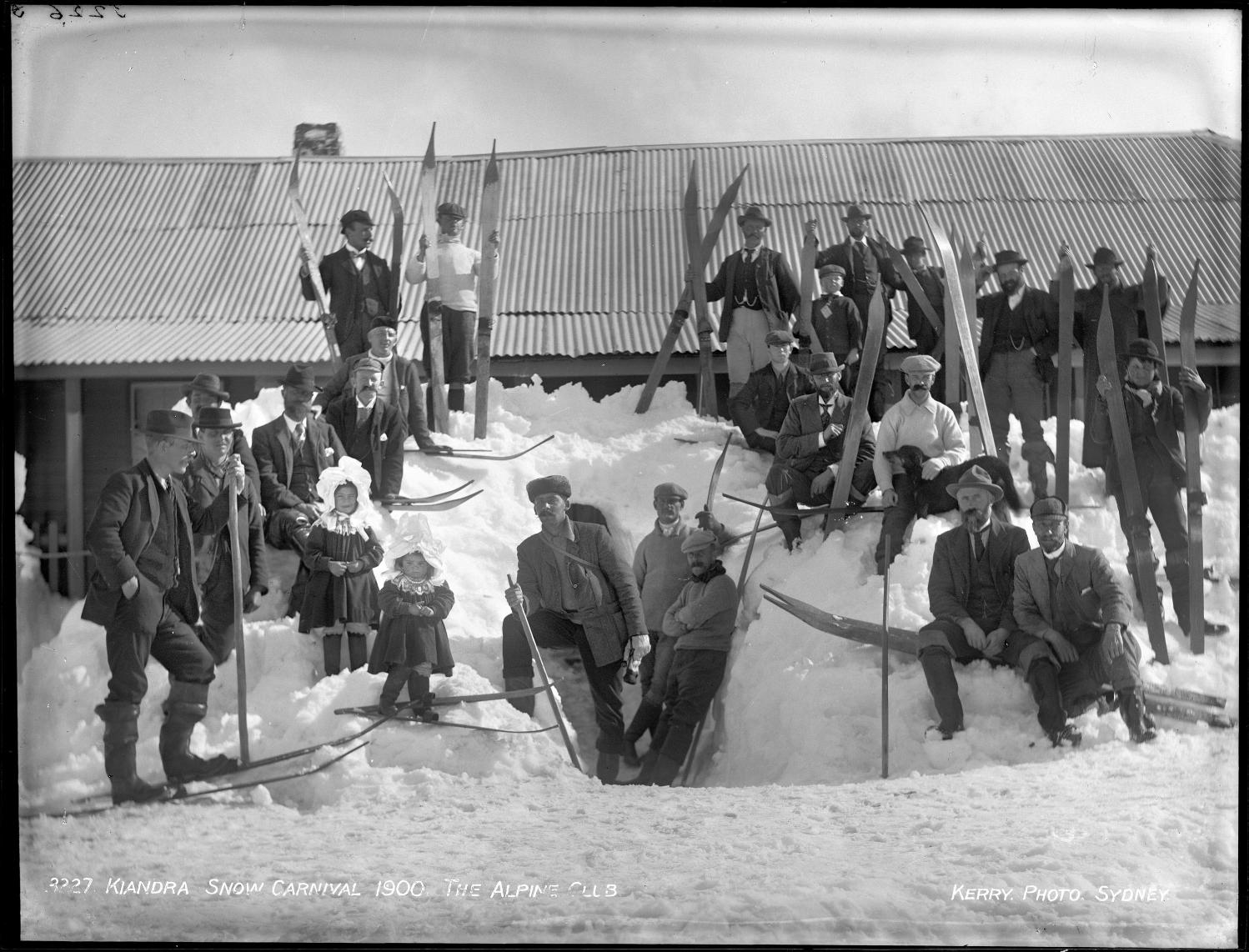
The Snow Season for 2022 opened over the June long weekend, with heavy falls signalling a great Snow Season ahead for those who like to head south to the New South Wales snowfields.
With the school holidays for Winter commencing those heading to the snowfields may be interested in some local connections to these actually coming about as a sport and as resorts for people to be ‘on the fields’. One is a gentleman who had a weekender at Careel Bay, another is connected with the beginnings of Surf Life Saving and lived at Manly, while a third frequented Palm Beach during the opposite weather side of each year - glorious Summer - and another is associated with some of our early photographers of Pittwater scenes as well as the beginnings of skiing in Australia, while yet another has connection to Bilgola and the beginnings of radio in Australia.
We focus on three of these people - Charles Kerry, Percy Hunter and Herbert Schlink, and share some of their insights from the beginning of skiing as a recreation and sport in Australia, along with a few insights into these gentlemen themselves. Their work and passion for the snow and what was then known as 'snow-shoeing' opened up the possibility of what is today enjoyed by so many, and they were known as the 'fathers of skiing in Australia' by their peers.
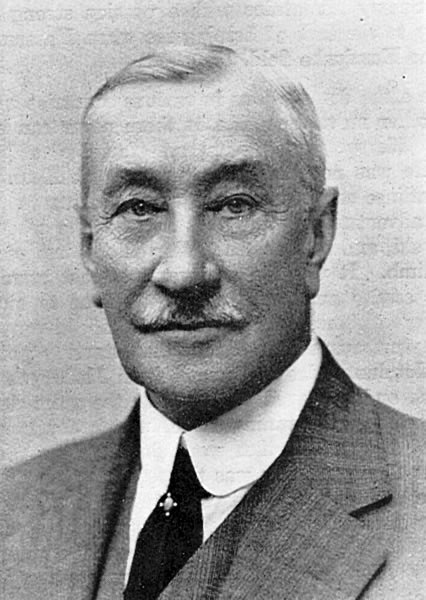 Charles Henry Kerry (April 3 1857 – May 26 1928) was an Australian photographer noted for his photographs that contributed to the development of the Australian national psyche and romance of the bush. Mr. Kerry was born on Bobundra Station in the Monaro region of New South Wales, the son of Samuel Kerry, commissioner's orderly and later grazier from Derbyshire, England, and his native-born wife Margaret, née Blay.
Charles Henry Kerry (April 3 1857 – May 26 1928) was an Australian photographer noted for his photographs that contributed to the development of the Australian national psyche and romance of the bush. Mr. Kerry was born on Bobundra Station in the Monaro region of New South Wales, the son of Samuel Kerry, commissioner's orderly and later grazier from Derbyshire, England, and his native-born wife Margaret, née Blay.
He began working in the Sydney photo studio of A.H. Lamartiniere in 1875. When Lamartiniere fled from creditors a few years later, Kerry took charge of the company, paying debts and turning around the business. By 1884, Kerry had taken over the business and had his studio at 308 George Street, Sydney. In 1890 he was appointed official photographer to the Governor of New South Wales, Lord Carrington.
Initially Kerry specialised in portraits but branched into photographing Sydney scenery and society. He was also active in the postcard business from 1903. Eventually Kerry turned this small studio into Australia's largest photographic establishment.
Readers will have seen his captures of our area in The Cowan ‘Creek’ + Lovett Bay Heights Tracks: Some Notes From The Pages Of The Past With Early Photos as well as other History pages and recall he was director of the 'Motor Company' which first tried to alleviate the problems George Brock was having in getting people to The Oaks after the tram build to Pittwater was delayed and eventually ceased at Narrabeen. The papers of the past provide from 1906:
MOTOR OMNIBUSES. THE MANLY-PITTWATER, SERVICE. INAUGURAL RUN.
The two motor buses recently imported from England for the service between Manly, Rocklily, Bayview, Newport, and Pittwater, made their initial trial on Thursday afternoon last. The run was to the residence of Mr. Brock, of Newport, and return to Manly, a distance of 23 miles. The 'buses, which were imported to the order of Messrs. Reid Bros., of Manly, are likely to be handled by a company, known as the Manly-Pittwater Motor Omnibus Company, Limited, with a capital of £8500. It Is the intention of the company to shortly Import a number of similar vehicles, as well as some steam 'buses, to tap the various populated districts at present badly supplied with tram or horse 'bus service. Manly was en fête for the occasion on Thursday, and a big crowd assembled at the Pier Hold to witness the start, which took place at 2.20 p.m.
Amongst those who took part in the trial were Mr. Dugald Thomson, M.P., Dr. Arthur, M.L.A., Mr. F. F. H. McKenzie, M.L.A., Alderman Quirk (Mayor of Manly), Alderman Walker, Alderman T. J. West, Alderman Lear Bioiinth, Alderman Ogilby, Messrs, S. L. Ridge, Charles H. Kerry (director of the Motor Company), E. E. Kennedy (secretary to the company). E. A. Laurence (of Laurence and Laurence, solicitors to the company), John Bennett, Wm. M'Leod, Daniel Farrell, H. T. Roby George Rodda (of Adams and Co.), Alexander Edward (secretary to the. Traffic Commissioners), D. S. K. Millar (Bank of New South Wales), W. J. Bradley, and Mr. Houreaux.
As the buses left Manly for Newport with 16 passengers on board each vehicle there was much enthusiasm, and it was evident that the introduction of the latest form of propelled vehicle was highly appreciated by the residents. Flags were flying from various buildings and arches had been erected at various part's of the road. As the 'buses made their run towards Newport several other petrol vehicles escorted the now service. All were gaily decorated out of compliment to the new Motors. There is little doubt that with a good and quick service many people will soon make the trip. Considering that the buses were shod with solid tyres the run was very smooth throughout.
The first 'bus, with the "Herald" representative on board, reached Mr. Brock's residence at 3.9 p.m., having covered the 11 ¼ miles in 49 minutes. There had been no rushing in the journey, as it was the intention of the owners to allow the party to view the magnificent scenery en route. With the exception of a slight delay at Sheepstation Hill, owing to the fan belt slipping off the pulley, the run made by the first bus was a delightful one, and must be deemed very successful. Unfortunately, the second 'bus had not quite so good a journey, as the carburetor stopped up when near Sheepstation Hill, and a halt had to be made. It took the chauffeur a considerable time before the obstruction in the petrol feed tube was removed. The delay was most vexatious to Messrs. Reid, who had already accomplished several journeys without a stop. It was especially unfortunate that the stoppage should have occurred in the inaugural run, as such things often tend to dishearten enthusiasts. Considering that the buses are as yet practically new, and that they will not be In thorough working order until they have covered at least a couple of hundred miles, the speed and hill-climbing capabilities displayed during Thursday's run must be deemed excellent.
DESCRIPTION OF THE BUSES.
Each bus is fitted with a 22-h.p. Aster engine, 4-cylinder rod, and with the cylinders cast separately. The full power of the motor is got at 1000 revolutions, but the speed may, be brought down very low by the manipulation of the throttle. The engine Is supported In the chassis by two strong channelled steel stays running from one side to the other, thus keeping the motor firm and secure. Elseman high tension magneto with synchronised Ignition is fitted, the accumulator and coil supplied extra being carried as a standby. Each of the four cylinders Is run from one coil by means of a distributor, and the switch fitted on the dashboard enables the chauffeur to turn on or off either Ignition at will. The manipulator of the spark and throttle Is of the latest type, being attached to the steering wheel, so as to allow the driver easy control. The change speed gears being at the driver's right hand allow easy management. As regards the chassis, It Is made of pressed steel, of U section, and narrowed In front, so as to allow a bigger wheel look. The length of the frame is 15ft 7in, and the width 4ft 9in, while the wheel base Is approximately 11ft the latter width being practically that of an Australian waggon track. The weight of the respective models turns out to be a little more than expected for a single-decker, totalling altogether 2 tons 5cwt for chassis and body. There is little doubt that the wood work In the motors is substantial, but had a little less solidity been supplied they might have been bettor. The artillery wheels fitted to the 'buses are strong, and, having solid forged axles, there is little likelihood of any injury to them. The drive is by chain, a stout 3in block chain being fitted on each side. The chain may be tightened when required by means of a substantial radiating rod. The springs of the vehicle,, though apparently strong, proved on the running to be just a trifle weak for the Manly-Newport road, and one could often experience at certain places slight Jars. It would certainly be advisable to have an extra leaf or two of spring put on.
Each 'bus is fitted with three speeds and reverse. Between the differential and the gear box is a strong coupling shaft with two flexible joints. The Panhard system of gearing with direct drive on the top is employed, and the estimated greatest speed is about '20-25 miles an hour. ' As regards the water circulation, this is supplied by means of a powerful pump. Tubular radiators and a large fan driven by bolt off the shaft help to keep cool the engine. The brake work on each chassis is of the external band type. Although for heavy vehicles the Internal expanding system of braking Is to be preferred, those on the new 'buses seemed very effective, and were able to pull up the latter quickly when descending some stiff gradients. The tyres, which are solid, were turned out by the Dunlop Company. It is a pity the company who purpose running the buses did not see their way to fit twin tyres on the rear wheels, as the wearing qualities of the latter are superior, and there is loss likelihood on the part of the vehicles to skid.
As regards the body part of the respective Cars, the design and finish seem simple, yet neat. In each 'bus there are four cross seats, each vehicle being capable of accommodating about 16 to 18 passengers. A very desirable feature about the seats Is that each of the four rows Is placed on a different level,
the back one being the highest. This arrangement enables each back row of passengers to have an equally good view with those In front. There is a canopy, with convex roof, fitted to each car, and supported by tubular Pillars. To protect the driver or passengers in dusty or rainy weather, two folding glass
panels can be lowered, as can the folding side blind. The finish of the vehicles is In excellent taste, the cars being upholstered In dark green leather. The woodwork Is painted dark chocolate with yellow lines on one model and dark green with light lines on the other. A luggage carrier is fitted on the top of the
canopy.
SUCCESS OF THE SERVICE ASSURED.
When the buses reached Mr. Brock's residence refreshments were served, after which some photographs of the new vehicles with the passengers aboard were taken. Mr. Quirk, Mayor of Manly, occupied the chair, in the course of his remarks he said that every credit was due to Messrs. Reid for having had the courage to Import motor 'buses.
Mr. Dugald Thomson, M.P., proposed success to the new venture, and eulogised the Importers as men of enterprise, who had surmounted great difficulties. He hoped soon to see a regular service of 'buses running between Manly and Pittwater, and trusted the venture would meet with the success It deserved.
Dr. Arthur, M.L.A., in supporting the toast, said he was a humble admirer of anything In the shape of enterprise. He thought the Manly-Pittwater buses would be a decided acquisition to the neighbourhood. He characterised Pittwater and the surrounding neighbourhood as one of the loveliest districts in this State, and hoped the present buses would be compared favourably with those at present in Sydney, would always be kept busy.
Mr. M'Kenzie, M.L.A., also spoke, and pointed out the necessity that existed for proper communication, between Manly, Newport, and district. He had no doubt that in a short time many more similar buses would be in use.
Mr. Cried responded and spoke of the initial difficulties in inaugurating the service. He was perfectly satisfied that once the novelty had worn off the present buses they would successfully cater for the demands of the Manly and Pittwater residents.
MOTOR OMNIBUSES. (1906, February 10). The Sydney Morning Herald (NSW : 1842 - 1954), p. 17. Retrieved from http://nla.gov.au/nla.news-article14732737
George Brock lost his big dream of The Oaks during the next year, creditors selling the property.
On January 20th 1897 Charles Kerry married Delphine Hilda Vivian:
KERRY - VIVIAN On Wednesday, January 20th, Miss Delphine Vivian, only daughter of Mr. Vivian, council clerk, Woollahra, was married to Mr. C. H. Kerry, at St. Mark's, Darling Point, the Rev. Canon Kemmis performing the ceremony, only the immediate friends of the bride and bridegroom being present. The bride wore a becoming walking dress of white muslin and a large white hat, her bridesmaid, Miss M. Bradridge, also wearing white muslin, with a folded belt of heliotrope, the same colour in her hat. For their honeymoon Mr. and Mrs. Kerry are touring in the Southern district. Weddings. (1897, February 6). The Sydney Mail and New South Wales Advertiser (NSW : 1871 - 1912), p. 295. Retrieved from http://nla.gov.au/nla.news-article163792050
The couple had only child, a son, Geoffrey Eudra Marni Kerry (1901 - 1974) was an early Australian aviator and friend of Charles Kingsford Smith.
He employed professional photographers and after 1895 took fewer photographs himself. He left the firm in 1911 to concentrate on his mining interests. Over 8,000 glass negatives from his studio (including some negatives by Henry King which had been purchased by Kerry) were acquired in 1930 by Tyrrell's Bookshop, and this collection was purchased by Australian Consolidated Press in 1980 and donated to the Powerhouse Museum. Many of these were made freely available in the Commons on Flickr by the Powerhouse Museum in 2008. There is also a large collection of his photographs stored with the State Library of New South Wales, many freely available through their digitised program.
Charles Kerry first visited Kiandra in 1894 to pursue his mining interests, he returned in 1896 on a photographic tour. The following year with practically no skiing experience he was assisted by a group including Kiandra ski club members on an historic photography tour to the summit of Mount Kosciuszko. In 1909 he was elected Founding President of the Kosciusko Alpine Club, which led to the opening up of the area for skiing and the naming of a run after him.
Kiandra is considered by many to be the birth place of skiing in Australia. In or before 1861 the Kiandra Snow Shoe Club was founded in the gold-mining district of Kiandra, New South Wales by three Norwegian and reportedly became the "world's longest continuously running ski club" as it evolved into the present-day Kiandra Pioneer Ski Club in Perisher Valley.
Kiandra is an abandoned gold mining town situated in the Snowy Mountains of New South Wales, and now inside the Kosciuszko National Park. Its name is a corruption of Aboriginal 'Gianderra' for 'sharp stones for knives'. It was earlier called Gibson's Plains, named after Dr. Gibson, a settler in the district in 1839. For a century (until the establishment of Cabramurra), Kiandra was Australia's highest town.
In November 1859, gold was discovered by mountain cattlemen, the Pollock brothers, and by March 1860, some 10,000 miners and storekeepers had raced to the scene.
THE NEWS OF THE DAY.
The continuous migration to Snowy River, in spite of the approaching winter, and the gloomy pictures of snow and starvation that have been sketched, is another proof of the state of the country. It reflects little to our credit that the mining population are so in-tensely unsettled that they are willing to face any threatened privation, where there is at the same time a prospect of doing better than in Victoria. The exodus to Port Curtis ought to have been a lesson to our legislators, but, although there was uncertainty there as there is here, there was never that positive danger and deprivation which are attached to a wintering among the ranges of the Snowy River district. And still multitudes are wending their way thitherward. Miners are flocking there from all parts ; two large waggons with about fifty persons left Queen street for Snowy River yesterday ; and the departures from the Ovens district constitute a continuous stream of emigration. Several coaches have been put on the road between Chiltern and Kiandra, and they are always well filled. Females have not hesitated to risk the difficulties of the country, and in every way the Snowy River Gold-field is proving a new warning of the necessity, if even we would keep the population we have got, of rendering Victoria rather more attractive than it is at present. THE NEWS OF THE DAY. (1860, April 11). The Age (Melbourne, Vic. : 1854 - 1954), p. 5. Retrieved from http://nla.gov.au/nla.news-article154841436
KIANDRA.
( From the Sydney Empire.)
Kiandra, July 1st. — During the early part of this week the weather was unusually cold and wet, and much sickness prevailed over the whole diggings. One or two deaths have occurred from. dysentery, and numbers are suffering severely from influenza. The weather is now frosty, but exceedingly severe. Numbers of miners who have recently arrived are unable to work or obtain employment. Building operations are nearly suspended, partly in consequence of the rainy weather, but principally from the want of teams to draw in the timber, £10 per day being asked for bullock teams. The usual charge is now 20s. per hundred feet from the swamp, from two to three miles distant ; but those building offer 25 shillings, and in some instances even more. The usual earnings of carpenters is £5 per week. The place is completely unprepared for any large in-flux of population. The land sales at Russell's went off well, the lots all realising high prices. The general impression appears to be that "New Providence" will prove a good township, but that Russell's will be a failure. Numbers attended from Sydney, Braidwood, and other parts— amount of land sold 12 acres for £1700. We have now a bi-weekly post arriving from Cooma on Wednesday, at noon, and leaving on Friday at noon, another via Tumut, arriving on Saturday, at noon, and leaving on Sunday at noon. The most convenient time for a digging population is decidedly an arrival on Saturday at noon and departure on Monday morning or noon, Sunday being the day which is most convenient for writing. The mail via Tumut could be easily delayed until Monday. We have had a new rush in the direction of Lob's hole, which promises well. Several very rich quartz-reefs have been discovered, and some very rich specimens obtained and sold, but the exact position is kept private— they are supposed to be seven or eight miles distant. Some lodes of copper ore, running over several miles, 15 feet thickness, have been recently attracting much attention, and it is currently reported that coal exists in the immediate locality, so that the ore could be smelted. Several specimens produced appeared remarkably rich and were stated to contain 75 per cent. of copper. Application has been made to the Government for permission to work these mines. Mr. Garrett, of Wollongong, is making arrangements for the publication of the first paper on the Snowy River to be called the Alpine Pioneer, to be issued bi-weekly. Prospectuses of several others have been already issued. The diggings are perfectly quiet. All provisions lower, and more plentiful. KIANDRA. (1860, July 14). The Age (Melbourne, Vic. : 1854 - 1954), p. 5. Retrieved from http://nla.gov.au/nla.news-article154844027
Initial returns were very good. A 9 kg nugget was discovered in river deposits under what became known as New Chum Hill. Kiandra post office opened on June 1st 1860 and it is estimated that the area at its peak accommodated around 15,000 people, served by 25 stores, 13 bakers, 16 butchers, 14 pubs, several banks and four blacksmiths. By 1861 the Sydney Morning Herald was reporting a ''Great exodus from Kiandra ... nearly all gone to Lambing Flat" - the easy pickings were exhausted and the population dropped to around 300 people.
In 1861, Norwegian miners introduced recreational skiing to the snowbound mining settlement after manufacturing over forty pairs of both short skis, known as "skates". and the longer "snow shoes" during the months before the first winter snow. To avoid confusion with a conventional skate, the skates were described as (two palings turned up at the front end and about four foot long).
The Kiandra Snow Shoe Club was established around 1870. According to one source, Jens Olsen from Tjølling, Norway, gave up gold digging and instead set up a ski manufacturing workshop, the first such factory in Australia. Another states Jens Olsen was one of the founders of the Kiandra Snow Shoe Club. There were championships held for cross-country skiing and ski jumping, starting in 1878, although clearly races had been held prior to that, from the 1860's on.
Kiandra is a rather dreary place in the winter, but yet the people are not without amusements. The heaven pointing snow clad mountains afford them some pleasure. Scores of young people are frequently engaged climbing the lofty summits with snow shoes, and then sliding down with a volancy that would do credit to some of our railway trains .... COUNTRY NEWS. (1861, August 6). The Sydney Morning Herald (NSW : 1842 - 1954), p. 2. Retrieved from http://nla.gov.au/nla.news-article13064234
Ski races were held annually on Township Hill at Kiandra. A variety of cultural backgrounds were represented in the ski competitions at Kiandra. The Manaro Mercury of August 10, 1887 mentions a little girl and a lady of Chinese descent, both winning races in their category. Chinese names appear again among the winners in 1894. One hsitroian reports that skiers at Kiandra used wax made from oil, rubber or fat to increase downhill speed—methods that may have been introduced from California. Skis used at Kiandra were not suited for turning, so downhill races were in a straight line only.
In 1908 the club reportedly held an "International Ski Carnival"—including an "International Downhill Race", which was won by an American, competing on skis made in Kiandra; other events included races for youths in categories of under eight, ten, eleven and fourteen years of age. "Open Championships" were also conducted; the events concluded with a "New Chum" event and toboggan race. Competitions continued at least until 1911, despite a decline in gold mining.
The Kiandra Snow Shoe Club evolved in 1929 into the present-day Kiandra Pioneer Ski Club in Perisher Valley. At one time, the poet Banjo Paterson was a vice president. The Club held perhaps the first international ski race carnival in 1908.
Snow Shoe Races.—Kiandra is going to have races in snow shoes. There are to be six races, and money is coming in rapidly for the prizes, says the Monaro Mercury. NEWS AND NOTES. (1882, July 5). The Bega Gazette and Eden District or Southern Coast Advertiser (NSW : 1865 - 1899), p. 2. Retrieved from http://nla.gov.au/nla.news-article110310626
SNOW-SHOE RACES.
KIANDRA, Saturday.
The annual snow-shoe races were held here to-day, and were witnessed by 200 spectators. The undertaking was an immense success. The champion race was won by F. Yan, J. Creer second. Distance, 13 chains. Time, 16 seconds. SNOW-SHOE RACES. (1896, August 3). The Sydney Morning Herald (NSW : 1842 - 1954), p. 5. Retrieved from http://nla.gov.au/nla.news-article14061180
KIANDRA NEWS.
(From our Correspondent.)
At the final meeting of the Kiandra Snow Shoe Club held in the Committee Rooms, School of Arts, Kiandra, Mr. Geo. Irwin, the hon. treasurer, and joint hon. secretary with Mr. A. Grieves, was presented with a handsome gold medal with a suitable engraving as a mark of esteem in which that gentleman is held. At the presentation Mr. W. Gillespie made a flattering speech and his words were supplemented by remarks from Messrs Jas. Eastwood, J. M. Scott and F. Weselman. A short resume of that club's doings may not be out of place during the three seasons in which Mr. Irwin bas been connected with it ; in 1895 the club worked on £11 5s with one trophy, and had £1 1s as a balance; for 1896, with the sum of £19 14s, with three trophies, and had £2 7s as a credit. In 1898 it had the sum of £20 6s with 20 trophies, which were run for, and a credit balance of £3 8s 1d is now in hand. The entrance for the different races show a still larger increase — 42, 68, and 147 for the three respective seasons. Since the races the weather has been delightful, glistening white snow about two feet on the average, cold, calm, frosty nights, with a mid-day temperature ranging between forty and forty-five degrees. KIANDRA NEWS. (1898, August 19). The Manaro Mercury, and Cooma and Bombala Advertiser (NSW : 1862 - 1931), p. 5. Retrieved from http://nla.gov.au/nla.news-article119026009
KIANDRA SNOW-SHOE CLUB
KIANDRA, Tuesday.— The annual meeting of ,the Snow-shoe Club was held in the School of Arts on Saturday, to elect officers for the ensuing year. It was proposed to ask his Excellency Lord Beauchamp to be patron of the only snow-shoe club in Australia. The following officers were elected: President, Mr. Pattinson, J.P.; vice-presidents, Sir W. Lyne, Hon. J. L. Fegan, G. T. C. Miller, Ms.L.A., Messrs. David Marks, E. Seaborn Marks; secretaries, Messrs. G. Irwin and J. W. Attwood; treasurer, Mr. H. E. Quick; and a committee of nine. KIANDRA SNOW-SHOE CLUB (1900, June 27). Evening News (Sydney, NSW : 1869 - 1931), p. 6. Retrieved from http://nla.gov.au/nla.news-article113719728
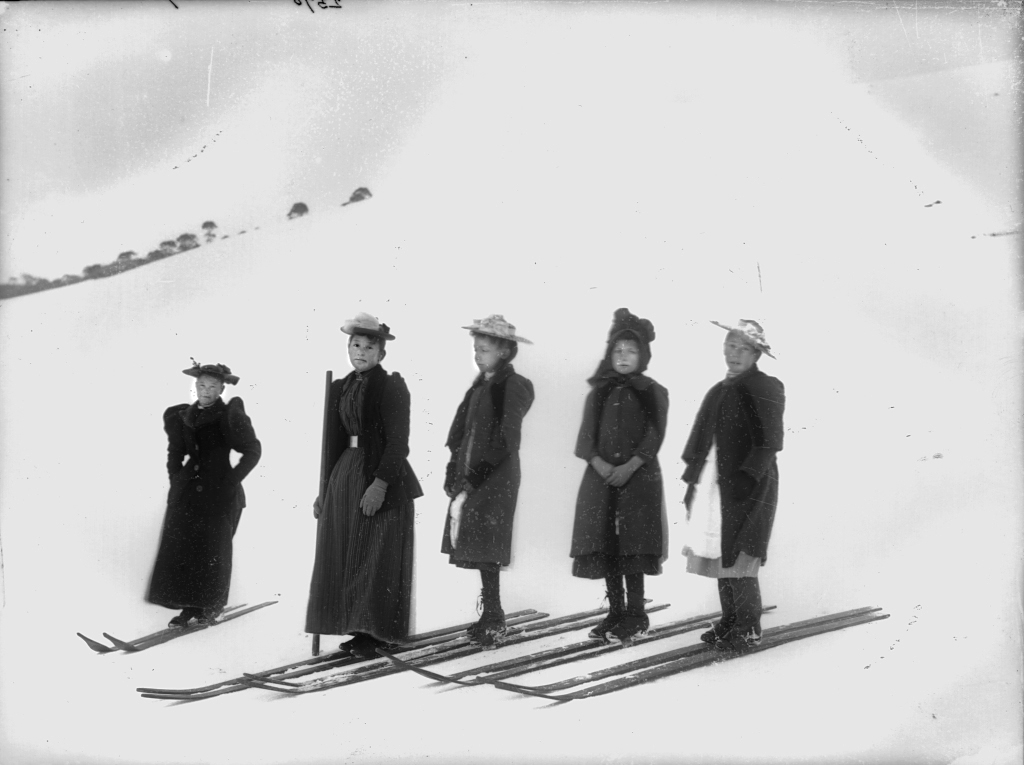
The start of girls' snowshoe race, Kiandra, circa 1900. Photo by Charles Kerry
Charles Kerry's earliest known Kiandra photos were taken in 1895 and he personally guided groups of visitors to Kiandra every winter. One report from then states:
THROUGH THE AUSTRALIAN ALPS.
A TRIP ON SNOW SHOES.
A representative of "The Daily Telegraph" yesterday waited upon Mr. Charles Kerry, of the firm of Kerry and Co., with reference to a tour on snow shoes by that gentleman through the Australian Alps. Mr. Kerry only returned from his trip, which was of a fortnight's duration, yesterday morning. He undertook the trip chiefly with a view to securing some photographic representations of the rugged and beautiful scenery that the Boogong and other southern ranges of New South Wales afford when clad in the robes of winter. After leaving Cooma, he proceeded to Jindabyne, which is situated on the Snowy River, being accompanied by a friend and two miners, whom he had secured to act as his guides. From Jindabyne, he journeyed to the Hanging Rock and Boogong Ranges, via Kalkiti Mountains and the Snowy Plains. Upon reaching the Boogong Range, the snow was so thick that it was only with the greatest difficulty that the miners were enabled to find a hut which they wore In search of, it being almost completely buried in the snow. Having tunnelled their way into the hut, Mr. Kerry turned his attention to securing photo-graphs of various places of interest in the neighborhood, and succeeded in obtaining several magnificent views. The temperature here was far below freezing point, and, except, perhaps, be tween 12 and 2 o'clock, it was never above that point, they being nearly 5000ft. above sea level. Among many other interesting things, Mr. Kerry obtained a collection of views showing the effect of the frost on the ice In such a degree of cold, the temperature at the time of obtaining the negatives being 40 degrees below freezing point. The frost stands about 2in. in height, sprouting out in small jet-like rays, and presents a peculiar and unique appearance. These negatives he took specially to show to the Government Astronomer.
After some time spent In the vicinity of these ranges, Mr. Kerry retraced his steps to Jindabyne, from which place he went by coach to Adaminaby, en route to Kiandra, keeping on the edge of the mountains all the way across. When eight miles from Kiandra, he was obliged to traverse the remaining distance on snow shoes, having been met by some 13 inhabitants of that town ship, which is situated in what is believed to be the coldest part of the colony. At Kiandra, where he was very hospitably treated, the snow was as high as the window-sills of the houses, but that was a mere nothing in the eyes of the Kiandra-ites, who informed him that last year It was almost on a level with the eaves of the houses. The temperature at Kiandra during his sojourn there was 14 degrees below zero, though in July of last year, he was told it was three degrees lower. No animals, save a few pigs and goats, can subsist there in winter, and In consequence the townspeople have to lay up a five or six months supply of provisions in the summer time, when the average temperature is about 55deg., the highest registered for 34 years being 84deg., which was in January of last year, during the heat wave which passed over the colony at that time.
As bearing out the statement with regard to the frost, Mr. Kerry says that in Kiandra the telegraph wire is covered with it so thickly that the circle thus formed measures some 4in. in diameter, and presents a fantastic appearance. Everybody, from the little toddling infant to the men and women, are to be seen on snow shoes, which range from about 3ft. 6in to 8ft. in length. On leaving Kiandra Mr. Kerry was presented with a pair of shoes, made In the latest Norwegian fashion, which the winner of the championship stakes recently used at the annual races held at Kiandra, and at which Mr. Kerry was present. With these shoes people travel at a surprising rapidity. They are about 3in. or 4in. wide, and leave a trail about an inch or so deep, which, however, in 10 minutes' time after being made, is completely filled up by the frost. Not withstanding the intense cold, the inhabitants of the district state that they would not exchange places with any other part of the colony. THROUGH THE AUSTRALIAN ALPS. (1896, August 6). The Daily Telegraph (Sydney, NSW : 1883 - 1930), p. 5. Retrieved from http://nla.gov.au/nla.news-article238605279
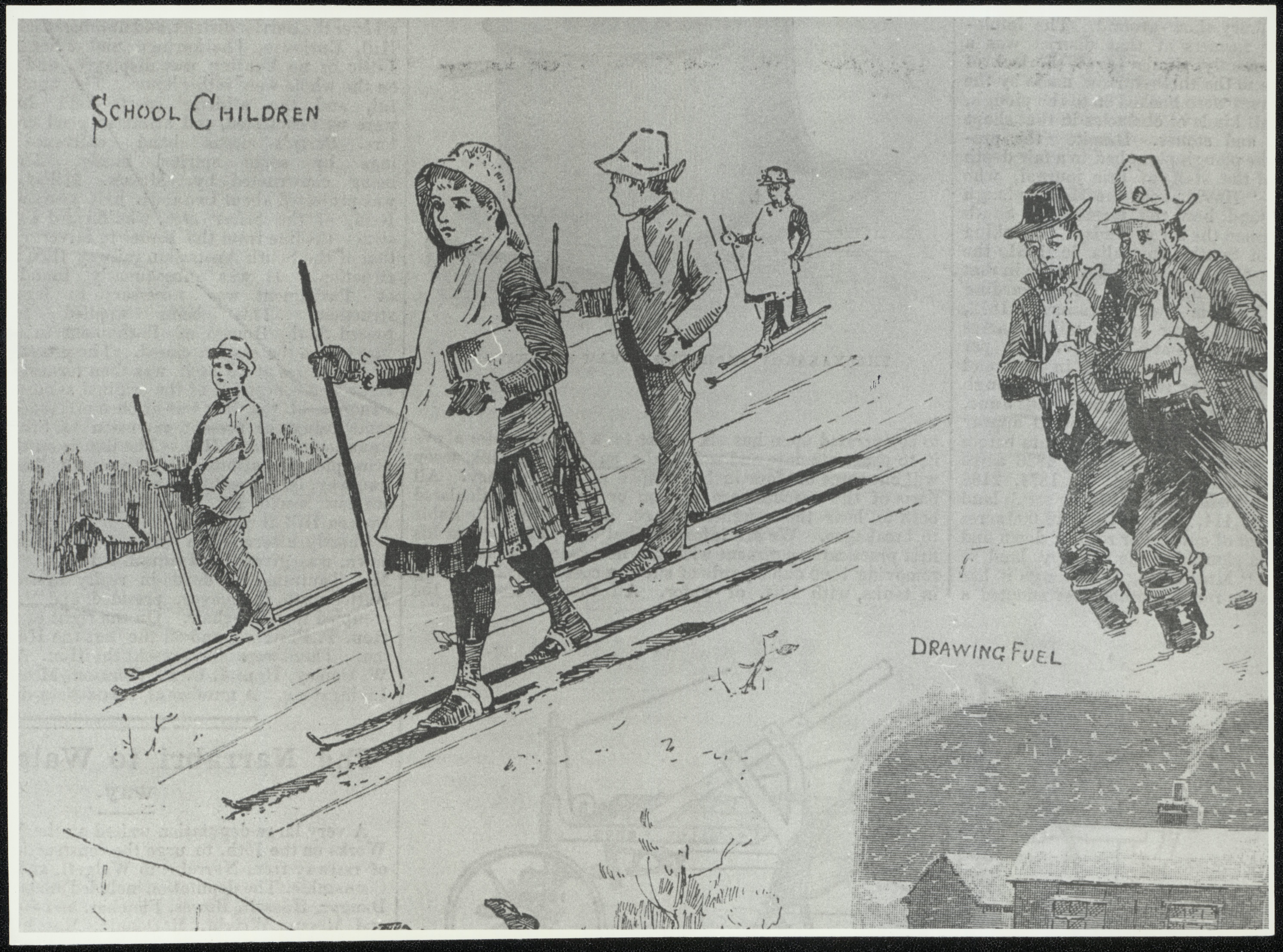
Kiandra Public School - snow shoeing at Kiandra - FL407093, courtesy NSW State Records and Archives
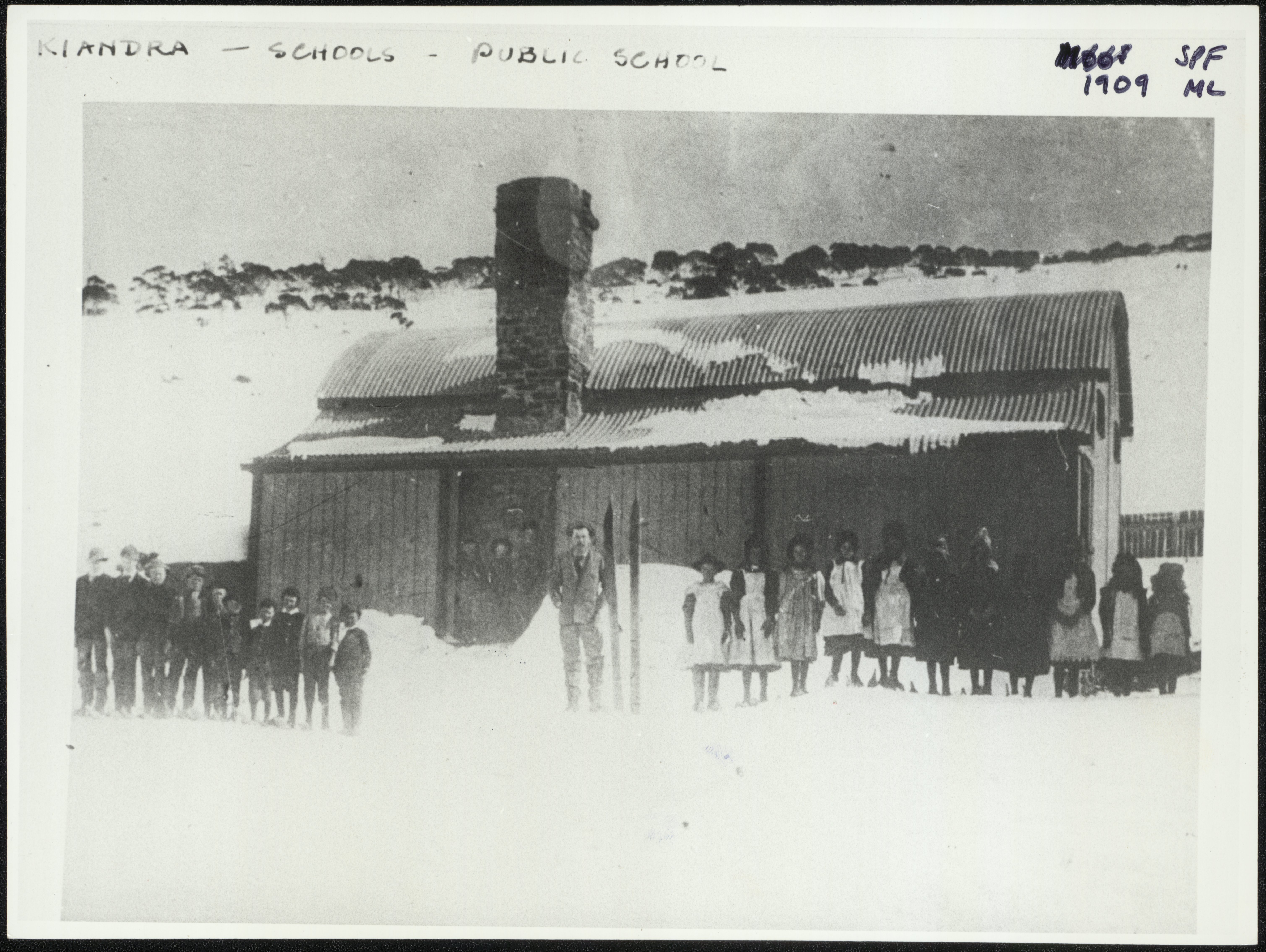
Kiandra Public School - [teacher and students] – 1909 - FL407029, courtesy NSW State Records and Archives
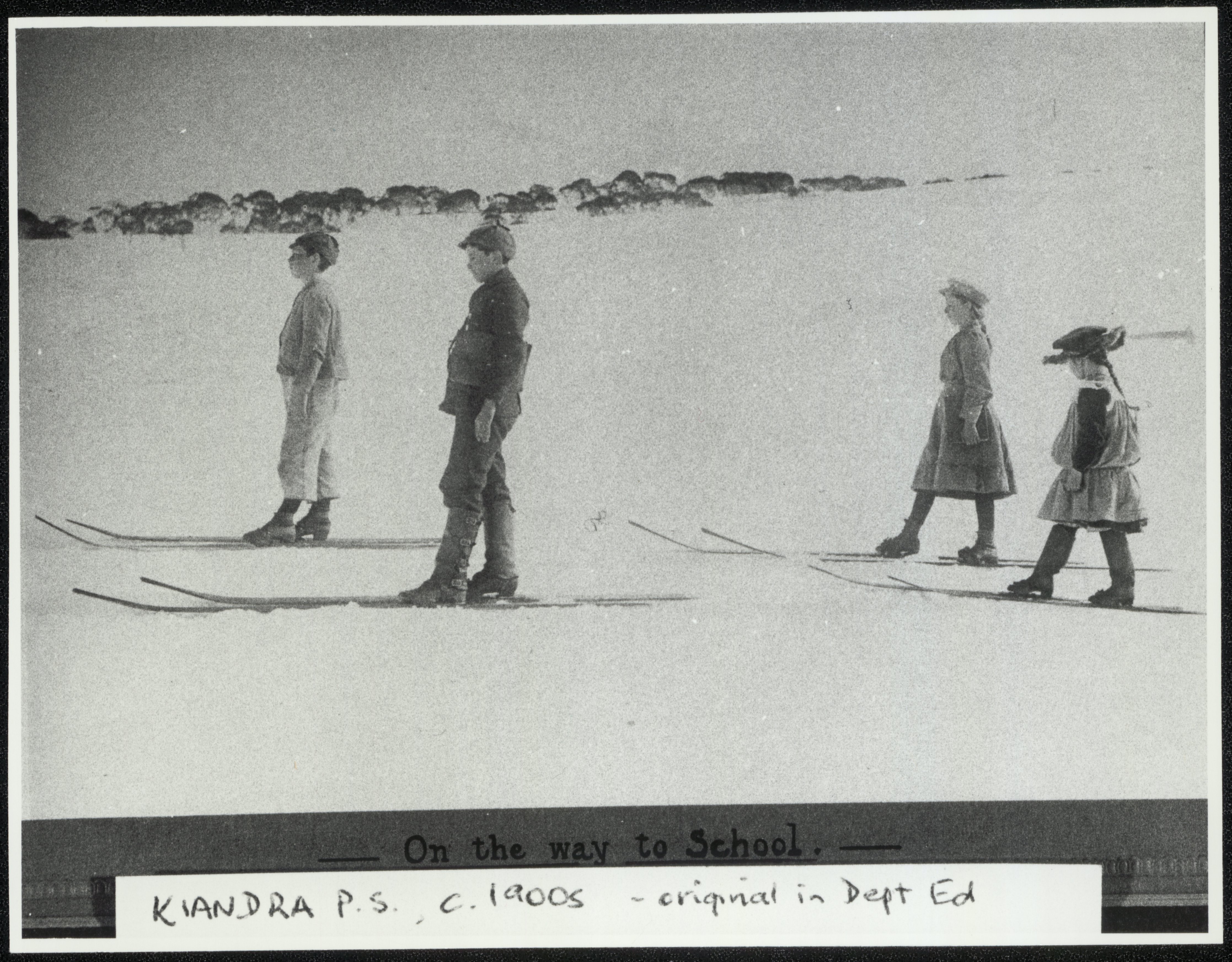
Kiandra Public School - On the way to school [children on skies] FL407049, courtesy NSW State Records and Archives
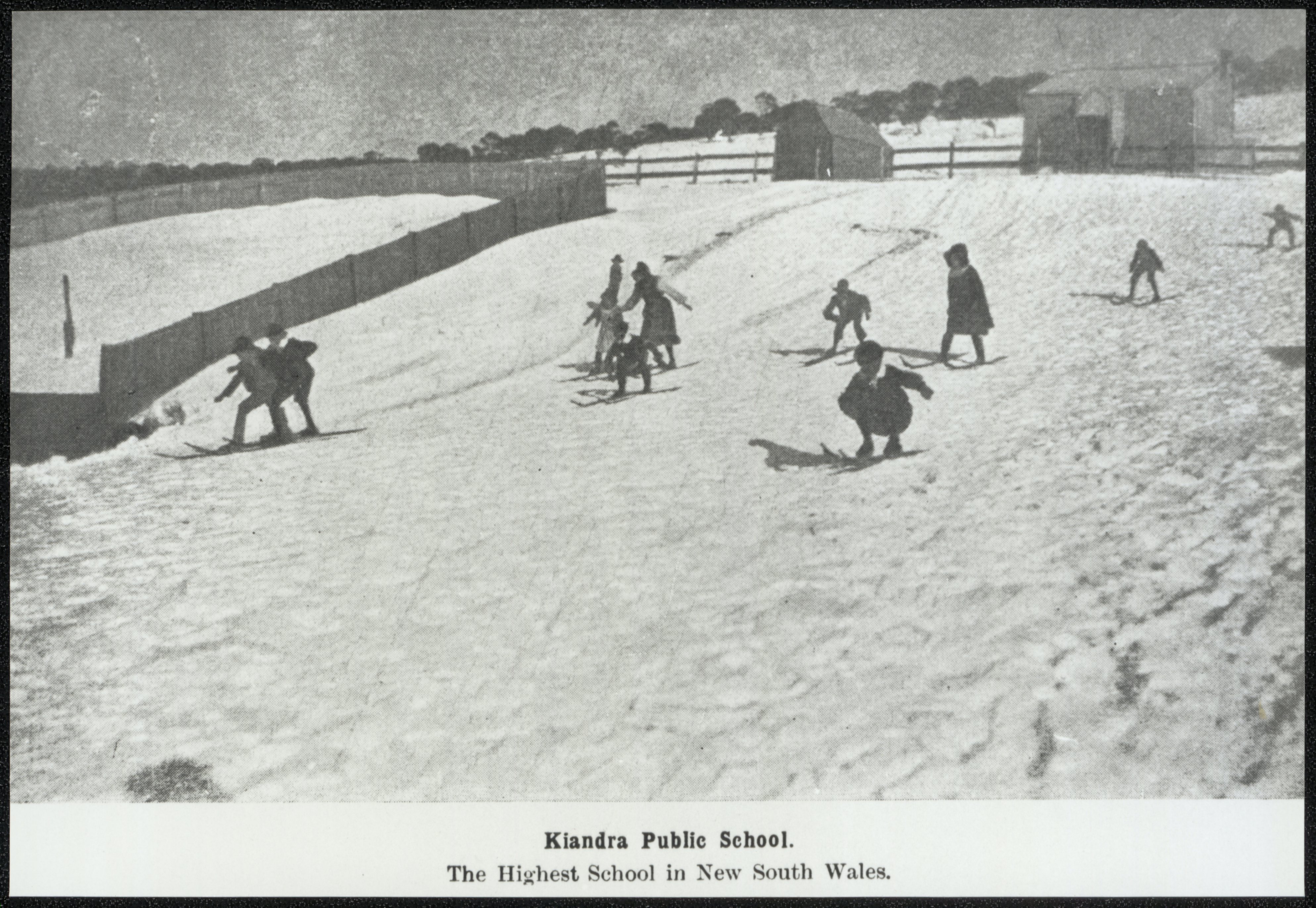
Kiandra Public School - The highest school in New South Wales FL406983, courtesy NSW State Records and Archives
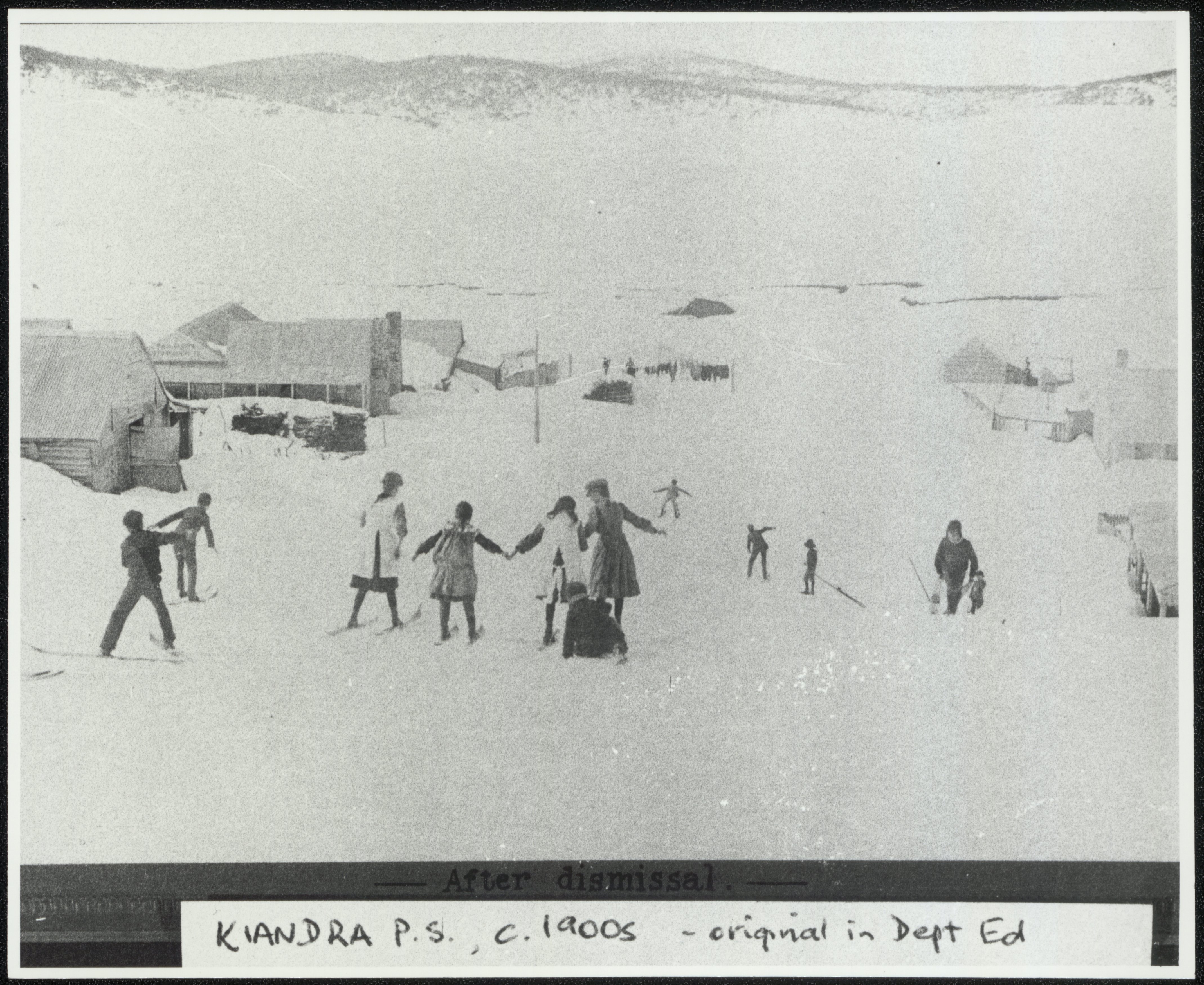
Kiandra Public School - After dismissal [children playing in snow] FL407077, courtesy NSW State Records and Archives
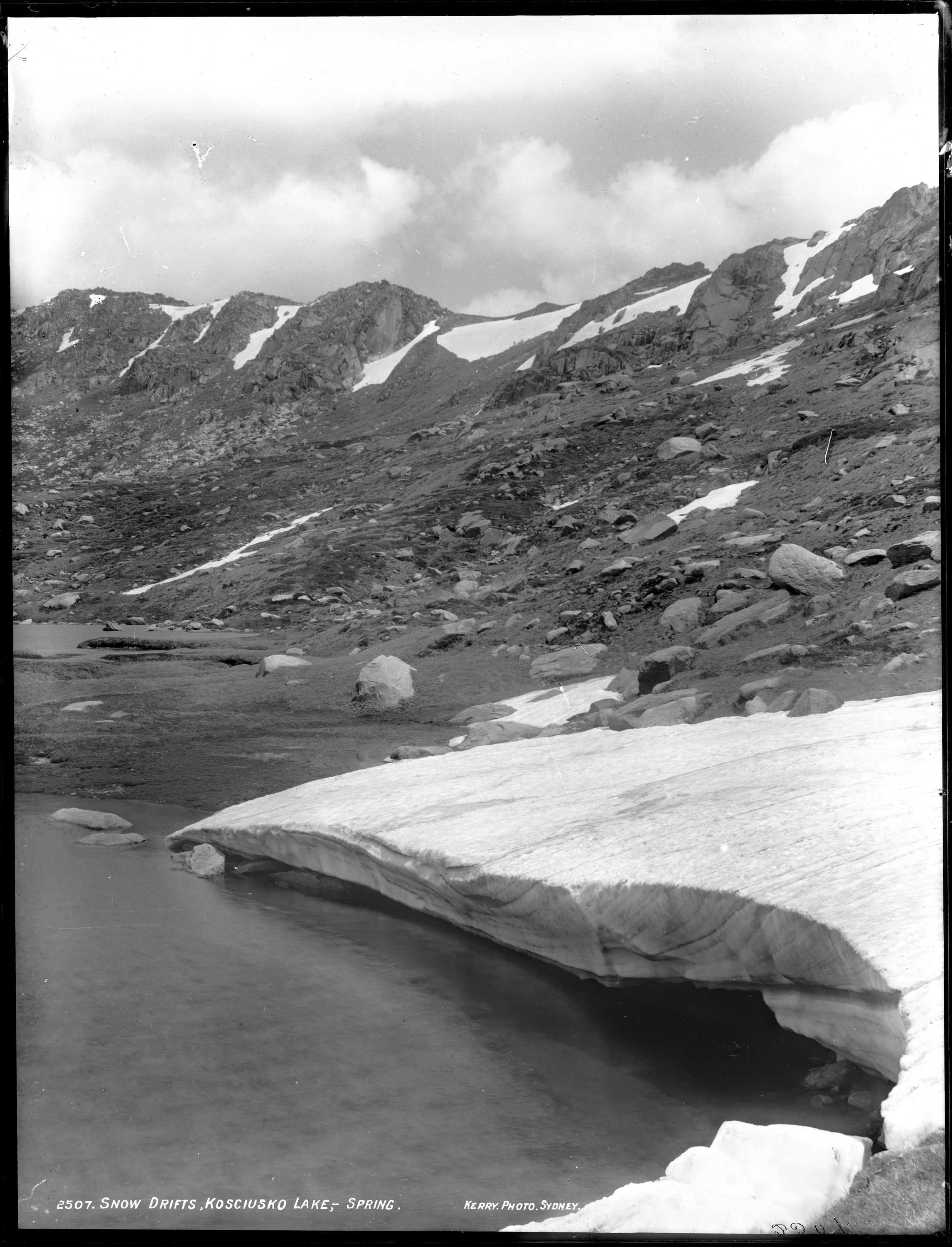
'Snow Drifts, Kosciuszko Lake, Spring' by Kerry and Co - courtesy Powerhouse Museum, Tyrell collection
Charles Kerry also played a leading role in the first winter ascent of Mt Kosciuszko and the establishment of Clement Wragge's weather station on the summit. This weather station operated continuously from the Spring of 1897 to 1901. One newspaper report reads:
MOUNT KOSCIUSKO.
THE FIRST WINTER ASCENT. AN IMMENSE SNOWDRIFT.
A party of Sydney gentlemen desirous of making the ascent of Mount Kosciusko during the winter season left Sydney on the 11th instant fully determined to accomplish the task, one recommending itself chiefly by reason of the difficulties to be overcome in a region where the snow is known to lie in immense drifts, which hitherto has attracted no excursionists in the depth of winter. The party, consisting of Messrs Kerry, E. A. Holden, B. Barnett, and J. Wyatt proceeded by train to Cooma, where they arrived the following day. They then proceeded to Jindabyne, which journey was pro-longed greatly beyond its usual limit, two days being lost through a heavy fog enveloping the neighbourhood through winch they passed. However Jindabyne was reached on Monday, the 16th instant, where the party was augmented by Messrs Laurence Clifford, A. Brook (manager of Jindabyne Station), McAllister, Kennedy, Willis, Stephenson, McKinnon, Trooper Stevenson, and Guides Boulton, son, and Spencer. Mr Clifford undertook the horsing of the party, and in addition provided five packhorses, thereby adding greatly to the assistance and convenience of the party.
No time was lost in making a start, as the cavalcade left the same day, in mild and beautiful weather no snow being visible. Proceeding along the valley of the Thredbo River, a distance of 25 miles was accomplished, when the party camped for the night Dunring the night a heavy fall of snow took place, and in the morning it was thought best to send out a reconnoitring party to report on the state of the valley higher up. Nothing of an unfavourable nature being met with the main body moved on, but were overtaken by a sudden blizzard of snow the temperature falling in an astonishing manner, rendering the progress anything but agreeable. So severe was the fall that in a period of two hours 20 inches of snow was recorded. Ten miles was the distance covered this day, and it was here determined to establish a camp as a basis of operations, which was accomplished under great difficulties the thermometer registering at sunset 18. The site of the camp was 35 miles from Jindibyne at an altitude 5,000ft.
The following day was spent in practising snow-shoeing, an accomplishment of novelty to the greater portion of the party; nevertheless sufficient progress was made that the following morning the final ascent was deemed practicable. For the first mile and a halt the party passed through heavy timber where snow-shoeing was impossible the distance taking something just under four hours to accomplish, the keenest of the excursionists being greatly exhausted. This portion of the journey was the most trying experienced during the trip. Snowshoes were then brought into requisition, and for five miles the passage was across immense snowdrifts entirely covering every sign of vegetation or granite outcrop Here no water was to be obtained and the thirst of the travellers was extreme, which was greatly aggravated by the involuntary habit of eating snow.
On reaching an altitude of 7000ft to the amazement of the guides the valley immediately below the ascent was found to be ualmost entirely filled by an lmmense snow drift, of the depth of which no estimate could be given, covering in a dazzling unbroken mantle the land, the waters of the Snowy River, and Lake Cootapatamba in fact entirely altering the physical features of the mountain. This, how-ever, enabled the party to pass on with comparative ease for a considerable distance until the point of the last ascent was reached. Here it was found necessary to abandon the snow shoes, and articles of clothing were likewise dispensed with.
Eventually the summt was reached by 12 of the travellers at 2 pm on the 19th instant, the first to reach the goal being guide J Boulton, who thus won the gold medal offered by Mr Burnett for the first man to reach the summit. As if in final consummation of the grandeur of the snowfields the cairn and survey mark which crown the mountain were found to be entirely buried in frozen snow, which had been blown by the winds into fantastical and stalactitic formations, presenting in the brilliant sunshine a dazzling picture never to be forgotten by the elated explorers .The view was described as being grand in the extreme, looking over 50 miles of un-broken snow on the Snow y Ranges then over the snow clad sister peaks of this district, and finally over towards Albury on the one hand and to Cooma on the other. ln the sun the temperature was 22 , there being only a differ-ence of 2 in the shade The mountain is supposed to be 7,000ft in height And the travellers claim to be the first party of excursionists who have attempted and accomplished its ascent during the winter months. Numerous photographs were taken by Mr Kerr which fully lllustrate the trip. After a stay of three-quarters of an hour the descent was commenced, and the camp reached in safety.
Messrs Kerry and Holden, at the invitation of Mr McAllister, proceeded to the Bogong on snow shoes, taking up quarters at the camp of some miners there. Snowshoe races were organised and some capital sport was furnished. A trophy offered the Sydney visitors for a race over 350 yards was won by J Bourke, who covered the distance in 22 seconds.
Ice skating was also indulged in by one of the party, and proved a novelty to the residents. The return, a distance of 37 miles, was accomplished in one day 12 miles being covered on snowshoes, and the remainder on horseback. Sydney was reached on Saturday last, the top being thoroughly enjoyed by the whole party, who have reason to be satisfied with their exploits. MOUNT KOSCIUSKO. (1897, August 30). The Sydney Morning Herald (NSW : 1842 - 1954), p. 6. Retrieved from http://nla.gov.au/nla.news-article14114821
MOUNT KOSCIUSKO OBSERVATORY.
(By Bernard Ingleby.)
October 6. — Although there are numerous evi- dences of the rapid approach of spring on Mount Kosciusko to the careful observer, ,it is to be doubted whether the casual visitor would not be rather dubious were he told such was the case, for now, as in the very depths of winter, the mountains around are clad from base to summit in an unsullied garment of the purest snow, which, however, has but lately fallen, and will prove as transient as it is white. Prior to this last snowstorm, the heralds of spring-were both many and various, as great massive granite boulders had everywhere lifted their weatherbeaten shoulders from out the winter covering, their rugged outlines standing out in bold relief against the snowy background, whilst even in places it was possible for one to see the bare ground, though the word bare is hardly applicable, for the shrubs of summer garb the mountains as of yore, and in the winter season suffer no damage from the freezing temperatures and boreal blasts — thanks to the kindly arrangements of mother Nature in providing them with the soft nivian sheets as protection against the inclemency of the elements.
After the advent of one of those cyclones so loved by Mr. Wragge, and upon whom he confers, as he himself states, "such soft, melodious, soothing South Sea Island names," we observers have to turn out in sheepskins, etc., and shovel the snow away with a will from out the tunnel and other places where its presence is an inconvenience, but an hour or so at this employment soon finds oneself disrobed of all antarctic garments, the warm glow which the exercise engenders making such as unnecessary as they would be be neath the burning heat of a tropical sun. Some few days ago I made a journey over the mountains with the avowed intention of visiting, most charming of all alpine spots, Lake Merewether, or the Blue Lake; but this I found by the route I had chosen was an utter impossibility, one's progress being barred by great precipices rising sheer above one's head for hundreds of feet, so I determined., instead to pay a visit to our neighbor, Townsend, the erstwhile Kosciusko.
The view from this peak in summer is grand — in fact one of the best from the Main Range; but how infinitely more so is it in winter as the great alpine summits rise tier upon tier to the north and south, clad entirely in purest snows, whilst down below one's feet the numerous tributaries of the Murray pursue their tortuous courses through densely wooded valleys till the eye loses them in the distant western flats.
It was of this peak that Strzlecki, under the impression of its being the highest in this Great Southern Land of ours, said, after conferring the name of his illustrious compatriot "Thaddeus Kosciusko" upon it:
"Conspicuously elevated above all the heights hitherto noticed in this cursory account, and swollen by many rugged protuber- ances, the snowy and craggy sienitic cone of Mt. Kosciuszko (this is the correct spelling of the name. — B.I.) is seen cresting the Australian Alps in all the sublimity of mountain scenery. Its altitude reaches 6500ft, and the view ; from its summit sweeps over 7000 square miles. Standing above the adjacent mountains which could either detract from its imposing aspect, Mt. Kosciuszko is one of those few elevations the as- cent of which, far from disappointing, presents the traveller with all that can remunerate fatigue. In the north-east view, the eye is carried as far as the Shoalhaven country, the ridges of all the spurs of Monaro and Twofold Bay, as well as those which, to the westward, enclose the tributaries of the Murrumbidgee, being conspicuously delineated. Beneath the feet, looking from the very verge of the cone downwards almost perpendicularly, the eye plunges into a fearful gorge 3000ft deep, in the bed of which the sources of the Murray gather their contents, and roll their united waters to the west."
These most important and intensely interesting paragraphs I came across whilst fossicking for some such information in the Public Library, Sydney, not long ago, and they prove indisputably that Strzlecki named the old Kosciusko by that name, not the one upon which now our observatory stands, under the impression that it was the highest; though, of course, recent measurements have proved the fallacy of his opinion. This should settle once and for all the vexed question of which is "Kosciusko," it all being summed up as follows: —
Mt. Kosciuszko, of Strzlecki; Mt.Townsend, or Muller's Peak, of N.S.W. Survey Department ............ 7260ft.
Mt. Kosciusko, of N.S.W. Survey Department, unnamed by Strzlecki, but known generally for many years as Mt. Townsend ............ 7328ft. MOUNT KOSCIUSKO OBSERVATORY. (1898, October 10). Evening News (Sydney, NSW : 1869 - 1931), p. 3. Retrieved from http://nla.gov.au/nla.news-article114044486
Kerry's Mt Kosciusko trip of 1897 led to the opening up of the area for skiing and the naming of a run after him. The year 1897 is also when he established the Alpine Club in Sydney to cater for skiers.
With the Australian Alpine Club.
(Written for the ''Town and Country Journal.")
(See illustrations on page 38.)
Since the first winter ascent of Kosciusko in 1897, the members of the Australian Alpine Club —fired by a desire to further explore the abun-dant terra incognita of the Snowy Mountains— have made one or two hazardous attempts to achieve altitudes and regions hitherto considered impossible in winter ; none perhaps more daring than the successful attempt, during August of the present year, to penetrate into the Bogong Ranges in the face of the worst weather of the winter season, and to scale Big Bogong itself. This peak had been chosen because of its truly Alpine character, rising, as it does, with isolated abruptness, from the Munyong Range, to a height of 6500ft.
A brief account of the incidents of the trip will be interesting, as showing the varied nature of the vicissitudes which beset the Australian mountaineer—none the less hazardous, though totally different to the difficulties accompanying Alpine climbing in Europe.
A start was made from Jindabyne, New South Wales, on horseback, on the morning of Friday August 4, the day's destination being a solitary miner's hut on the Snowy Plains, some eighteen miles distant, and which, it was known, would at least prove a safe reconnoitring ground amid the dense masses of vapor and clouds which had already begun to accumulate upon the low ranges. Owing to the preceding rains, it was found that the mountain passes and "sidlings" had become treacherous, even to the sure-footed Monaro horses; but, save a few nasty falls and the excitement attending the fording of swollen mountain torrents of doubtful depth, the day's journey was accomplished without incident, and ere night-fall, drenched to the skin with the alternating mountain mists and sleet storms, the whole party were safely housed beneath the sheltering roof of the hospitable miner, whose slender resources, in the shape of old bluchers and moleskin trousers, became exhausted all too soon.
The original intention of the party was to penetrate next day to the 6000ft level, where on the Bogong Ranges, overlooking the Victoria border is a mining camp, which, owing to the heavy snow, is always tenantless in winter, the manager's comfortable house having been placed at the disposal of the party as base of operations. On the exodus of the miners early in April, sufficient stores had been left in anticipation of the expedition, and the mine manager, himself an ardent mountaineer and expert snow-shoer, had volunteered to accompany the party, and was on hand to pioneer them across the wintry waste of seventeen miles of snow-field.
But, alas! "The best laid plans," etc. The morning broke upon a white world, heavy snow having fallen during the night, and it became, ap-parent that any further journeying on horseback would be impossible, and that the Norwegian ski or show-shoes, with which each member of the party was provided, would be in instant requisition. A daylight start was made, but, on arrival at the Brassy Gap, whereat should be obtained a commanding view of the route, a veritable in-ferno presented itself. Although no snow was falling, a tearing blizzard of 40 miles an hour with whirling drifts, enveloped the uplands, and even the most foolhardy recognised at once that, for the day, the attempt must be abandoned and the party beat a reluctant retreat for their resting-place of the night previous ; indeed, some of the members were so roughly handled by the elements that they decided to abandon the expedition altogether.
Next morning, diminished in numbers, but firmer in purpose, the party made a second and successful attempt, encountering en route their enemy the blizzard from a different quarter. Soon after midday the temperature fell to 10deg Far-renheit, the intense cold freezing beards and moustaches into solid masses of ice, and Alpen-stocks becoming glued to mittened fingers in the most uncomfortable fashion.
All these were minor discomforts however, and faded into insignificance when, late in the day the party became enveloped in a dense fog and temporarily lost the run both of each other and of their direction. Only by means of vociferous hailings were they got into line again, and then it was found that one of the members showed symptoms of succumbing to snow-sleep, necessitating his experiencing a somewhat rough handling ere he was again set going.
Thanks to the unerring instinct of the guide however, by nightfall the expedition was safely conveyed to the camp—a mere dotlet in the virgin snow-field—everyone having acquired a respect for their leader akin to that of the passenger of some big liner for the captain who navigates them safely from Liverpool to Sandy Hook in an Atlantic fog. Here for two days the luxury of being snowed up in most comfortable quarters was fully appreciated ; and that the party was most thoroughly snowed up will be gathered from the accompany-ing illustration of the winter quarters of the Al-pine Club. On both evenings of their incarcera-tion, the temperature went to zero ; but, by dint of blazing fires a snow-buried brush fence was found and made use of and abundantly generous tucker, including fresh meat, which had been killed in April and hung frozen in the storehouse, animal heat was sustained—and animal spirits too, for that matter. On the third day the sun made its first appearance, the landscape began to unfold itself, and Big Bogong, six miles distant, shaped gauntly out of the mist.
Every preparation having been made overnight, an early start was effected, and speedily a day of delights commenced to open itself out to the party. The route led through glades of half-buried Alpine eucalypts, the foliage sustaining tons of the lately fallen snow, the delicate traceries on stem and leaf being like nothing but a scene from fairyland, mystery being added here and there by a thunderous sub-terranean sound, which marked where the mountain torrents ran deep under the snow.
Emerging from the timber limit, it was found that one enormous spur leading to the summit had been so softened in contour by the tremendous snowfall that snow-shoeing upon it was actually practicable to within a hundred yards of the cairn itself, and the last mile of the ascent, though occupying an hour and a half, was thus accomplish-ed without danger or great difficulty.
On the summit dense masses of frozen snow of the consistency and form of coral surrounded and wreathed the trig, staff and cairn, in itself a truly lovely detail. The panorama from the summit is described as being probably the finest to be found in the Southern Hemisphere. As far as the eye could reach were snow-capped moun-tains and abyssmal gorges—Kosciusko, 30 mile's distant, the Victorian Bogong, 60 miles distant, and the principal peaks of both colonies appeared as within a stone's throw. Fully 100 miles of the Murray Valley lay at the foot of the mountain, and the whole landscape, in blue and white, was flecked by vaporous cloud-masses thrown here and there at random.
The intense cold necessitated a hasty retreat, and after Mr. Charles Kerry had made several pictures of the panorama, the descent was commenced. As instancing the tremendous rate of speed to be achieved by an expert snow-shoer, Mr. W. S. McAlister rode from the cairn to the river below, distant about a mile and a quarter, in 75 seconds.
Next day the party beat all their previous records by accomplishing the return journey to Jindabyne, 17 miles on snow-shoes and 18 miles on horseback, in one continuous stretch, swim-ming their horses across the Eucumbene River in full flood at midnight, arriving at their destina-tion safely, but nearly unrecognisable from snow-tan and exposure.
WITH THE AUSTRALIAN ALPINE CLUB
Photos. by Mr. Kerry (Kerry and Co., George-street, Sydney). (See letterpress on page 42.)
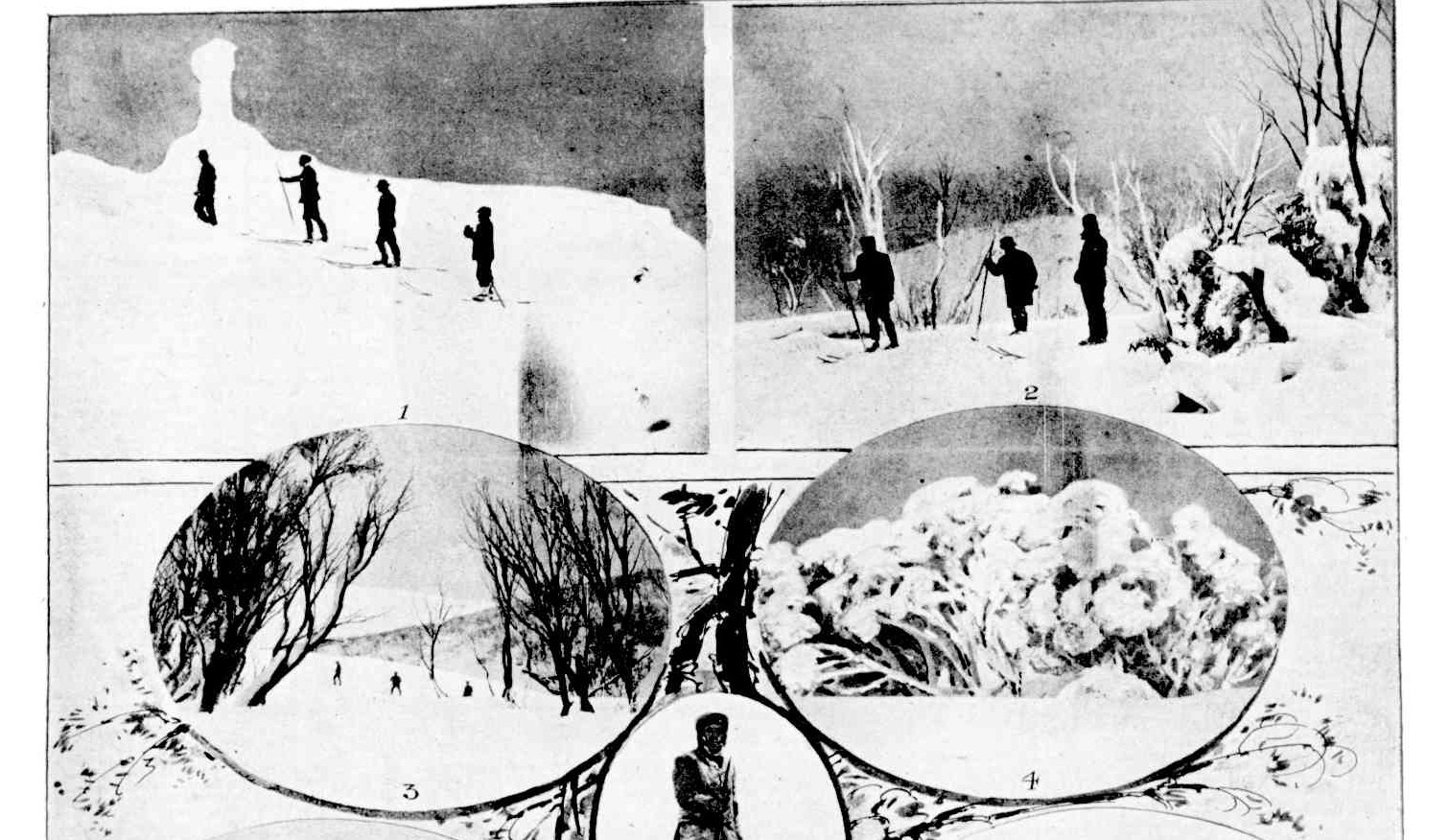
.jpg?timestamp=1655958015961)
1.—On the summit of the "Big Boogong." 2.—On the Muniong Range. 3.—Getting into open country 5500ft elevation. 4.—After a heavy snowstorm. 5.—A crack snow-shoer. 6.—New South Wales Alpine Club in winter quarters. 7.—Snow-shoeing down the hill with firewood. 8.—An Alpine gum forest. 9.—Leaving the last forest 6000ft elevation. With the Australian Alpine Club. (1899, September 2). Australian Town and Country Journal (Sydney, NSW : 1870 - 1919), p. 42. Retrieved from http://nla.gov.au/nla.news-article71333048
Charles Kerry drew the attention of the NSW Government to the Kiandra skiing, and the NSW Government Tourist Bureau commenced promoting and organising regular ski trips to Kiandra for the general public.
Numerous articles and reports from those early times state Kiandra could be completely snow bound meaning that although the site was beginning to attract people from further afield, including Sydney, they could not readily or easily access it. The Australian Alpine Club, amongst its heritage reports, states ''Some of these ski enthusiasts successfully pressed the NSW Government to establish a more easily accessible ski resort on the eastern side of the Kosciusko Main Range..'' and that leads us to another leading proponent of early skiing in New South Wales, and making it available to all, in Palm Beach frequenter Percy Hunter and the building of the Kosciusko Hotel:
KIANDRA AS A SKI-ING GROUND,
KIANDRA, Monday.
In spite of the rain on Friday night, the tourist party, eager for experience, spent Saturday morning on the Snow, which, on account of the heavy rain, was slightly slow, but favourable for beginners. A hard frost subsequently made the snow perfect for skin ing, and in a record-breaking competition Will Pattinson won a gold medal, presented by Mr. C. W. Bennett, of Sydney, doing an eighth of a mile in 9 4-5s, at the rate of 59 miles an hour. On Sunday the weather was gloriously fine, and the snow frozen hard. The tourist party spent an enjoyable day, among the snow hills and valleys. To-day they will run off some races during the morning, all having quickly become expert on the skin, and afterwards journey to Lobb's Hole. On Tuesday they will leave for Sydney. Mr. Samuel Hordern, Junr., who has travelled in Norway recently speaks in the highest terms of Kiandra as a ski-ing ground, and says that next year the hotels will hardly hold the influx of city people who will come to really see the glories of the snow.
In order to encourage visitors to make the acquaintance of the snow, Mr. Percy Hunter, of the Intelligence Department, has arranged with some of the townspeople for a sleigh service from the terminus of the coach Journey into the town. This will enable tourists to come right into Kiandra without much exertion. Several of the visitors have had a trial on the Canadian snowshoes used by Major Waine, but they all discarded them in favour of the Norwegian ski generally, used here. KIANDRA AS A SKI-ING GROUND. (1906, August 21). The Sydney Morning Herald (NSW : 1842 - 1954), p. 7. Retrieved from http://nla.gov.au/nla.news-article14820669
A TOURIST EXPERIMENT
HOTEL KOSCIUSKO OPENED. HIGHEST HABITATION IN AUSTEALIA. GOVEBNOR PEEF0E3IS THE CEREMONY.
FACILITIES FOR ALPINE SPORT AND HEALTH. A LICENSING LAW THAT HIT BACK.
FROM OUR SPECIAL REPORTER.
'Since we have transferred to the Commonwealth the control of meteorology, we have no influence over the climate, and therefore are not in any way responsible for the absence of snow and ice just when we wanted it.'
Thus the Premier of New South Wales, speaking at a dinner given to celebrate the opening of the Hotel Kosciusko — the new £15,000 hotel, or hospice, which the Government has built nearly 6000ft up on the Snowy Mountains, in order that Australians and other tourists may have an elevated sanatorium and the means of indulging in Alpine sports within the area of the winter snows. There was only one disappointment about the opening ceremony; where Man had proposed and performed well, the elements disposed badly. The expected snow had not come.
For miles around the hotel there was not enough snow to cover a threepenny piece. As in some other parts of the southern district, the season was the dryest and the autumn the mildest that had been known for 30 years. Where two feet of white covering had lain at this period of the season in other years was nothing but grass, mountain heather, twisted snow-gums, and other forms of stunted vegetation found in the coldness of high altitudes. There was, in short, a snow drought.
A SIX-ACRE LAKE FOR SKATING.
The six-acre sheet of water which has been impounded by a. dam thrown across Digger's Creek, just in front of the hotel, for skating purposes, has made persistent, but ineffectual, efforts to freeze. Each morning saw its surface glazed with a half-inch sheet of ice, but the warmth of the midday sun was a drawback to its permanence. By the time the vice-regal party was ready to return, there was over an inch of ice on the lake, but it cracked so ominously when a Sydney medico, Dr. Schlink, ventured on it to try its strength, that he got off it with discreet haste. Underneath it was 20ft of ice-cold water. It was just strong enough to hold a man on snowshoes, as was demonstrated by Mr. Paterson, of the Tourist Department, who crossed it.
In a day or two it would almost certainly be strong enough to bear a crowd of skaters. It was estimated that a thickness of 2in was wanted to render safe skating possible, and an extra inch to bear the weight of a crowd. For the party compelled to return at once to Sydney there was little consolation in the assurance that this would be available soon after they left.
Half a dozen motor cars left Cooma for the hospice on Monday morning. They conveyed His Excellency the Governor and Lady Chelmsford, Captain Verney, A.D.O., the Premier and Mrs. Wade, the Minister for Works, Mr. Lee, Sir Francis Suttor, Colonel Vernon (Government Architect) Mr. M Gowen, M.L.A., and a number of other members of Parliament. Mrs. Ashton, Mrs. Holman and some other laches were also of the party. Sir Joseph Carruthers and some friends journeyed through ahead of them from Jindabyne, 13 miles from the hotel, earlier in the day. The Sydney visitors had a motor run of 50 miles to negotiate.
ADDRESS OF WELCOME TO THE GOVERNOR.
At Cooma the Governor was presented with an address of welcome, and another address -wits presented at Berridale, twenty miles out, where the school children sang a song of welcome. For ii:c first few miles after leaving Cooma the roads were found to be badly in need of formation, but after passing this good progress was made to Berridale, and thence to Jindabyne, fifteen miles further on. Hence the ?wj.? w:is tlnoijgh the foothills of the Snowy Mountains, and afterwards by a winding road climb to the higher elevation of the Australian Alps, of which Kosciusko's summit is the most elevated point. These mountain roads, though not yet in good order, were greatly improved as compared with their condition a few days before, and the powerful cars carrying the more distinguished visitors got through very well. Some_ of the other cars reached the end of the journey a few hours late, having made slow progress through the sticky and slippery places along the route.
THE PLEASURES OF HOPE.
As was the case with the ice on the lake, there was a reasonable probability — practically a reasonable certainty — that in the course of a few days the road would be in pretty good order for motor travelling, but here again the returning visitors found little consolation. Even the pronouncement of Monaro residents that snow was certain to fall very shortly contained no element of comfort. In their disappointment at the adverse weather conditions, however, everybody recognised that, allowing for the disadvantage of having some 80 guests crowded into an hotel containing about 30 bedrooms, Mr. Hunter and his tourist department staff had 'everything in as good order for comfort as human foresight could have- provided. The ceremony of opening the hotel took place at dinner, in the presence of about 80 guests. An excellent repast was served, and at its termination the Premier, who was presiding, proposed the toast of 'The King,' and then that of 'The Governor,' during the course of his response to which his Excellency formally declared the establishment open.
THE LONG HISTORY OF KOSCIUSKO.
The Premier, after the reference (already quoted) to the entire responsibility of the Commonwealth, and the freedom from responsibility of the State in regard -to unsatisfactory weather, regretted that the conditions o£ climate were not more appropriate to the occasion. There had been expectations of celebrating the opening by a programme of ice and snow sports, such as skating, toboganning, snowshoeing, and other Alpine recreations.
However, the hotel would mark a new era in the long history of Kosciusko (which, is the oldest piece of land surface, geologists tell us, in the world), for it is now possible to make in comfort, and in a morning or an afternoon, a trip which formerly occupied three or four days, and involved a large amount of physical endurance, if not of hardship, and also a considerable knowledge of bushcraft. This had given, place to convenience, and even luxury. A tribute was paid by the Premier to his predecessor in office, Sir Joseph Carrathers, to whose warm interest the construction, of the road to Kosciusko's heights was due. The comfortable hotel they then found themselves in was, Mr. Wade understood, the highest inhabited spot in the. whole of Australia, and the facilities' it would afford for sport and health should soon make the name of Mount Kosciusko better known throughout not only Australia, but other parts of the world. People who now journeyed to Switzerland would find all the same advantages here. . .
Mr. Wade added that he believed that a similar scheme to this was being carried out not very far away from there, in the mountains o£ the sister State of Victoria. He concluded by hoping that the accommodation and facilities afforded by the Hotel Kosciusko would be the means of giving health and happiness in the near future to thousands of people.
HIS EXCELLENCY WAS ANXIOUS.
Lord Chelmsford, responding to the toast, said that he had been rather relieved than otherwise, at finding there was no snow around the hotel. He had heard of Mayors who opened swimming baths, being expected to do so by taking the first plunge, and he had some misgivings as to whether he should not be expected to toboggan down a hill, or something, or to do some skating. As he had not been on skates for 20 years, and had no experience whatever of tobogganing, the prospect had not been an altogether satisfactory one. The fact that there is no bar for the- sale or intoxicating liquors at the hotel was touched upon by the Governor.
As a matter of fact, the Government, which some time ago passed an Amending Liquor Act, providing that there shall be no increase in the number of hotel licences in any electorate, is now the victim of its own legislation — it cannot get a licence for its own hotel. In such a climate many people consider spirits, even if not a necessity, at any rate a great comfort. In the event of anyone suffering from cold or exposure, they would be extremely useful, if procurable.
DIFFERENCE BETWEEN AN HOSPICE AND AN HOTEL
''This, I am told, is more of a hospice than an hotel,' said the Governor, 'the difference 'being that in an motel' (with a glance at the plentiful supply of wines on the 'banquet table) 'you can procure alcoholic liquors, and here you can't,' Then he added: 'At least, although it may be called an hotel to-night, it is to be a hospice in the future. And without discussing the temperance question, I may say I congratulate the Government upon it. I think there must be many people who prefer to take their wives and children to a homely place where the profits do not depend upon the sale of liquor from a bar. I wish this experiment every success, if only for that reason.'
WORKED A LIFETIME FOR A HOLIDAY.
His Excellency went on to say that he knew the benefits of travel, especially since he had come to Australia; but he thought many people would now be able to find on the Australian Alps pleasures they had previously had to' go half round the world for. He instanced a man and woman he had heard of who, after saving £2009 as the result of years* thrift, had taken a holiday in Europe, 'where, if I may use the expression,' said Lord Chelmsford, 'they succeeded in 'blowing' the whole lot on the trip, and then they had to come back and 'begin life over again.'
He regarded the venture as an interesting tourist experiment, and in declaring the hotel open wished it all possible success.
Sir Joseph Carruthers proposed — 'Success to the District,' mentioning that no less an authority than the manager of the Orient Company had told him that it was the finest tourist district and had the best trout stream in the world. Mr. Miller, the local member, in responding, expressed regret that the Federal capital had not been located there. Mr. Donaldson, the member for the adjoining electorate, which includes Kiandra; Mr. Coughline (Mayor of Cooma), and Mr. Merritt (late president of the Dalgety Shire), also responded. The toast of the chairman, proposed by Mr. M'Gowen, M.L.A., concluded the after dinner speeches.
The Director of Immigration and Tourist Bureau, Mr. Percy Hunter, then entertained the vice-regal and other guests with a lantern lecture on the beauties and Interesting features of the Alpine regions of Australia — a thousand square miles of ice and snow, from which the principal rivers of Australia (with the exception of the Darling and the North Coast rivers) derive their water supply. The vice-regal party next morning made a trip to the snowline, some six miles beyond the hotel, and indulged in some ski-running and tobogganing. They returned in time for lunch, ran into Cooma during the afternoon, and caught their special train, which landed them in Sydney this morning. A TOURIST EXPERIMENT (1909, June 9). Evening News (Sydney, NSW : 1869 - 1931), p. 8. Retrieved from http://nla.gov.au/nla.news-article115496381
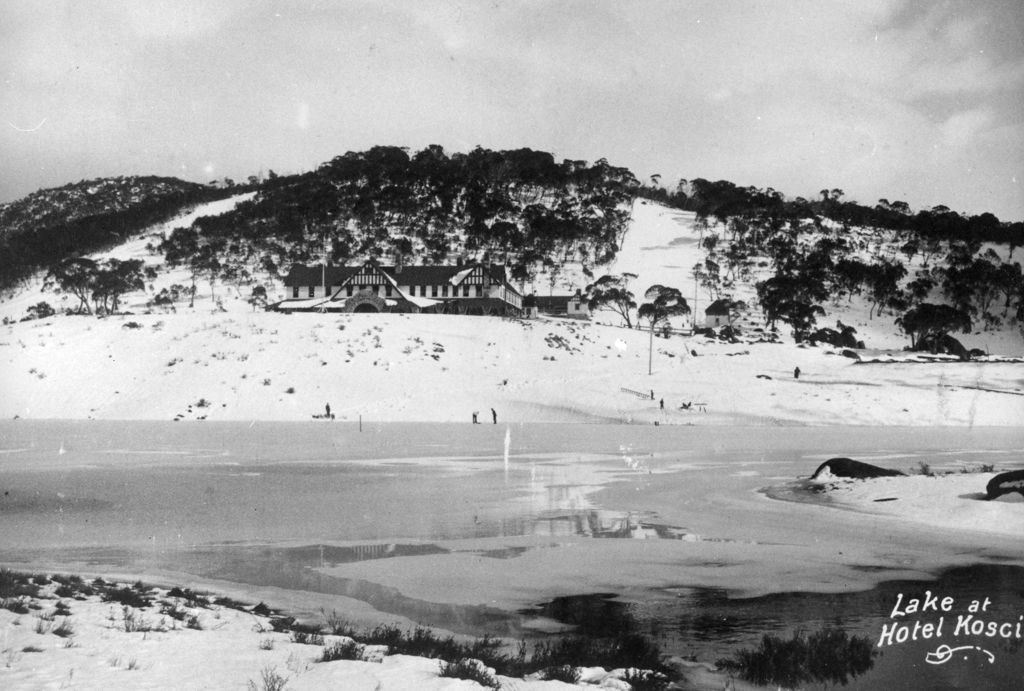
Hotel Kosciusko - 1909
In 1909 Kerry was elected Founding President of the Kosciusko Alpine Club, which led to the opening up of the area for skiing and the naming of a run after him. The still thriving Kosciusko Alpine Club (KAC) claims for Kerry the title of 'father of Australian skiing'. The Kosciusko Alpine Club took up residence in the Hotel for two weeks each July thereafter and a Club Room was provided. The Hotel remained the Club’s winter quarters until 1930 when the new Kosciusko Chalet was opened at Charlotte Pass. The Club officially moved its annual two week pilgrimage to the Chalet in August 1938 but had only been in residence one day when fire gutted the building.
KOSCIUSKO ALPINE CLUB.
Percy Hunter was the founding Director of the NSW Government Tourist Bureau, formerly the NSW Immigration and Tourist Bureau, in 1906. His official trips to England and particularly America promoted Australia as a country for travel and investment. In 1913 he was appointed jointly by the Governments of NSW and Victoria to organise the amalgamation of their respective immigration offices in London. He was a Honorary Vice-President of The Hands Around the Pacific Movement, organised in Hawaii in 1908 to advance the interests of all Pacific communities. His son, David Blair Hunter, was admitted to the NSW Bar in 1923.
The Perisher Historical Society provides:
In the early years of the twentieth century Percy Hunter had been Secretary to the first Federal Agent General in London. Whilst there he had visited Switzerland and been impressed by the potential of snowsports for tourism.
On return to Australia he was appointed to the NSW Department of Intelligence and Tourism, the precursor to the NSW Government Tourist Bureau. In 1906 he made a trip to Kiandra with members of the NSW Alpine Club and there learned to ski. He was smitten.
Immediately Hunter suggested to the Government of Joseph Carruthers that it build a hotel in the Kosciusko area where the snow was better and more reliable than in Kiandra with a view to encouraging winter tourism. He also wrote many articles both in the popular press and of a departmental nature promoting winter sports.
Percy Hunter became a foundation member of the Kosciusko Alpine Club in 1909, President from 1919-1922 and remained a member all his life. He edited The Australian Ski Year Book from its inception in 1928 until 1933.
In 1897 he married - and this, along with a few selected Notices from the pages of the past provides us with an overview of a talented and busy man:
HUNTER— BLAIR.
The marriage of Mr. Percy Hunter, of Sydney, New South Wales, to Miss Lilian Blair, third daughter of Mr. David Blair, of 'Oyama,' Sunderland-road, Armadale, was celebrated on Wednesday, 10th November. The ceremony was performed in the drawing-room by Rev. Duncan Fraser, of 'Rossarden,' Heidelberg. The house was beautifully decorated throughout by girl friends of the bride with white flowers and ferns. A huge prettily designed wedding bell was suspended in the drawing-room. The gown of the bride was of ivory silk brocade, with tiny pink rosebuds; corail tinted velvet, finished with silver passementerie, trimmed the bodice. Orange blossoms were worn in the hair, and a large silver-mounted crook, massed with white satin ribbons and crimson roses, was carried, a gift of Miss Juliet Wray. Two tiny boy and girl cousins of the bride — Miss Freda Graves and Master Kenneth Connelly — attended her. The former wore a dainty frock of cream .Tussore silk and Malta lace, and carried a basket of pink roses from Ronalds' the latter a white sailor suit, with blue facings. Mr. Charles Salter acted as best man. Mr. and Mrs. P Hunter left by express for the wedding tour to Sydney and the Blue Mountains, and their future home is to be at Darlinghurst, Sydney. The bride travelled in a most effective costume of golden brown lustre, full tartan vest, finished with white chiffon ; large Panama straw hat, with loops of ribbon. The presents were numerous and varied including a large number of cheques. HUNTER—BLAIR. (1897, November 20). The Prahran Telegraph (Vic. : 1889 - 1930), p. 5. Retrieved from http://nla.gov.au/nla.news-article144637844
WHO'S WHO
PERCY HUNTER.
Mr. Percy Hunter, Commonwealth Director of Immigration, who is on his way to Australia, is a Victorian; he was born, in South Yarra, Melbourne, in 1874, and spent his early years there. His parents came out to Australia in the Great Britain, which was the first passenger steamer running out here. By profession he is a journalist, and before he joined the Government service was for many years on the staff of the 'Daily Telegraph. In 1897 he married Lilian Blair, daughter of the well - known Victorian journalist, David Blair, who, with the late Ebenezer Syme, founded the Melbourne 'Age.' It was under Sir Joseph Carruthers' regime that Percy Hunter entered the Government service as director of the State Intelligence Department and Tourist Bureau. When the Commonwealth Government took over migration he was appointed Commonwealth Director. He has carried out the negotiations for the new migration agreement between the Home Government and the Commonwealth, and the purpose of his visit to Australia is to confer' with the Government on certain points in connection with this agreement. PERCY HUNTER WHO'S WHO (1925, May 31). Sunday Times (Sydney, NSW : 1895 - 1930), p. 6. Retrieved from http://nla.gov.au/nla.news-article128155524
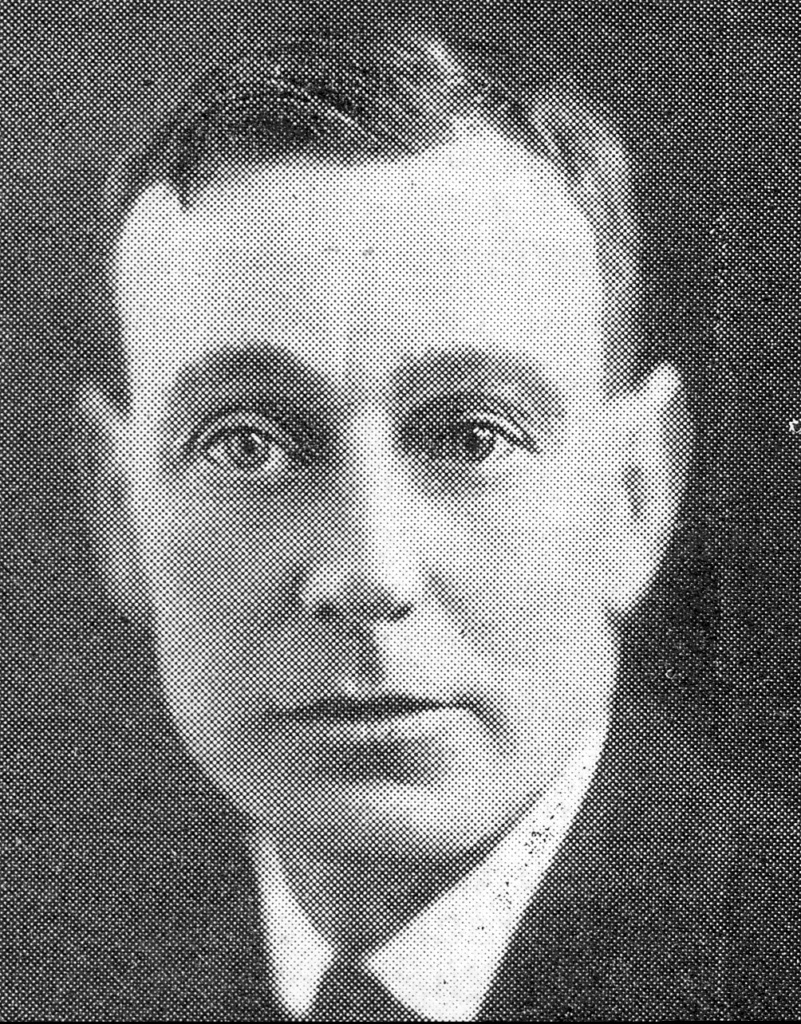
Percy Hunter in 1906
MR. PERCY HUNTER.
VALEDICTORY GATHERING.
At the Australia Hotel last evening, Mr. Percy Hunter was entertained prior to his departure for London to assist in the representation of the State at the Franco-British Exhibition. Mr. G. H. Reid, M.P., presided. Apologies were received from the Lord Mayor, Sir William Lyne, Mr. J. C. Watson, M.P., and Mr. C. A. Lee.
After the loyal toasts, Mr. Reid proposed the health of Mr. Hunter. It was years since he had first met him. It was perhaps the pleasantest part of his political life to be on terms of such friendly relationship with the press. When their guest was connected with journalism he was in close and intimate relationship with him, and he (Mr. Reid) never yet had to complain of a breach of faith on the part of the press. (Hear, hear.) Mr. Hunter had proved his ability outside of the press. In sport and other vocations he had been a distinct success. The Intelligence Department was different from other branches of the Public Service, and no other department called for such services. When he was Minister for Public Instruction he had crossed swords with Mr. Anderson (Laughter.) But the man who would follow every whim of the Minister was not the best under-secretary. (Hear, hear.) He believed that Mr. Hunter was wisely chosen to accompany Mr. Carruthers on the mission to England in connection with the coming exhibition (Cheers.) The mission of Mr. Carruthers and Mr. Hunter would be of the greatest possible service. He heard that their guest was a native of Victoria. (Cries of "Shame" and laughter.) Well, the mother State was never more indebted to Victoria than when Victoria sent such desirable immigrants. (Hear, hear.) He believed that there never was truer friend- ship than that which they all felt for Mr. Hunter. (Cheers.)
Mr. J. H. Carruthers said that as their guest was one of the officers connected with the mission to England, he did not feel justified in making any remarks. But the work performed by Mr. Hunter in the Intelligence Department amply justified his appointment to the Public Service two years ago. There was setting in a steady tide of immigration of a character no one could take exception to, and this was due to the sound judgment of those in charge of the department. We should, however, induce a larger flow of immigration of all kinds to Australia, but we would rather have quality than quantity. (Hear, hear.) Mr. Hunter, as head of the Tourist Department, had rendered good service to the State. He hoped when he re-turned to see their guest put in charge of the department lately controlled by Mr. Ander-son. (Cheers.) Mr. Anderson was a man prepared to fight for his opinion, and he trusted soon to see the word "acting" wiped out, and have Mr. Anderson as Under-Secretary for Agriculture. He himself was honoured by being asked to undertake the mission but he felt able to take up the Position only because of the excellent officers, Messrs. Hunter and Edward, who were accompanying him. (Cheers.) He hoped to see the Agent- General's department brought into closer touch with the Intelligence Department. The two departments should be dovetailed into each other, and an officer from here should go to England periodically to keep the office up to date with local affairs. (Cheers.)
The Minister for Public Instruction (Mr. Hogue) was satisfied that the large and representative gathering was an emphatic endorsement of the action of the Government in selecting Mr. Hunter. (Hear, hear.) As a journalist and a citizen and a man Mr. Hunter had won their esteem. Mr. Hogue expressed his gratitude for the kind manner in which some of his speeches had been left unreported. (Laughter.) Such exhibitions were important factors in securing the peace of the world. (Hear, hear.) Had there been a similar exhibition in South Africa previous to the recent struggle there would have been no Boer war.
Messrs. H. Gullett, W. M. Hughes, M.P., W. A. Holman, M.L.A., Frank Farnell, H. C. L. Anderson, and Major Wynne supported the toast. Mr. Hunter, in reply, thanked all for their attendance and the speakers for their kind references to himself. If he only achieved some small portion of what was anticipated by his friends he would be satisfied. MR. PERCY HUNTER. (1908, February 22). The Sydney Morning Herald (NSW : 1842 - 1954), p. 12. Retrieved from http://nla.gov.au/nla.news-article14917656
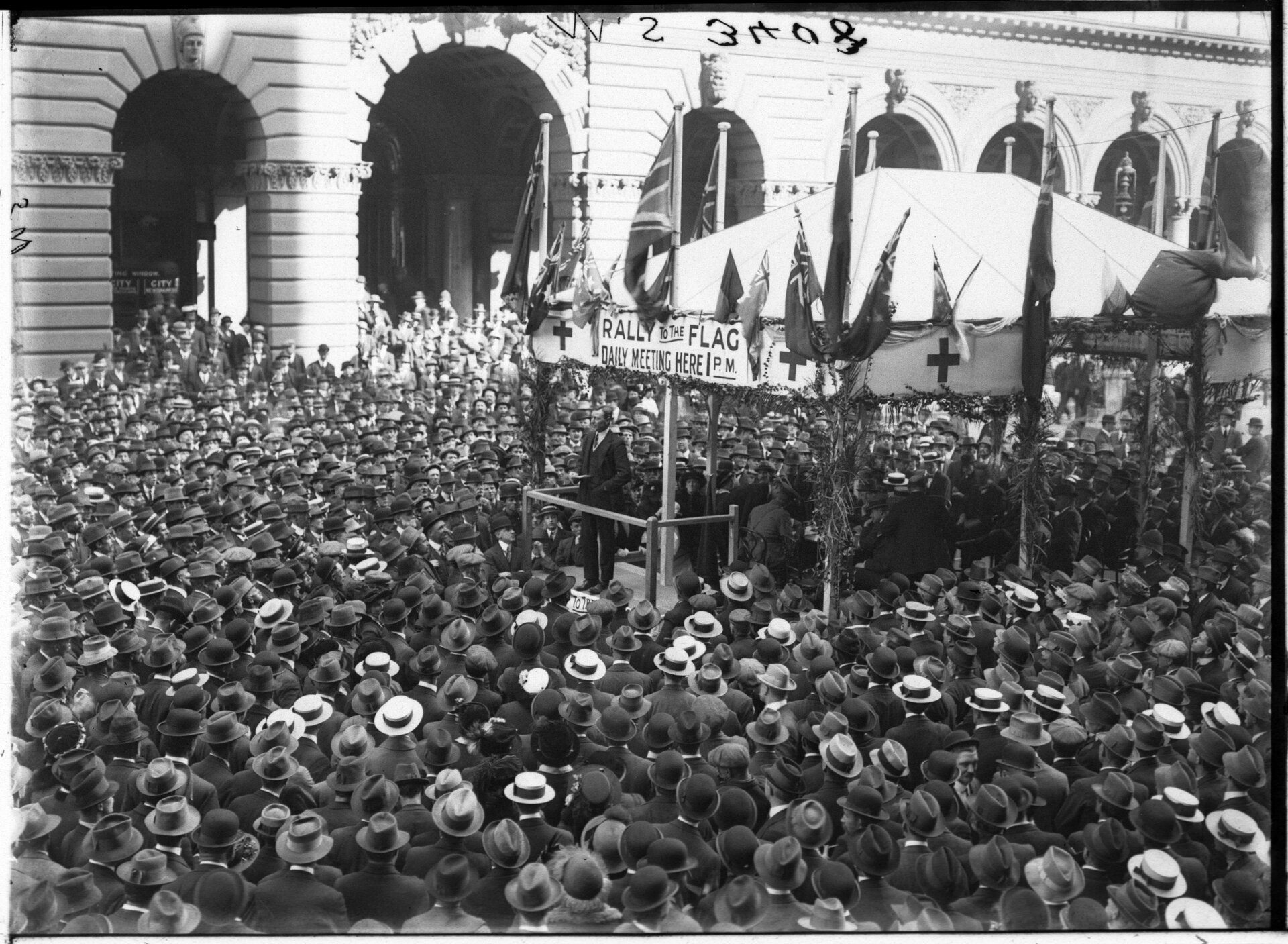
Mr Percy Hunter introducing the speakers, recruiting meeting, August 1915. Image courtesy NSW State Archives & Records, Item: FL3727530
PERCY HUNTER RESIGNS.
SYDNEY, Tuesday.—Mr. Percy Hunter has resigned his position as Director of Immigration and the Tourist Bureau. It is understood he has accepted a semi-public position in the State, but outside the public service. PERCY HUNTER RESIGNS. (1916, June 9). Northern Star (Lismore, NSW : 1876 - 1954), p. 4. Retrieved from http://nla.gov.au/nla.news-article92794560
PERCY HUNTER.
Mr. Percy Hunter, who until recently was Director of Immigration, has resigned in order to take over the position of organiser of the Liberals and Progressives against Socialism. Mr. Hunter's name is almost as well known to the public as the Prime Minister's. Like many other men who have risen to prominence, he graduated in the press. When he was a young man he was a fairly good cyclist, and he competed in events on the Sydney Cricket Ground. When the League of Wheelmen was founded he was one of the leading spirits, and in the course of time became secretary. In the debates at the council meetings Mr. Hunter showed the possession of sledge-hammer sarcasm, besides being remarkably keen and clear in putting the cases before the meeting. He was at that time on the Sydney "Daily Telegraph." Some of his best work in the journalistic line was when he was associated with Mr. Peters, one of the staff also on the "Daily Telegraph," when in Melbourne, looking after the Commonwealth Government. Eventually he returned permanently to Sydney, and in company with a number of sports, such as Hugh D. Mcintosh, George Wynne, of the "Daily Telegraph," and some well-known politicians, the Stadium was founded, and Burns and Johnson brought out to Australia. After a while he apparently disposed of his Stadium interest. Continuing to gather around him a fair proportion of worldly goods, he kept his foot on the ladder, and climbed' quickly. He became Director of Immigration, and now that immigration is for the moment a dead, letter he has got on to something which will hold good for at least five years at £1000 a year. He has been a great grafter, and is endowed with a most genial disposition, combined with farsightedness and acumen, so he we deserves his advancement. One would not be surprised to find that some time in the future he became Premier. PERCY HUNTER. (1916, June 14). Daily Examiner (Grafton, NSW : 1915 - 1954), p. 2. Retrieved from http://nla.gov.au/nla.news-article194812260
MR. PERCY HUNTER IN DUBBO.
Mr. Percy Hunter, the campaign director of the National Party, arrived in Dubbo this morning. He states that it is perfectly true that all National candidates pledge themselves to resist the raising of the Conscription issue. A declaration, signed by all National Government candidates, is being published, which sets out that all the members of the National Party regard the Conscription issue as settled by the referendum of October 28th. They will respect that decision, and will resist any attempt to revive Conscription in any shape or form. Copies of this declaration are expected to arrive in the various electorates early next week. MR. PERCY HUNTER IN DUBBO. (1917, March 9). The Dubbo Liberal and Macquarie Advocate (NSW : 1894 - 1954), p. 2. Retrieved from http://nla.gov.au/nla.news-article75556959
PERCY HUNTER SELLS A BIKE.
Early in Mr. W. M. Hughes' political career he bought a bike from Mr. Percy Hunter, who, even in that period of his true juvenility, was by no means so innocent as he looked. In the days of the first Federation referendum campaign, I have often seen Mr. Hughes wearily pushing several hundredweights of rusty iron on wheels up King-street, not then wholly wood blocked, to the office of the Daily Telegraph.
On one of those occasions I rather pointedly asked him if he owned the bicycle. Seeing and feeling the barb of the remark, he replied: "Well, not exactly. In fact, I think that on the whole it runs me."
Weary at length of using the slave of an inanimate object. Mr. Hughes met on one occasion an obliging friend who consented to sell him a horse—for spot cash. Billy may not have made a good deal, but he certainly got a good deal for his money. His hat rack was about seventeen hands high, had a hard mouth, a dirty white complexion, and owned four frail-live legs, which he slung about aimlessly when in motion. When Mr. Hughes had stormed his heights, with the aid of a step-ladder, and looked down cadaverously from that eminence, his best and most familiar friends hailed him as "death mounted on a pale horse."
He once joined a riding party—with the aid of this animal. When the cavalcade had gone about a mile, Mr. Hughes suddenly broke away at right angles, and plunged down a narrow and dusty winding and uneven thoroughfare, which seemed to lead to a cemetery. After some hard riding and harder swearing, the pair were overtaken, and he was asked for an explanation. He simply said: "Well, the horse wanted to come this way. He has some relatives living in its vicinity." PERCY HUNTER SELLS A BIKE. (1917, April 28). Arrow (Sydney, NSW : 1916 - 1933), p. 3. Retrieved from http://nla.gov.au/nla.news-article115737528
A report by Mr. Hunter himself speaks about Charles Maclurcan as one of their champion ice skater members. Charles Macluran, the son of Hannah Maclurcan, the lady who once owned Bilgola House, and was a self-made business woman who later owned and ran the Wentworth Hotel in town. Charles was also among those who developed Radio in Australia.
Kosciusco's Snow Carnival
Australia's Incomparable Ski-ing Grounds the Scene of Great Sport by Holiday-makers and Health Seekers
(By PERCY HUNTER. President Kosciusko Alpine Club of Australia.)
I believe the Kosciusko snowfields opened up by the N.S.W. Government have no superior as ski-ing grounds on earth. At pre-sent they are served by one Government hotel with two annexes; but I can see the day when the smoke of a thousand chalets and a score of great caravanseries will rise along the range from Kosciusko to Kiandra. I can see a railroad running along the valley of the Eucumbene with spurs into the hills, tapping incomparable snow-fields at a dozen points; and the day is not far distant when air-planes will take us from Sydney to the snow in two or three hours.— PERCY HUNTER.
The annual snow sports season is now in full swing at Kosciusko, and the great Government hotel there has attracted a joyous complement of visitors from all parts of Australia. A strong Queensland contingent has been at the hotel, and ski-runners from Victoria and South Australia added to the throng from Sydney. Owing to the shipping strike several prominent New Zealand people who had booked accommodation were pre-vented from coming across. The great event of the Winter sports season is the annual carnival of the Kosciusko Alpine Club. This function occupies a little over a week, and consists of competitions in the various methods of ski-ing, racing on steep glissades, cross-country work, tobogganing and long distance excursions. The important events are held on different days, and at night the guests make merry at the hotel, where a spacious ballroom accommodates accomplished dancers, and leading society belles whirl to the strains of the latest jazz.
Life at the Hotel Kosciusko is something similar to that on a great ocean liner, without any of the discomforts of sea travel, and with the added advantage that one may leave the building and enjoy the most fascinating sport on the snow at a moment's notice. It is something of an accomplishment this great hotel above the snow-line, fifty miles from the rail-head. It will be appreciated that there are very consider-able difficulties in the way of catering for a houseful of snow-bound people. Yet it is done, and throughout the Winter great crowds of people enjoy an entrancing holiday in the life-giving air of the snow-clad highlands in conditions as comfortable as those to be found in the famous hostelries of the Swiss Alps. In a word, the N.S.W. Government has brought Switzerland to our doors.
How to Get There.
To reach Kosciusko, the Cooma mail, a comfortable train equipped with sleeping cars, is taken at 8.25 p.m. from Sydney, and after a good breakfast, a motor car drive of 50 miles lands the visitor at the Hotel Kosciusko in time for lunch, the last two miles being negotiated in a sleigh drawn by three horses with jingling bells. The drive is an enjoyable one, and frequently, when the foothills are snow-clad, a novel experience for many of the visitors. The whole journey occupies about 16 hours, and is one free from discomfort.
It is in July that the carnival of the Kosciusko Alpine Club of Australia is held. The call of the snow reaches every club member, and they are to be found in all the States of Australia. The spacious corridors of the hotel are adorned by handsome shields given by generous donors to the club, upon which the names of the winners of the classic events are inscribed. Thus upon the Kerry Shield each year appears the name of the man who wins the club's Glissade Championship, and upon the Hugh D. Mclntosh Shield that of the successful competitor in the Women's Championship.
The Kosciusko Alpine Club came into existence in 1909, and its chief object is the encouragement of Winter sport in Australia. The 1919 Year Book of the club says that Australia has been en-dowed by Providence with one of the most suitable ski-ing grounds in the world. The ski-ing ground is not yet famous, and it devolves upon the club members to make it so. By emulating the deeds of the worthy exponents of ski-ing in Norway, Switzerland and other snow countries, the local ski-runners will confer upon the Kosciusko ski-ing grounds the fame they justly deserve. It is a fact that there is no better ski-ing country in the world than is to be found on the Kosciusko plateau.
Roughly speaking the grounds begin at the Hotel Kosciusko, and there is good ski-ing almost any time in June, July, August and September from that point to the summit, a distance of 17 measured miles by the road, and about 15 miles as the crow flies. The hotel is situated on a kind of promontory of high ground, consisting of a series of ridges and big hills, broken by intersecting valleys, bounded by the gorges of the Snowy and the Thredbo, and running almost due west from the confluence of those rivers, about five miles north of Jindabyne to the summit, thirty miles away. This promontory varies in width from about six to ten miles, and west of the Hotel Kosciusko it is all fine ski-ing country.
When once the main divide is reached, through Charlotte's Pass, across the head waters of the Snowy, great fields of snow stretch away to the north. From the summit, almost due north, and fifty miles away, lies Kiandra at the end of this high section of Australia's main divide. Here, on a 20 miles-wide belt of high and comparatively rugged hills, but with plenty of open rolling country some of the finest of the ski-ing grounds are to be found. But for want of accommodation they are at present practically in-accessible. There is, however, quite enough country within adventurous reach of the hotel to satisfy the most ardent ski-runner.
Ski-Racing Tracks.
Immediately about the hotel are the well-known racing courses, the Kerry, the Grand Slam, the George Bell, the Chelmsford, and the Alexander Ford Glissade. The road to the summit passes the hotel, and by long sidlings on Mount Vernon and Mount Sunrise, climbs a mile and a quarter to Dainer's past a rendezvous well known to all who have been on the snow. From this point the big hills towards the main divide are visible, and the ski-ing grounds proper are opened up. Leaving for the moment the grand stretch beyond Piper's Gap, on through the Perisher Plain with the grand old Perisher lording it over the littler hills in his vicinity, past Betts' Camp and the Guthrie Range to Charlotte's Pass, and through to the unparalleled prospect of the dazzling main divide, the snow visitor will find ample scope for activity on the magnificent slopes of the fall from Dainer's Gap both ways, and in to the north, down Piper's Creek, towards the gorge of the Snowy River on the Plains of Heaven and beyond the plains in some entrancing beautifully-wooded valleys, with park-like spaces running through the ranges to the great Back Perisher.
This country affords innumerable delightful little traverses through the timber up hill and down dale. This season the Piper's Creek snow fields have been particularly popu-lar, and numerous picnic parties have sallied forth from the hotel for a day among these hills. Lunch is carried in ruck sacks by the men of the party, and almost invariably consists of fresh chops to be grilled over a wood fire on a grid-iron which forms part of the equipment. It is an extraordinary feature of life on the Kosciusko hills that so sustaining is the air, containing, as it does, a great proportion of oxygen, that one can, at a pinch, do comfortably without lunch when ski-ing, while at the same time, if available, a good chop freshly grilled and appropriately seasoned, is far from being unwelcome.
Picnic excursions are generally indulged in by the racing men a few days before the carnival, to get them in shape for the long-distance races. These excursions often take place over the route to Betts' Camp. The run from the hotel to Betts' Camp, with a rest for lunch, and home in the afternoon, is becoming increaseingly popular with club members. The journey covers 17 miles, and any fair skier can comfortably accomplish it in the day. In good snow the whole way is good ski-ing. The fall from Dainer's to Piper's Creek is a beautiful glissade, and this is followed by a short flat, and then a long, well-graded climb to the top of Piper's.
From Piper's Gap the track falls to a wide, open flat, known as the Perisher Plain, opening up on the way Sunset Valley. It is perhaps a little better than a mile to the beginning of the climb to the Perisher Gap, which is a long pull up, but once on top here Betts' Camp is almost in sight, and the track falls practically all the way to the house. The return from Betts' is a very much easier run than the climb there. There is a magnificent glissade from the top of the Perisher Gap. This should be taken high on the left, and the run can then be continued well into the Perisher Plain. The climb to Piper's is quite easy, and then there is another glorious run down practically to the foot of the Dainer's Gap hill. Dainer's Gap climbed, the skier can consider himself at home.
Two New Champions.
This year the club discovered two new champions. In the men's club race, the champion, N. Storaker, a Norwegian and the finest skier even seen at Kosciusko, did not defend, being absent on a visit to Europe. But the event produced a fine race, which was won by Richmond Scott, who is showing better form than he has ever done before. I doubt if Storaker would have beaten Scott in this year's race. Mounted on a mammoth pair of racing ski, waxed to a wonderful surface, he swept right away from his field in the first glissade, and riding the well-known sudden drop in the Kerry like a bird, he pushed across the flat to the road alone, swinging with a beautiful left stem round the flagged turn, and away on the next drop before his nearest competitor, Cam McFadyen, who also rode beautifully, was across the road.
On slower snow Scott handsomely beat Storaker's time of last year, and he was the recipient of many hearty congratulations. It is a great thing for the club to have produced a rider of Storaker's class. The second man, McFadyen, has improved greatly, and will improve further. He has a magnificent style, and next year he should make Scott fight hard to defend his title. The third man in the club championship was Charles Maclurcan the celebrated ice-skater, who performed meritoriously, and who after-wards ran true to form by winning the open scratch race over the same course.
Percy Pearson, a veteran of the snow, who has the record of having started in ten championships, was a good fourth. In the club events for ladies the new champion proved to be Miss Kathleen Meek, who defeated the champion, Miss Doris Pitt, who won in 1916, 17, and 18, after a most exciting race. Miss Beryl Bennett was a good third in this event. Miss Meek has knocked at the door of the championship before, and will be hard to beat in future years. Miss Pitt does not intend to race again. Miss Meek's most formidable rival next year will probably be her young sister Hope, who won the open five miles handicap, and who proved her quality by getting over the course in less than two minutes slower time than the virtual scratch man. Miss Bennett, who filled the third place in the championship is a stylish and capable ski-er, and will be heard of in future.
There were several notable absentees for the ranks of lady competitors this year, prominent among them being Miss Babby Munro, of Queensland, the influenza pandemic being partly responsible. But it is likely that next year will see some keen competition in the events for ladies. The carnival produced some promising novices, including Miss Joan Taylor, of Bellevue, Queensland, daughter of a well-known breeder of Herefords, who won one of the events. Miss Olive Dalzell, Miss Holden, Miss Hudson, Miss Joan Grant, Miss Magill, and the Misses Rita and Ruth King, of Bingara.
All of these are now devoted adherents of the snow sports, and may be expected to give a good account of themselves in future. The club made a departure this year by instituting an open championship of Australia. This event was run over the five miles handicap course.
An Ideal Course.
This makes an ideal course, the first two miles and three-quarters consisting of a stiff, and difficult climb, through thick timber after leaving the cleared portion of the Alexander Ford glissade, the next mile and a quarter being varied running requiring considerable skill and quickness in stemming and turning among trees, and the final mile being a good run all the way with a steep glissade on the lower Kerry to wind up. The course at racing speed calls for all the highest qualities of ski-ing, and the win of Richmond Scott, the club champion in this, the first open championship of Australia, was received by his fellow members with profound satisfaction.
Mr. Scott, who is a rejected volunteer, who during the war did valuable home service, is one of the most popular members of the club. Unfortunately his health is not quite robust enough to fit him for distance racing. He was completely exhausted at the end of his gruelling five miles, and only his grit and quality as a ski-er gave him the victory, as he did not pass the leading man until well past Dainer's Gap on the run home. The second man in this event, Mack Walker, put up a remarkable performance. It was his first season on the snow, and he has developed a faculty for ski-ing in a wonderfully short space of time. In the glissade events, on the Kerry course, he ran nowhere, being unable to stand up, but in both the dis-tance events, the handicap and the championship, he ran second, beating a sea-soned field each time. Walker is an athlete in good shape, and in him and McFadyen the club has a very good pair, who will take a lot of beating in future events.
A returned man, C. A. Sweetnam, won the men's novice race, his young brother, R. N. Sweetnam, being second. This race provided the most amusing series of falls seen on the course. The ladies' novice was won by Miss Taylor, with Miss Holden a good second, and Miss Nell Magill third. The ladies' open ski produced a very good race. With Doris Pitt and Kathleen Meek, ex-champion and present champion, absentees, a good deal of interest attached to the event. The race was true to form, and was won by Hope Meek, undoubtedly the next best woman ski-er on the snow. This rider, who is only a child, possesses speed, form, and endurance, and she is a particularly good performer on long excursions, as witness her win in the five miles' handicap. Good judges look on her to develop into a champion worthy of upholding Australia's reputation abroad.
Another interesting glissade event was the veterans' race, which was won by Pat O'Shea, who fell into the judges arms. In this event J. E. Toole passed the line first, but he dropped one of his sticks en route, and under the club rules this automatically disqualified him.
Rarely Cold on the Snow.
I am often asked questions as to what sort of weather conditions are met at Kosciusko, and whether the cold is not too great to be borne with comfort. The only thing to be said in reply is that one is often much too hot on the snow, but rarely too cold. Of course I have been cold when out on the high tops, and encountering a snow blizzard. But generally speaking in ski-ing anywhere below the Perisher gap cold is a factor that need not be considered. People should not go to Kosciusko in Winter unless they mean to ski or skate, as these are the only forms of exercise possible, and without exercise one is apt to feel a stay on the snow monotonous. As to clothes very little preparation is necessary. Riding breeches or something in that form, are the most comfortable and convenient wear for men and women alike, and they can be worn with thick woollen stockings or with puttees, and both. Skirts are quite unnecessary, and one sees fewer of them each season on the snow. The day is not far distant when a girl would as soon think of donning a skirt when ski-ing as she would think of appearing at the Peace Ball without one. Good ski-ing boots are es-sential for comfort, and proper ski, of course, are needed. The ski-binding most used at Kosciusko is the Huitfield, and it is very service-able, and answers all requirements splendidly. For myself I prefer the Ellefsen, and this binding is particularly adapted for Australian conditions, as we do not here get the very low temperatures which make it not quite so satisfactory as some other bindings in Switzerland and Norway.
Speaking of temperatures, there was a record low one of 7 deg. Fah, at the hotel this July. The previous lowest was 10 deg. on August 14, 1913. The snowfall has been comparatively light this year so far, though there has been quite enough for splendid ski-ing. The snow did not fall about the hotel until late in June. In fact, Manager Lamble was conducting parties to within two miles of the summit by motor car in June. These fortunate folk had the advantage of making the acquaintance of the snow-covered main divide under most comfortable conditions, and without being compelled to undertake a 17 miles' jour-ney on ski to bridge the distance.
When the snow did come it fell bountifully, and by the beginning of July it was lying thick on all the hills round the hotel and far below it. A few days later another big fall occurred, and splendid conditions existed everywhere. Considerable improvements were no-ticed this season at the hotel and in the vicinity. There, of course, remains much to be done; but it can be said for the energetic Government Tourist Bureau which controls this priceless holiday and health area that it is never satisfied, and is always endeavoring to have the Hotel Kosciusko what it should be—the resort par excellence of Australia.
A chef, M. Speet, who left Kosciusko to fight for France, and who has fortunately returned to his job, provides a cuisine which is in keeping with the hotel's reputation and standing, and generally speaking it may be said that those who pay a visit to this snow-house will find little to grumble at. The house is electrically lighted, and heated by a central steam and hot-air system. There are faults in both these systems just now, but this is largely due to the war. The light is driven by water-power, and for the lack of about £2000 to complete a dam in the hills, the power has not been sufficient to do the thing thoroughly. I understand, however, that this defect will be remedied this Spring, and the completion of the dam will prove a most economical expenditure for the hotel, as the extra power will carry out a great deal of other work besides light-ing and heating. A great advantage se-cured will be the complete heating of the southern wing of the house, which at present is certainly not too warm. The dam will cover a surface of eight acres, and will in itself prove a great scenic attraction.
No Better Diversion.
The snow remains through August and September, and to those who need a health-giving holiday no better diversion could be suggested than a trip to these wonderful fields. To those who have had no ski-ing experience any members of the Kosciusko Alpine Club who happen to be on the snow will gladly render as-sistance. The bond of the snow is a firm one, and the club members properly regard themselves as trustees for a sport yet in its infancy. They are ready at all times to give instruction, either rudiment-tary or advanced, and are delighted to find new people who will take an interest in the Winter pastimes. The committee of the club was particularly active this year in arranging excursions for new members, and there were several instances of novices who successfully accom-plished the seventeen miles run to Betts' Camp and return in the day.
Mr. Arthur Pitt and Mr. Charles Maclurcan are perhaps the most skilled instructors among the club members, and many a be-ginner on the snow has to thank these two enthusiasts for rapid progress. The ski-ers have visions of improve-ments on the snow which will lengthen the season materially, by making the wonderful grounds on the main divide more easily accessible.
Included in these are the improvement of Betts' Camp, and the erection of some kind of chalet at Charlotte's Pass, and a shelter shed on the summit. The latter should take the form of a substantial granite structure, and it has been suggested that utility might be combined with sentiment by making the building a memorial to the Anzacs. It is felt that it would be fitting to have some such recognition of our incomparable heroes on Australia's highest point, and the matter is one well worthy the consideration of the authorities. Mr. Holman has always looked at matters touching the war and the in-terests of our soldiers and their dependents with such an appreciative and far-seeing eye, that I believe the idea will appeal to his sense of the fitness of things.
A memorial on Kosciusko's lofty brow, constructed of imperishable granite, would form a worthy shrine, and Winter and Summer the building would prove in-valuable to the visitors who pay their homage to Australia's greatest mountain. For the rest, the Superintendent of the Tourist Bureau has a keen desire to afford every facility for improving conditions on the snows, and I have no doubt that, as opportunity offers, Mr. Palmer will carry into effect the projects enumerated.
It is intended this Spring to complete the Alexander Ford Glissade from the point at which the clearing was interrupted by the war, about 250 yards above the top of the Kerry, to the Gates of Heaven. This will make a wonderful ski-ing course through very interesting country.
The Gates of Heaven are on the side of the lofty Mount Sunrise, and open the way to the Plains of Heaven. When this run, which was named in honor of the decorated American publicist, Mr. Alexander Hume Ford, of Honolulu, who is one of Kosciusko's warmest friends abroad, is finished, the ski-er will be able to run down hill with-out a break from the Gates of Heaven, by way of the Kerry Course, right to the hotel, a distance of about two miles and a half. The round trip up, by Dainer's Gap, and home by the Plains of Heaven and the Alexander Ford Glissade, will certainly be one of the most popular excursions on the mountain.
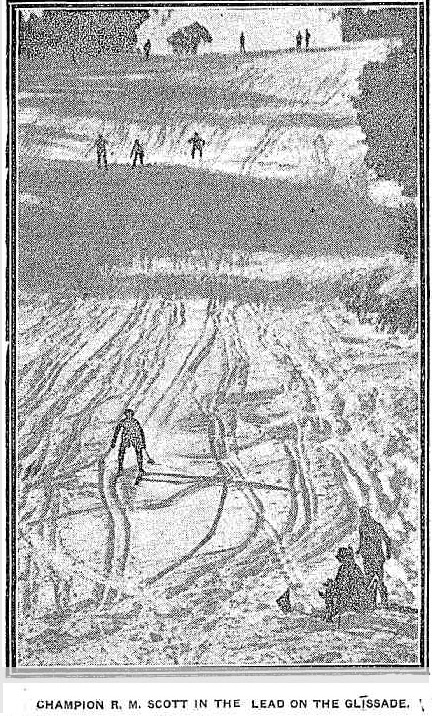
.jpg?timestamp=1655966285502)
CHAMPION R. M. SCOTT IN THE LEAD ON THE GLISSADE. A Club Committeeman adjust-ing to a ski-binding for a novice.
.jpg?timestamp=1655966316437)
GROUP OF SKI-RUNNERS OUTSIDE THE HOTEL KOSCIUSKO. FROM LEFT TO RIGHT: CAPT. HOLDEN (FLYING CORPS), MISS HOLDEN, MR. PAT O'SHEA (BRISBANE), AND CHAMPION RICHMOND SCOTT.
.jpg?timestamp=1655966352388)
A PARTY OF LADIES PRACTISING THE KICK-TURN, AN INVALUABLE ACCOMPLISHMENT WHEN TRAVELLING AMONG TIMBER
.jpg?timestamp=1655966381570)
THE SIDLING ON THE ROAD TO THE SUMMIT FROM THE HOTEL, ON THE CLIMB TO DAINER'S GAP.
.jpg?timestamp=1655966404416)
GENERAL VIEW OF THE FAMOUS KERRY COURSE, ON WHICH THE GLISSADE CHAMPIONSHIP IS RUN. Kosciuscor's Snow Carnival (1919, August 10). Sunday Times (Sydney, NSW : 1895 - 1930), p. 23. Retrieved from http://nla.gov.au/nla.news-article123222364
IMMIGRATION.
MR. PERCY HUNTER'S APPOINTMENT.
Mr. Percy Hunter, who, is to proceed to London to lay the foundations of Australia's new immigration system, was formerly chief of the New South Wales Immigration Department, and was afterwards superintendent of the combined services of New South Wales And Victoria. He is a native of Melbourne, and came to Sydney in 1892, engaging in journalistic work. He joined the Government service in 1906, when Sir Joseph Carruthers was Premier, and helped to establish the Tourist Bureau.
MR. PERCY HUNTER.
In 1908 Mr. Hunter went to London in connection with immigration, and on Mr. H. C. L. Anderson taking the position of Under-secretary for Agriculture, he became chief of the New South Wales immigration service. He spent a considerable time abroad, and studied the movements of population in the United States and Canada. He also carried out several important missions in Europe. Mr. Hunter drove a Red Cross ambulance in France for the first few weeks of the war, but Government business brought him back to Australia. He acted as director of the recruiting movement in 1915. He also organised some big war charities, including the Belgium Relief Fund, of which he was joint secretary with Mr. Walter Beavis.
In 1910 Mr. Hunter returned to London on Government business, and, as immigration had practically ceased owing to the war, he placed the Victorian and New South Wales departments on a skeleton basis, and, returning to Australia, resigned from the service. For a year or two he took a foremost part in political organisation. He is at present engaged in business in Sydney. Mr. Hunter is vice-president and honorary Australian representative of the Pan Pacific Union, and was one of the founders of the Millions Club of New South Wales. For years he was a prominent figure in sporting circles. Mr. Hunter will leave Sydney by the southern express to-night to join the R.M.S. Orsova at Adelaide. IMMIGRATION. (1920, September 27). The Sydney Morning Herald (NSW : 1842 - 1954), p. 6. Retrieved from http://nla.gov.au/nla.news-article16867923
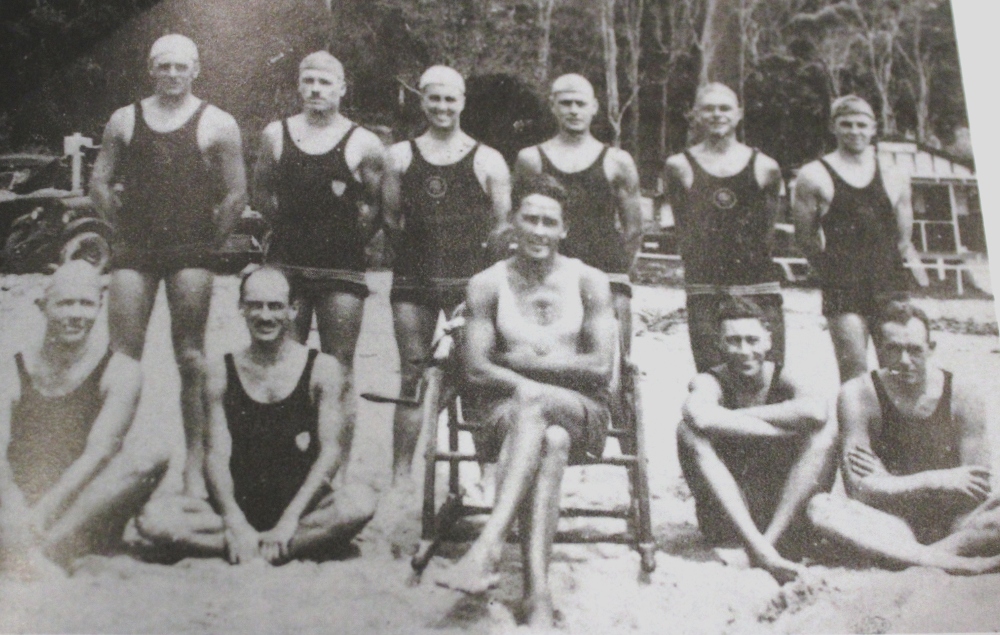
Another gentleman associated with early skiing in Australia was gynaecologist and hospital administrator, Sir Herbert Schlink, who was also named by some the 'Father of Skiing at Kosciusko'.
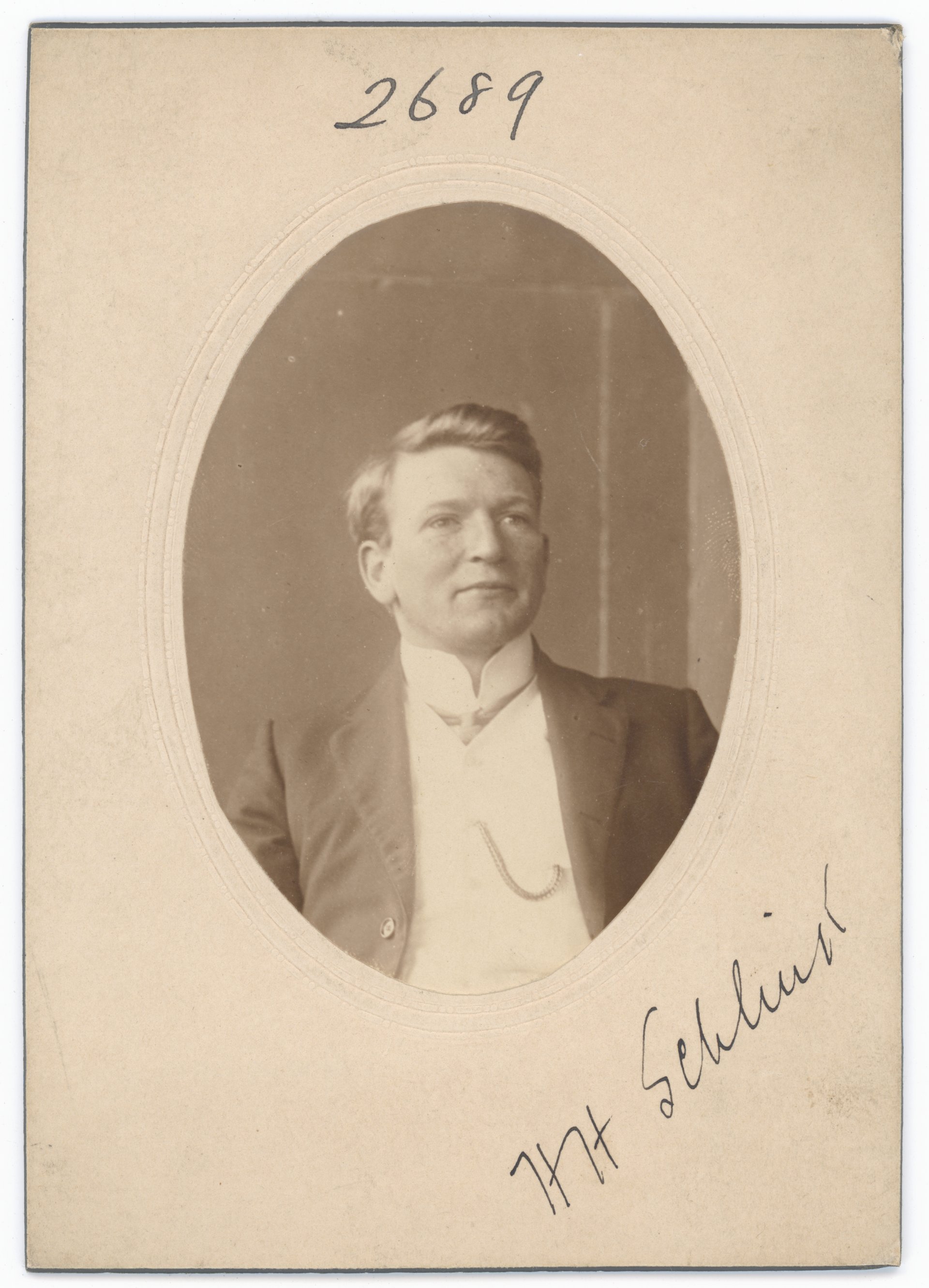
Photograph of Herbert Henry Schlink doctor [no date], courtesy NSW State Records and Archives
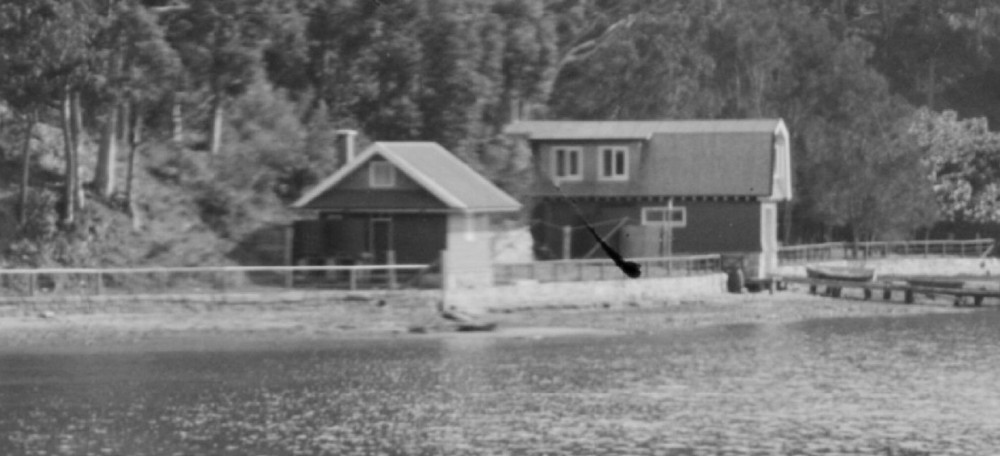

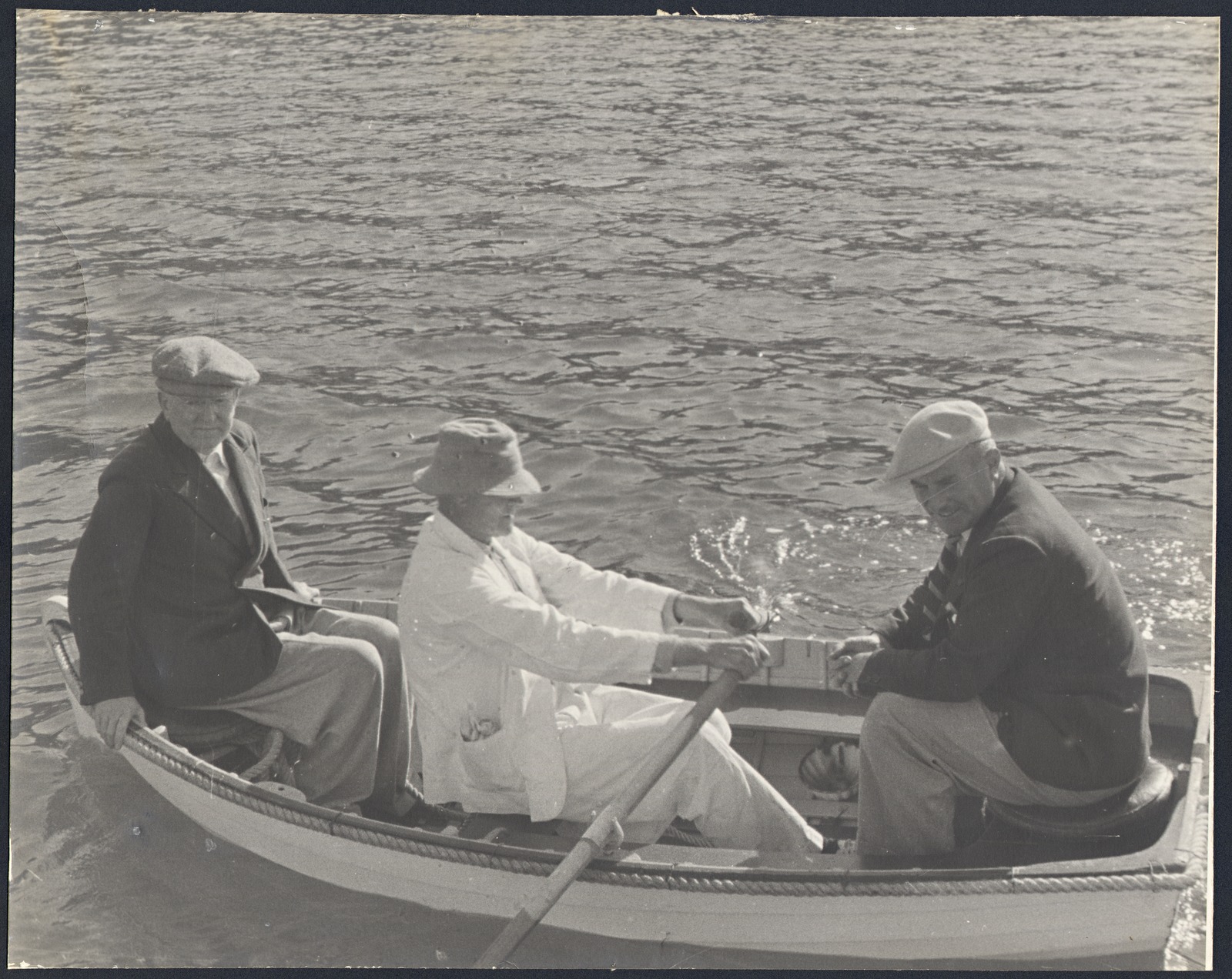
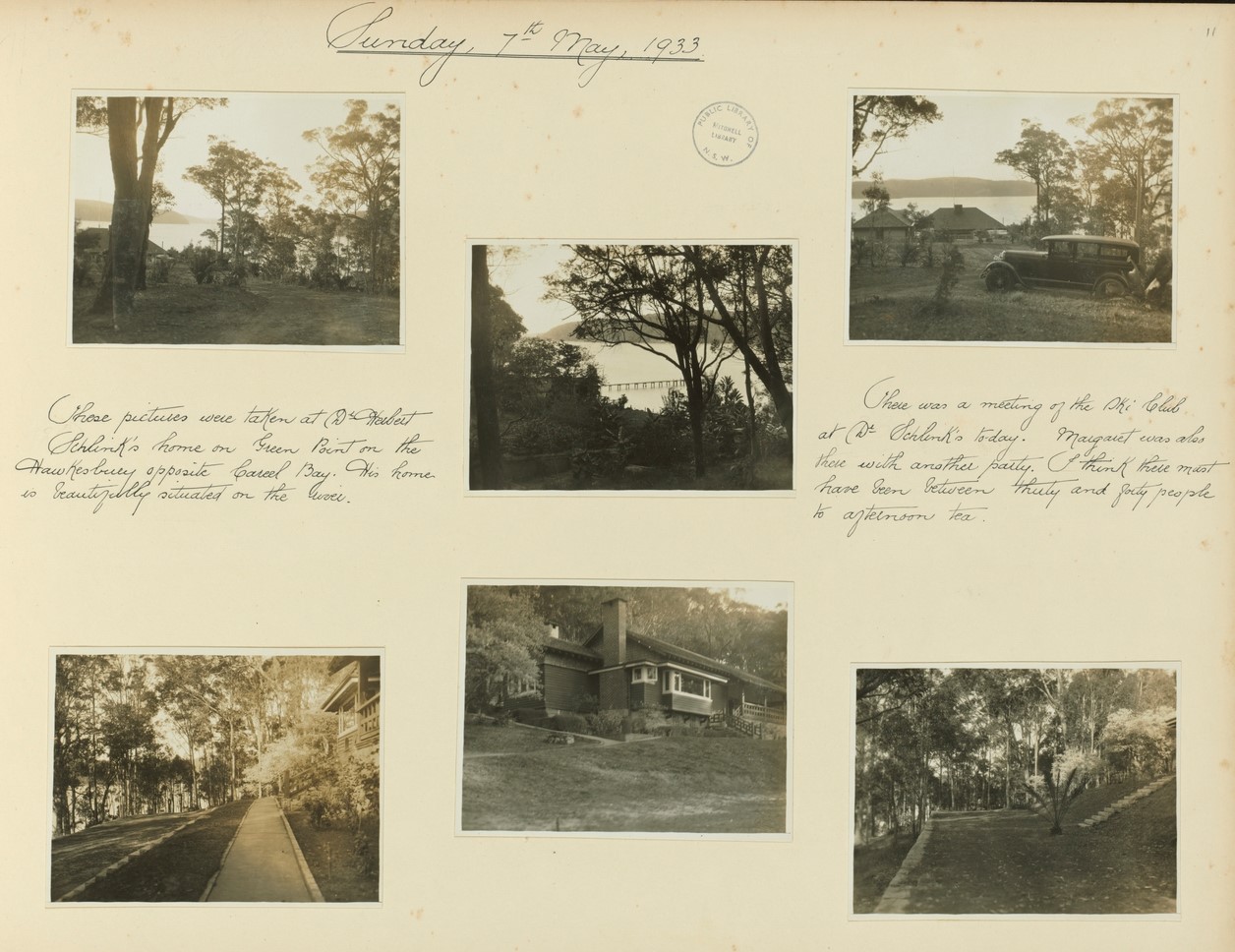
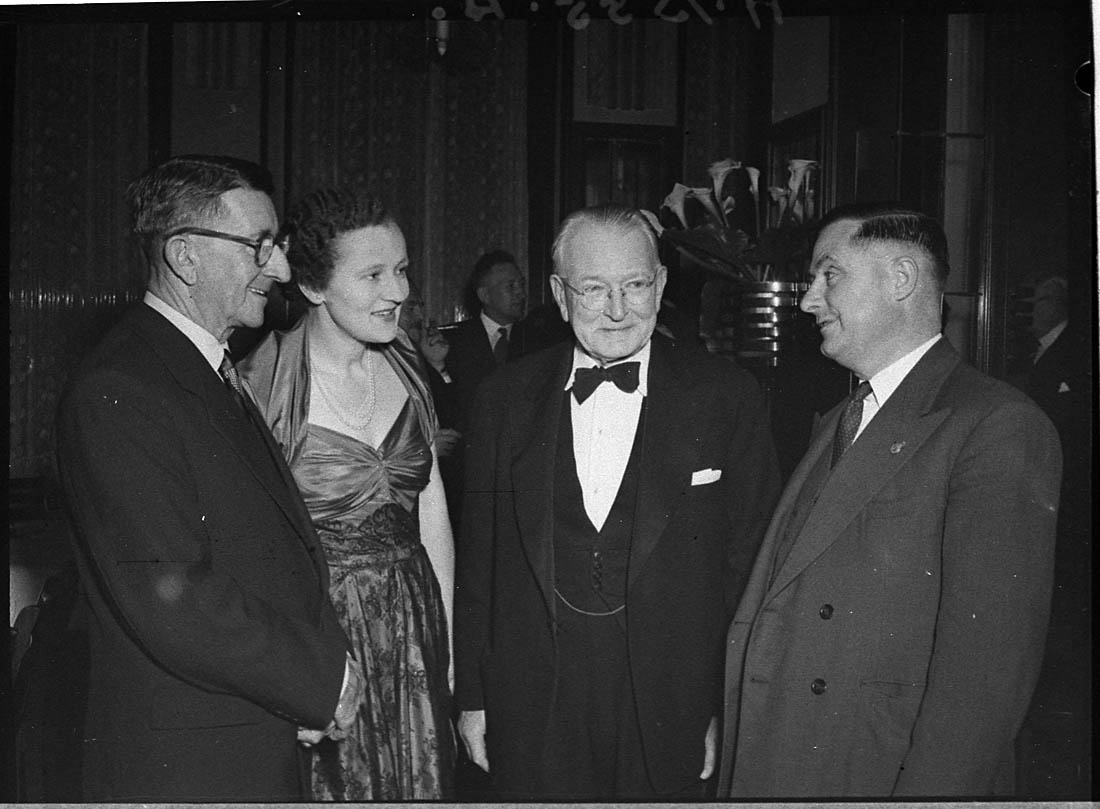
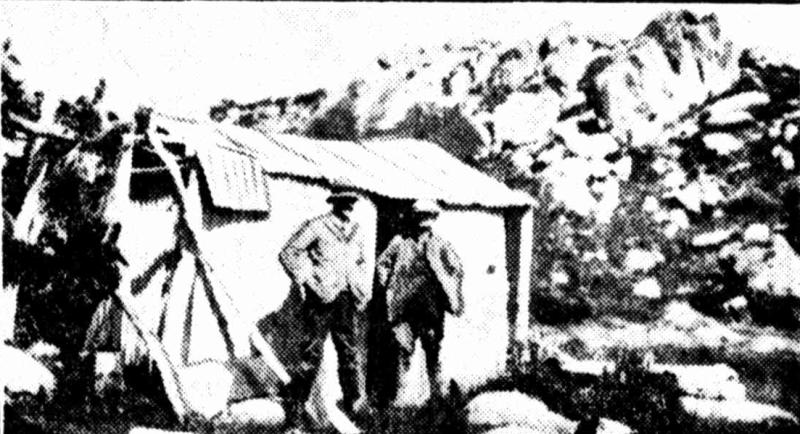
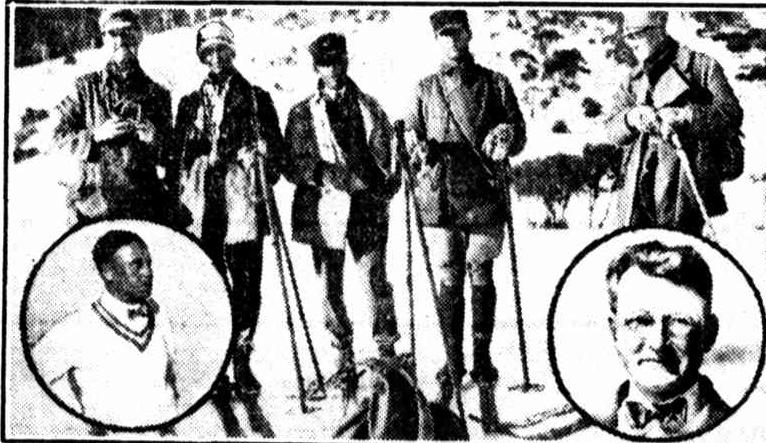
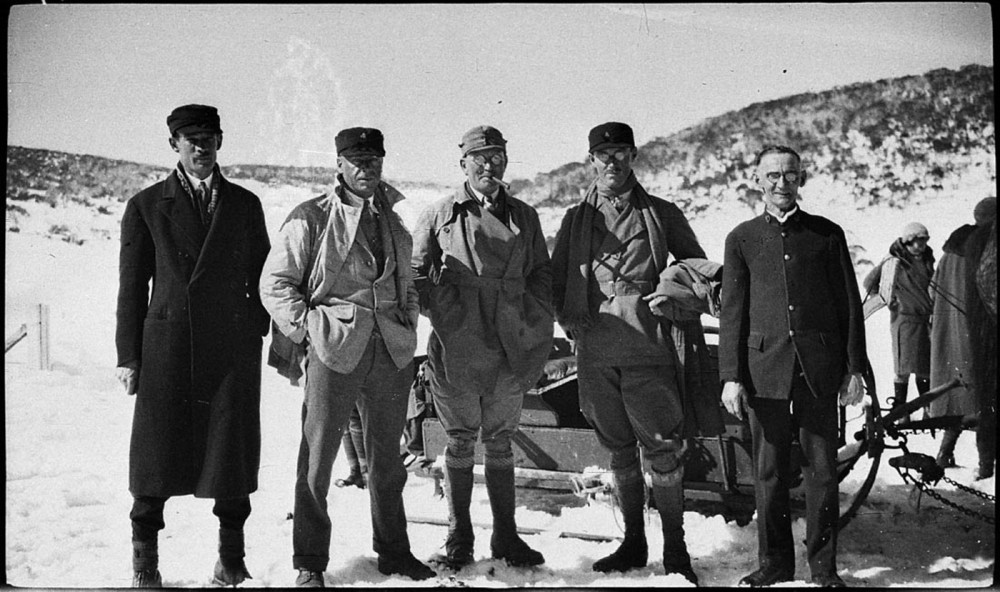
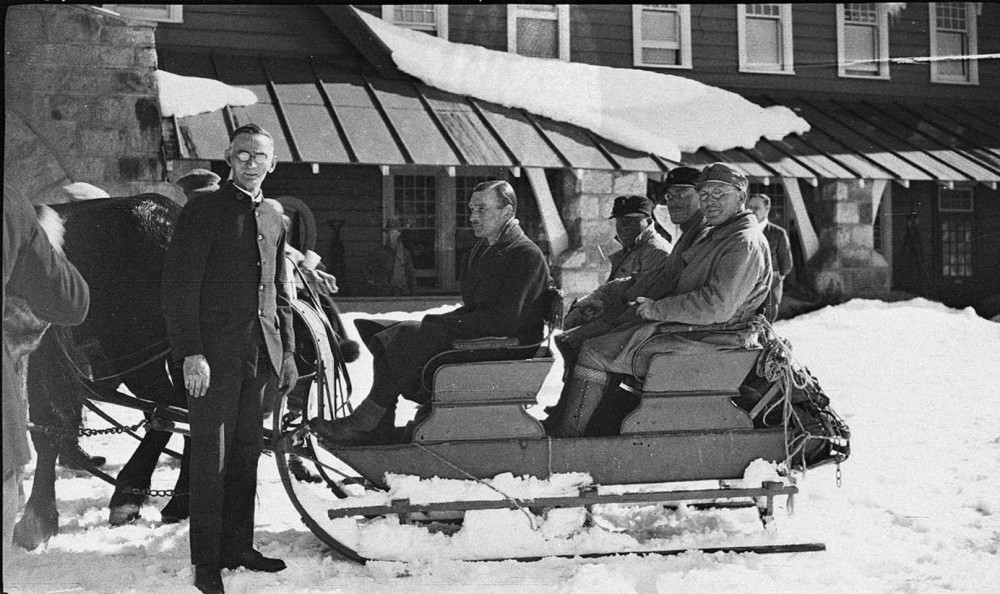
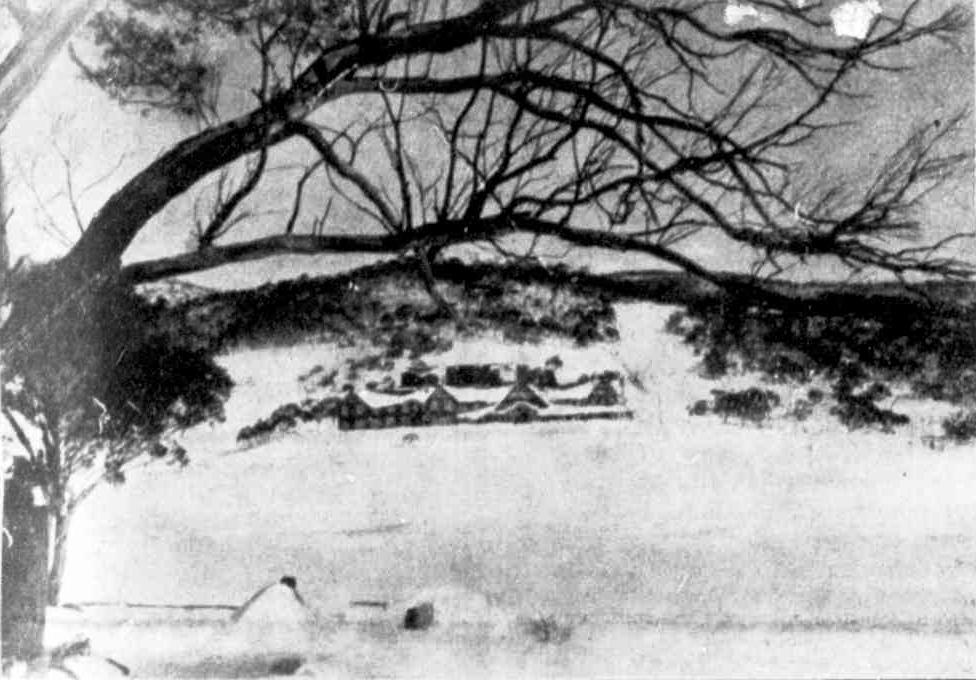
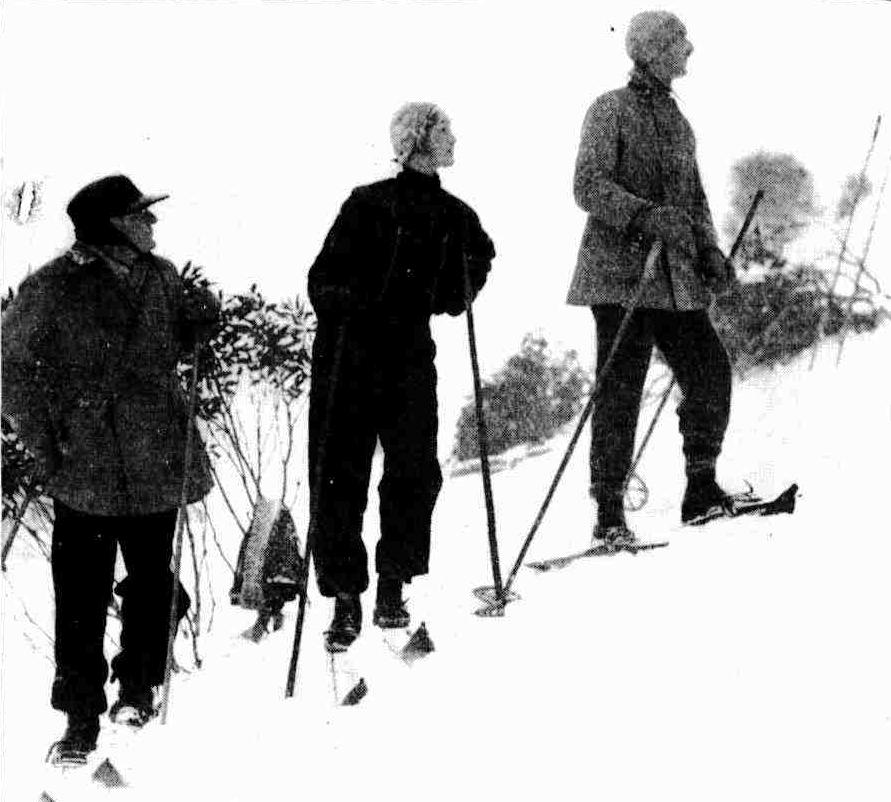
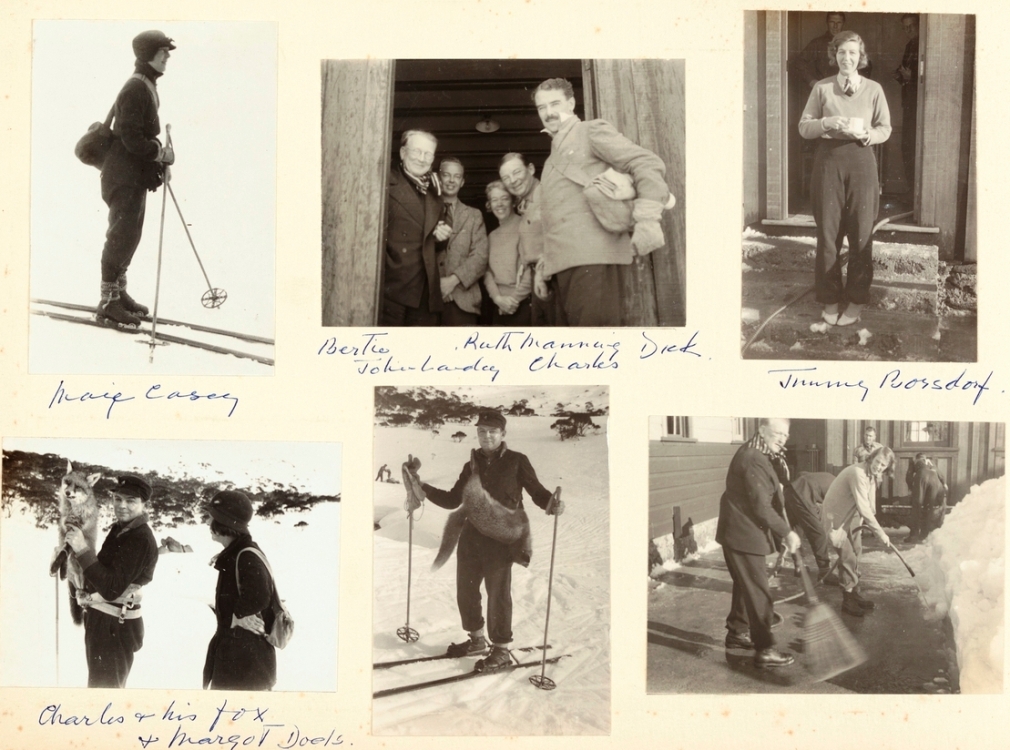
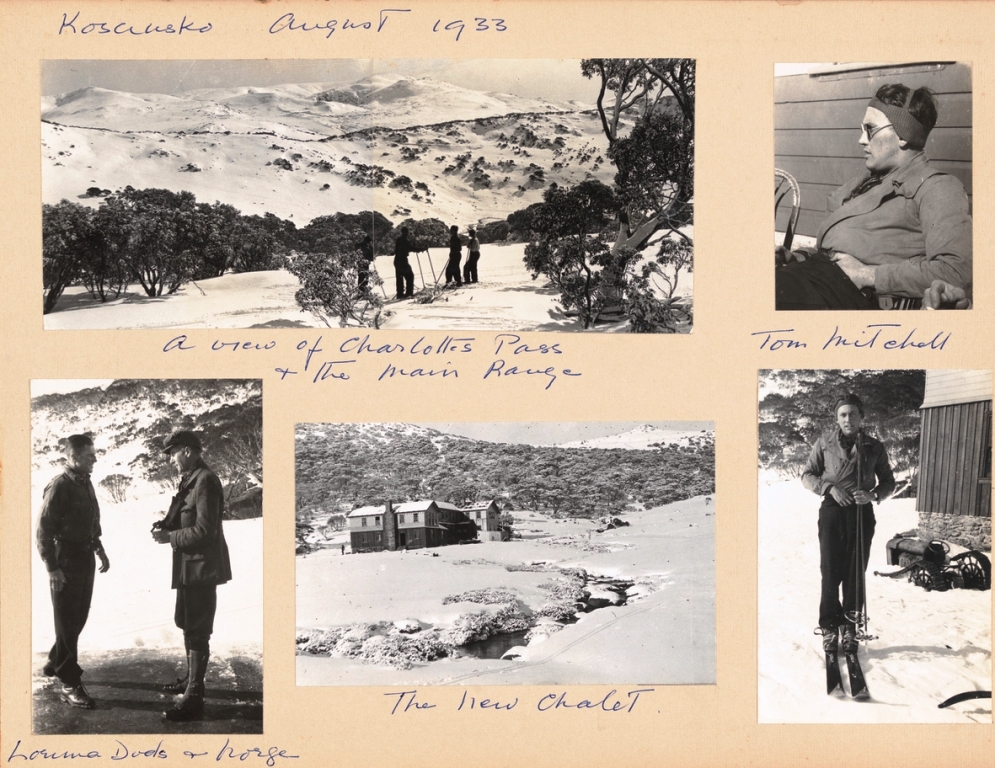
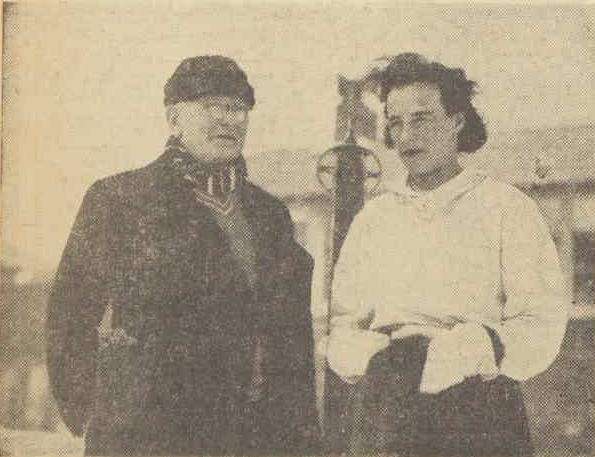 DR. AND MRS. BERTIE SCHLINK, who have been holidaying at Kosciusko and revelling in winter sports, are expected back any tick of the clock. Dr. Schlink and his wife are expert skiers. THE JOTTINGS OF A LADY ABOUT TOWN (1947, July 20). Truth(Sydney, NSW : 1894 - 1954), , p. 56. Retrieved from http://nla.gov.au/nla.news-article168784741
DR. AND MRS. BERTIE SCHLINK, who have been holidaying at Kosciusko and revelling in winter sports, are expected back any tick of the clock. Dr. Schlink and his wife are expert skiers. THE JOTTINGS OF A LADY ABOUT TOWN (1947, July 20). Truth(Sydney, NSW : 1894 - 1954), , p. 56. Retrieved from http://nla.gov.au/nla.news-article168784741 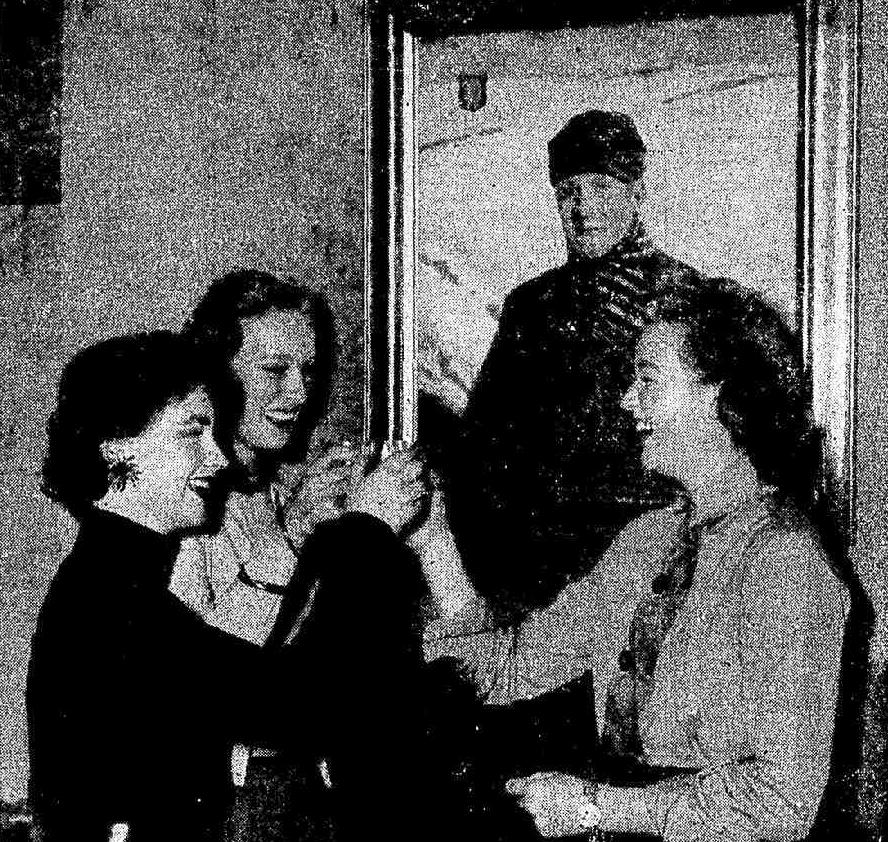
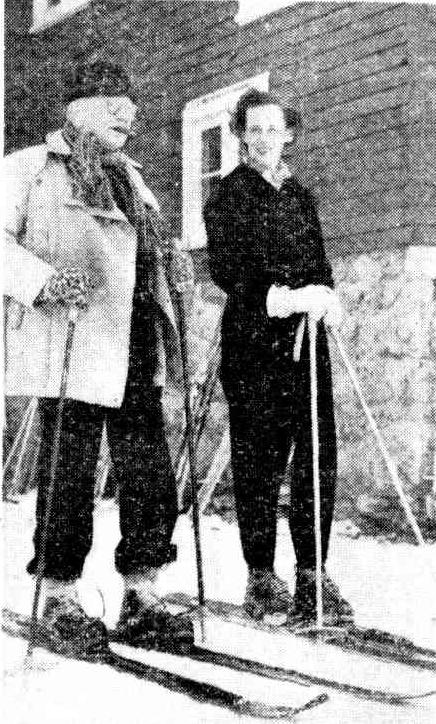
Charles Kerry passed away on May 26th, 1928:
MR. C. H. KERRY.
SUDDEN DEATH ANNOUNCED
Mr. Charles Henry Kerry, who was well known in business circles in Sydney, and who possessed large interests in the tin-mining industry in Siam and the Malay States, died at his residence, Cottesmore, Kurraba-road, Neutral Bay, on Saturday night. He was 70 years of age. Mr. Kerry was apparently in good health on Saturday, and spent the morning in the city.
Born near Bombala, Mr. Kerry at an early age entered the photographic profession. He built up a thriving business in the city, and retired in 1913, intending to devote the whole of his attention to his tin-mining interests. He was the founder of the Malayan Tin Corporation, of which he was chairman of directors at the time of his death. He was also chairman of directors of the Ratrut Tin Dredging Company, and of the Takuapa Company. He made two extensive tours of the East during the past three years.
Mr. Kerry took a keen interest in all branches of sport and nature study. He per-formed a considerable amount of exploration work on Mount Kosciusko many years ago, and was a prominent member of the Ski Club. The main course at Mount Kosciusko—the Kerry Course—was named after him. His exploration work, together with his photographs of Mount Kosciusko, contributed largely to the opening up of that winter resort. Mr. Kerry also played a prominent part in the opening up of the Jenolan, Wombeyan, and Yarrango-billy Caves. He was a prominent trout fisherman, and was one of the founders of the Sydney Gun Club, competing under the nom-de-plume of "Kosciusko."
Mr. Kerry is survived by Mrs. Kerry and one son, Mr. Marni Kerry, of Sydney.
The funeral will leave Kirby's Funeral Parlours, Elizabeth-street (near Liverpool-street) at a quarter past 2 o'clock this afternoon, for the Crematorium, Rookwood.MR. C. H. KERRY. (1928, May 28). The Sydney Morning Herald (NSW : 1842 - 1954), p. 12. Retrieved from http://nla.gov.au/nla.news-article16467831
OBITUARY
MR. CHARLES H. KERRY.
The funeral of Mr. Charles Henry Kerry, who was well-known in business circles in Sydney, took place yesterday afternoon, the remains being cremated at Rookwood. The Rev. J. F. S. Russell, of St. James' Church, King-street, conducted the service at the crematorium.
The principal mourners were Messrs. Marni Kerry (son), W. R. Kerry (nephew), and P. Vivian and V. C. Vivian (brothers-in-law). Others who attended included Messrs. E. S. Marks, M.L.A., Percy Hunter (manager in the Pacific for the Pacific Cable Board), H. J. Lambie (director) and J. C. Cocks (assistant, director) of the Government Tourist Bureau; D. Coombes (vice-president, Metropolitan Rifle Clubs' Union), Emblem (secretary, New South Wales Gun Club), F. G. Pratten (Allu-vial Tin, Malaya, Ltd.), H. G. Pratten, A. J. Thompson (Kodak Australasia, Ltd.), J. C. Cruden (Cruden Studios), R. D. Hartwell (F. O. Furner and Co.), W. E. H. Nicolle, G. W. Poole, and W. Graham (Poole and Steel, Ltd.), J. Fielding (J. Fielding and Co., Ltd.), Frank E. Tilley, Joseph Tomlinson, W. J. McCaghern (C. H. Smith and McCaghern), Eric F. Griffin (Philip Pring and Docker), William Tilley, Milton C. Kent, H. S. Hawkins, W. H. Watton, C. H. Baddeley, R. H. Spencer, W. A. Anderson, H. H. Cutter, A. A. McCoy, and F. Y. Wilson. OBITUARY. (1928, May 29). The Sydney Morning Herald (NSW : 1842 - 1954), p. 12. Retrieved from http://nla.gov.au/nla.news-article16468211
The Late Mr. Kerry.
PHOTOGRAPHER AND TIN MAGNATE.
One of the most alert men in Sydney was the late Charles Henry Kerry. His age at his death was 70, yet his quick gait and general appearance of agility suggested the spirit of youth. His career was remarkable Sydney knew him first 40 years ago as a photographer ability. He loved the out door life, and his neglect of his studio to enjoy it caused his friends to fear a business failure for him. As a matter of fact, however, it led to a fortune. He first attracted general attention by making known the winter beauties of Kosciosko. He was doubtless drawn to that region because he was born at Bombala, in the cold area of the south. His work with the camera did much to develop tourist business. He revel-led in the snow, becoming one of the first experts on the skis. His Kosciusko publicity was the earliest. The Tourist department, established later, acknowledged the aid thus received. This freedom from the restraint of the photographic studio led to enterprise in other directions. Mr. Kerry became interested in Malay tin deposits. That interest gradually grew until he was accepted as an authority, and he acquired a fortune. It is a coincidence that two Australian tin magnates, Mr. Pratten and Mr. Kerry, died during May. The Late Mr. Kerry. (1928, June 1). The Manaro Mercury, and Cooma and Bombala Advertiser (NSW : 1862 - 1931), p. 2. Retrieved from http://nla.gov.au/nla.news-article118987708
Please stay Safe this Snow Season
The NSW Police are asking all those heading to the snowfields this Season to drive to the conditions and ensure their vehicles are prepared, that they have a plan to stay 'Snow Safe'.
Southern Region Commander, Assistant Commissioner Peter Cotter APM, said police will be out and about throughout the season targeting road safety, anti-social behaviour and personal safety.
“Our priority is to keep people safe – on the slopes, roads, licensed venues and out and about in the alpine region,” Assistant Commissioner Cotter said.
“Those heading to the snow should drive to the conditions and exercise appropriate caution.
“Snowfield conditions can be more difficult to navigate so we’d like to remind everyone to prioritise safety on your journey – pay close attention to the roads, don’t get distracted and slow down.
“Our officers will do all they can to keep you safe to and from the snowfields, and regardless of whether you’re driving, riding, a passenger or a pedestrian, we urge you to help us achieve this.”
Monaro Police District Commander, Superintendent John Klepczarek APM, said local police efforts will be bolstered by additional resources.
“The population of our snowfields and surrounding towns increases exponentially during winter, and for local police, community safety is always the number one priority,” Superintendent Klepczarek said.
“We will have additional staff seconded to Jindabyne from other police districts who will support the work of our local police; expect to see them out and about on patrol.
“After two years of lockdowns and disruptions, we are expecting a huge season this year, and we want to make sure everyone has a great time – but not at the expense of the safety of others.”
Deputy Premier, Minister for Regional NSW and Minister for Police Paul Toole urged everyone to take extra care on the roads this snow season, with double demerits in place across the long weekend from today.
“The recent cold snap has ensured a great start to the season and we know it’s going to be a busy time on the roads,” Mr Toole said.
“It’s important we remember to plan ahead and allow additional travel time because getting to your destination safely is everyone’s responsibility.”
NSW Police are also urging hikers visiting the region to ensure their personal safety by submitting a Trip Intention Form and hiring a Personal Locator Beacon (PLB) before heading out into the national park.
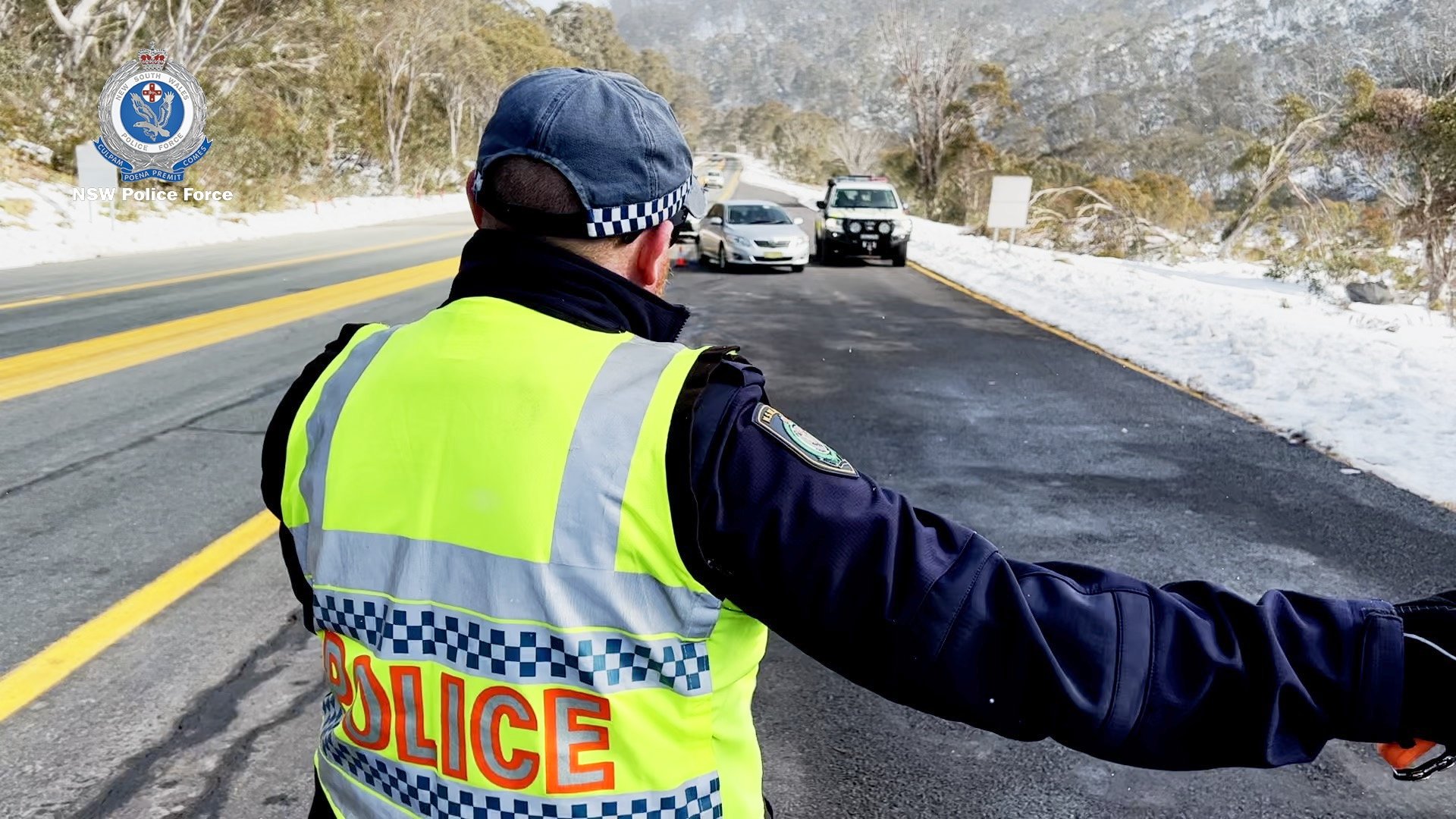
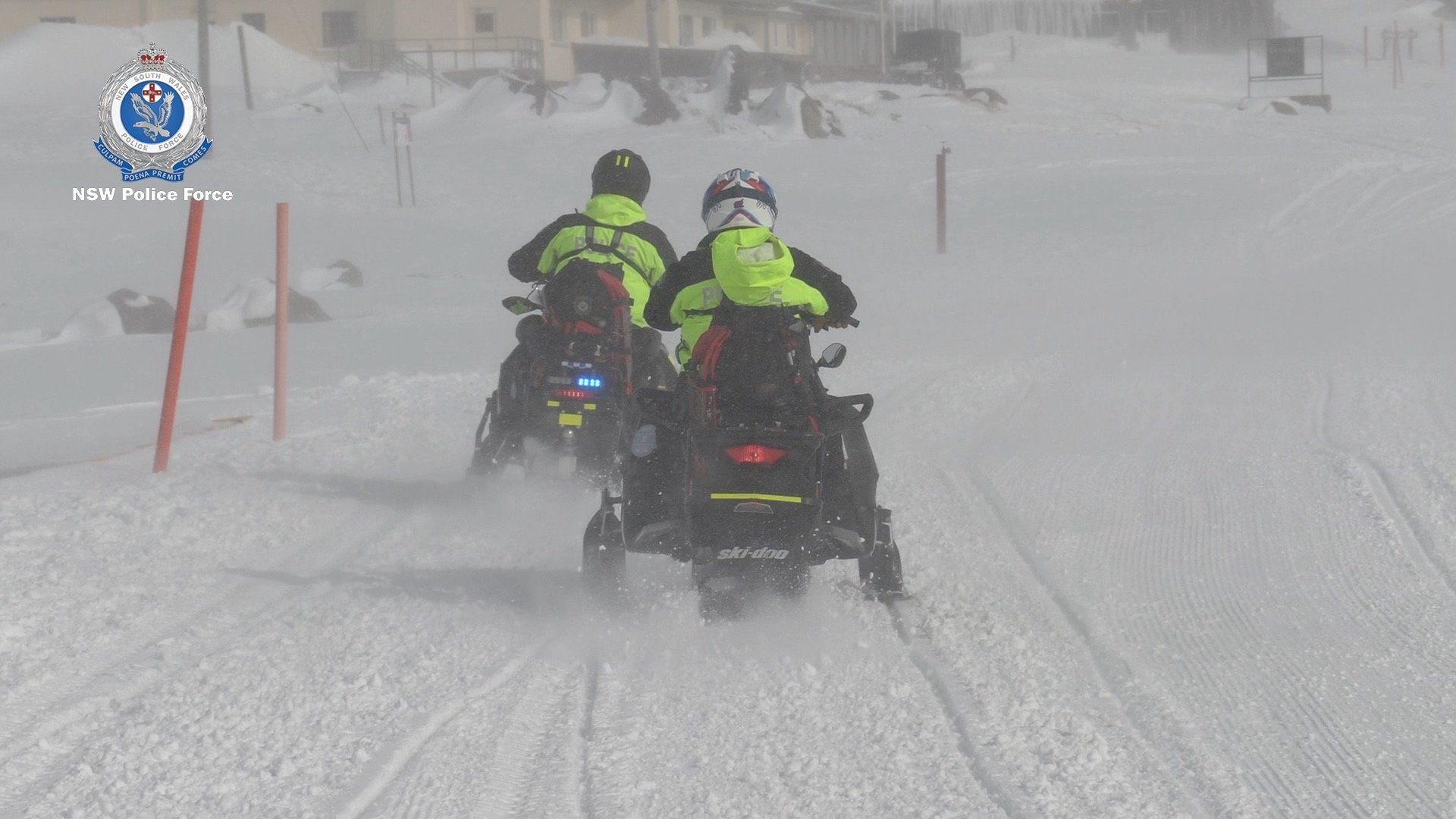
______________________________________________________________________________
And of course, in the meantime - let it snow, let it snow, let it snow!
Let's close with a poem that hearkens back to where tit all began:
The Demon Snow-Shoes (A Legend of Kiandra)
The snow lies deep on hill and dale,
In rocky gulch and grassy vale,
The tiny, trickling, tumbling falls
Are frozen 'twixt their rocky walls
That grey and brown look silent down
Upon Kiandra's shrouded town.
The Eucumbene itself lies dead,
Fast frozen in its narrow bed,
And distant sounds ring out quite near,
The crystal air is froze so clear,
While to and fro the people go
In silent swiftness o'er the snow.
And, like a mighty gallows-frame,
The derrick in the New Chum claim
Hangs over where, despite the cold,
Strong miners seek the hidden gold,
And stiff and blue, half-frozen through,
The fickle dame of Fortune woo.
Far out, along a snow capped range,
There rose a sound which echoed strange,
Where snow-emburthen'd branches hang,
And flashing icicles, there rang
A gay refrain, as towards the plain
Sped swiftly downward Carl the Dane.
His long, lithe snow-shoes sped along
In easy rhythm to his song;
Now slowly circling round the hill,
Now speeding downward with a will;
The crystals crash and blaze and flash
As o'er the frozen crust they dash.
Among the hills the first he shone
Of all who buckled snow-shoe on,
For though the mountain lads were fleet,
But one bold rival dare compete,
To veer and steer, devoid of fear,
Beside this strong-limbed mountaineer.
'Twas Davy Eccleston who dared
To cast the challenge: If Carl cared
On shoes to try their mutual pace,
Then let him enter for the race,
Which might be run by anyone -
A would-be champion. Carl said "Done."
But not alone in point of speed
They sought to gain an equal meed,
For in the narrow lists of love,
Dave Eccleston had cast the glove:
Though both had prayed, the blushing maid
As yet no preference betrayed.
But played them off, as women will,
One 'gainst the other one, until
A day when she was sorely pressed
To loving neither youth confessed,
But did exclaim - the wily dame,
"Who wins this race, I'll bear his name!"
These words were running through Carl's head
As o'er the frozen crust he sped,
But suddenly became aware
That not alone he travelled there,
He sudden spied, with swinging stride,
A stranger speeding by his side;
The breezes o'er each shoulder toss’d
His beard, bediamonded with frost,
His eyes flashed strangely, bushy browed.
His breath hung round him like a shroud.
He never spoke, nor silence broke,
But by the Dane sped stroke for stroke.
"Old man! I neither know your name,
Nor what you are, nor whence you came:
But this, if I but had your shoes
This championship I ne'er could lose.
To call them mine, those shoes divine,
I'll gladly pay should you incline.
The stranger merely bowed his head -
"The shoes are yours," he gruffly said;
"I change with you, though at a loss,
And in return I ask that cross
Which, while she sung, your mother hung
Around your neck when you were young."
Carl hesitated when he heard
The price, but not for long demurred,
And gave the cross; the shoes were laced
Upon his feet in trembling haste,
So long and light, smooth polished, bright.
His heart beat gladly at the sight.
Now, on the morning of the race,
Expectancy on every face,
They come the programme to fulfil
Upon the slope of Township Hill;
With silent feet the people meet,
While youths and maidens laughing greet.
High-piled the flashing snowdrifts lie,
And laugh to scorn the sun's dull eye.
That, glistening feebly, seems to say -
"When Summer comes you'll melt away:
You'll change your song when I grow strong,
I think so, though I may be wrong."
The pistol flashed, and off they went
Like lightning on the steep descent,
Resistlessly down-swooping, swift
O'er the smooth face of polished drift
The racers strain with might and main.
But in the lead flies Carl the Dane.
Behind him Davy did his best,
With hopeless eye and lip compressed:
Beat by a snow-shoe length at most,
They flash and pass the winning-post.
The maiden said, "I'll gladly wed
The youth who in this race has led."
But where was he? still speeding fast,
Over the frozen stream he pass’d,
They watched his flying form until
They lost it over Sawyer's Hill,
Nor saw it more, the people swore
The like they'd never seen before.
The way he scaled that steep ascent
Was quite against all precedent,
While others said he could but choose
To do it on those demon shoes;
They talked in vain, for Carl the Dane
Was never seen in flesh again.
But now the lonely diggers say
That sometimes at the close of day
They see a misty wraith flash by
With the faint echo of a cry,
It may be true; perhaps they do,
I doubt it much; but what say you?
by Barcroft Boake
Appears in: The Bulletin vol. 11 no. 608 October 10 1891 periodical issue pg. 18
Barcroft Henry Thomas Boake (March 26 1866 – May 2 1892) was an Australian poet. Born in Sydney, Boake worked as a surveyor and a boundary rider, but is best remembered for his poetry. In July 1886 Boake joined E. Commins, a surveyor, and had experience as a field-assistant, working for some time in the Monaro (New South Wales). After spending two years in the surveying camp Boake was disinclined to return to the city, took service as a boundary rider, and worked in New South Wales and Queensland. In May 1890 Boake joined W. A. Lipscomb, a surveyor, and remained with him until the end of 1891. About this time he began to send verses to The Bulletin, which were published.
His poems were all published posthumously in 1897 by A.G. Stephens in a collection titled "Where the Dead Men Lie: and Other Poems". "Where the Dead Men Lie" was the most famous of his poems, which described the tragedies Australians faced during the 1891–93 depression, and to which some biographers attribute his death due to being unable to get work and earn his way. Scottish-Australian poet and bush balladeer Will H. Ogilvie (1869–1963) penned The land of dumb despair (1898) in memoriam to Boake.
references - extras
- TROVE - The National Library of Australia; The Manaro Mercury, and Cooma and Bombala Advertiser (NSW : 1862 - 1931) + others
- Powerhouse Museum, Sydney
- State Library of New South Wales
- The Cowan ‘Creek’ + Lovett Bay Heights Tracks: Some Notes From The Pages Of The Past With Early Photos
- Herbert Henry Schlink
- The Oaks - La Corniche
- Pittwater's Tropical Fruits: From The Middle Of Winter
- Australian Alpine Club Heritage pages
- Perisher History Organisation
- Charles Maclurcan - The Bilgola Connection With The Beginnings Of Radio In Australia
The poet Barcroft Boake wrote a poem about skiing at Kiandra, entitled "The Demon Snow Shoes: A Legend of Kiandra". Banjo Paterson referenced Kiandra in his poetry - as in A Mountain Station (The Bulletin, 19 December 1891). Patrick White's first novel, Happy Valley (1939), has Kiandra thinly disguised as the township of "Kambala".
In 1927, William Hughes, a member of the Club, together with four members of the Ski Club of Australia made the first historic ski traverse from Kiandra to the Hotel Kosciusko. Their eventful journey is retold in Klaus Hueneke's book "Kiandra to Kosciusko" and was commemorated by 150 ski tourers in 1977 in an event organised by the Kosciusko Huts Association.
The Kiandra courthouse closed as a police station in 1937, and was for a time used as a private residence, before becoming the Kiandra Chalet (until 1953) and later the Kiandra Chalet Hotel. The owner of the Chalet ran a ski rope tow. The Chalet closed in 1973 and the building became a Roads Depot building.
Australia's first T-Bar was installed on Township Hill in 1957, but in 1978, Kiandra's ski lift operations re-located permanently to nearby Selwyn Snowfields. The T-Bar remained in operation at Mt Selwyn until the 2009 ski season when it was replaced by the Township Triple Chair (retaining the name "Township" in reference to the Kiandra Township hill run).
Percy Hunter born 1874
Parents: Mary Ellen Mother's family name at birth SMITH
Father's Name: David Walkenshaw Hunter, 26 Mar 1838, 6 Mar 1912, 73, son of David & Katherine; born. Fife, Scotland; they married in 1865
HUNTER. — March 6, 1912, at the residence of his son, "Sorento," Ben Boyd-road, Neutral Bay, David Walkenshaw Hunter, late of Victorian Railway Department. (dearly beloved husband of M E Hunter, aged 74 years. Family Notices (1912, March 7). The Daily Telegraph (Sydney, NSW : 1883 - 1930), p. 6. Retrieved from http://nla.gov.au/nla.news-article239158817
HUNTER.—The Funeral of Mr. DAVID W. HUNTER will leave Sorento, Ben Boyd-road, Neutral Bay, THIS (Friday) MORNING, at 10 o'clock, for Gore Hill Cemetery. Mrs. P. KIRBY and SON, Ltd. 7 Elizabeth-street, city. Tel., 875 Central. Family Notices (1912, March 8). The Sydney Morning Herald (NSW : 1842 - 1954), p. 7. Retrieved from http://nla.gov.au/nla.news-article15315756
Father's death: HUNTER DAVID W3361/1912 parents: DAVID KATHERINE ST LEONARDS
Mother's death: HUNTER MARY E18707/1923 parents: SAMUEL SARAH ST LEONARDS
his death:?: HUNTER PERCY19130/1970 DIED AT KILLARA AGED 96 YRS ST LEONARDS
" B.H. FANTASTIC PLACE"
MILLIONS CLUB MAN GIVES IMPRESSIONS
"Broken Hill is a fantastic place," said the vice-president of the Sydney Millions Club (Mr. T. A. Ferguson) today: "After being here for 15 hours I am beginning to change my preconceived opinions of the city and its people."
Mr. Ferguson said that in most cases preconceived opinions were wrong and after this visit- the first in about 30 years-to Broken Hill the 17 members on the trip would talk with greater authority about the city, its industry, industrial amenities, working conditions, and the people who live here.
The Millions Club was formed on October 16, 1912, by Mr. Percy Hunter, who followed the trend of American Millions Clubs. The aim at that time was to increase the population of Sydney to one million.
The - ardent spirits who joined Mr. Hunter soon expanded the club's aims to incorporate patriotism and immigration with a view to inducing, millions of people to settle not only in New South Wales but in Australia. The club's first president was Sir A. Rickard, and the present president is Sir John McLaren, a former High Commissioner for, Australia in London.
Today the club has about 1200 members from the Sydney metropolitan area, interstate, and overseas.
Mr. Ferguson said the club has its own building ("Millions House") in Rowe Street, Sydney, and apart from providing all the amenities of a business-men's club members interest themselves in sporting activities. The N.S.W. Ski Club was an offspring of the Millions Club, which also interests itself in golf, tennis, bowls, chess, billiards, cards, and other activities. ... " B.H. FANTASTIC PLACE" (1954, March 23). Barrier Miner (Broken Hill, NSW : 1888 - 1954), p. 2. Retrieved from http://nla.gov.au/nla.news-article49420678
THE TRAVELLER.
FROM KIANDRA TO KOSCIUSKO.
(BY OUR SPECIALREPORTER.)
Being desirous of seeing the famed town of Kiandra, rendered historic from the fact of its being the scene of a great gold rush in the sixties, and the highest town in New South Wales, the writer made an early start from the Yarrangobilly Caves, for I wished to reach Adaminaby the same day. After a ride of fourteen miles, crossing Long Plain en route, Kiandra is reached ; but ' what a change is there, O my Queen.' It is hard to realize that this place once vibrated with the hum of busy life ; that seven thousand adventurous diggers had pitched their tents here and had punctuated the hills and fiats with holes in search of the golden treasure. No, it could not be the same place surely. The bark of a dog announces the advent of all strangers into tie town; a few goats browsing on the patways look up for a moment as we (my horse and I) enter and stare at us, no doubt wandering why we have intruded on their domain. A couple of cows effectually bar the main street, and lazily drag themselves out of the way. The only sign, indeed, of animal life is the aforesaid canine, who seemingly resents our intrusion more than anyone by the way he barks at us. And yet, as I have said, this place once resounded with the merry laughter of thousands of diggers. It was all surface sinking here, and seven thousand ounces of gold used to leave Kianda every week, which was the site of an ounce of gold a week per man.
The town now consists of a few straggling weatherboard tenements, two hotels, and stores and other places of business ; but the most imposing building is the police station, in charge of Mr. Scott. This is a handsome structure built of the basaltic rock that abounds in the hills around. Although apparently no life about the place, there is a good deal of business done in this town, and the post and telegraph office, lately ia charge of Mr. Burke, at Tumut, but now under the supervision of Mr. Crear, of Sydney, who is a most obliging officer, transacts a great deal of business. There are also a School of Arts and debating club. Mining is not carried on very extensively, but the following tributers in the New Chum are said to be doing well : — Messrs. J. Burke, J. and W. Pattinson, Hildred, Forrester, Larkin, Reekman, Ostrium, Davenport and Wood. I hear they are doing great work, but as they were not sluicing at the time of my visit, and were merely blocking out, I did not go up. I heard some expended here, but without result.
KIANDKA SNOW-BOUND FOR SIX MONTHS.
It is not, I was informed, an unusual thing in the winter time for the people here to be snow-bound for six months of the year. And no wonder, when I inform my renders that the town is 4000 feet above the sea level. Great preparations are consequently made for this eventful period. All the stock are taken to the plains, and woe betide those who are tardy in getting them away. Sufficient meat is killed and salted down to last over the winter. Last year, however, there was an unusually heavy fall of snow, which kept the people snowbound for a longer period than usual, and there was very nearly a famine in the place. The only means of getting anything was on snow-shoes. The snow piled up over the houses and a tunnel had to be made in the snow to get into Bradley's Hotel, and others had similar experiences. The snow was sixteen feet high in the main street. Everything too was covered as with a Avhite garment. One man living out of the town had to get out through the chimney every morning to clear the snow away from his door to open it, and he frequently got a visitor down the chimney in the shape of a wallaby.
Snow-shoeing is the great amusement here in the winter time. The snow-shoe is made of mountain ash, care being taken to see that the grain runs right. They are about six feet long and three inches wide and the foot is fixed in the centre with leather. The shoes are steamed and made to turn up at the end. At first they are difficult to manage, and many a one measures his or her own length in the snow ; but the majority of the people here are experts and go down the hills at a rapid pace.
Parties are sometimes formed at Adaminaby to go to Kiandra on the shoes. The mails have to be brought in on snowshoes, and the traveller will notice posts all along the road leading into the town which serye to show him the way when the road is covered with snow. A most unique and solemn spectacle was witnessed here last winter. It was the burial of a young fellow, the coffin containing the remains having to be carried on snow-shoes ; and all the mourners also followed in procession gyrating about, and although only a short distance had to be travelled it -was some hours before they reached the cemetery — the whole scene being of the most picturesque description. And now I must abruptly take my readers on to Adaminaby, for my time and space are too limited to describe the scenery on the way, which in some places is remarkably pretty.
Suffice it to say that I arrived at ' Cubmurra,' the homestead of Mr. Russell, where I had been assured I would be hospitably entertained. And my friends did not advise me wrongly, for kinder people than Mrs f nd Miss Russell and ' Mick' it would be hard to find ; and I am greatly indebted to the latter for the loan of a horse while I £_ave my own a spell. ' Cubmurra' consists of about 10,000 acres. The Eucumbene River tuns through the property on which all the other sons are settled — namely, Edward, William, Mark, and John, the last named having a very nice place, and doing exceedingly well. Two of the daughters have been educated at the Cooma convent, and they play and sing nicely. The family at the homestead are very busy, now that the butter factory has started at Adaminaby. They milk about fifty cows every morning, finishing about half-past eight, when 'Mick' runs the milk into the factory.
And this brings one to Adaminaby, a very pretty little town, built on the rise of a hill and. overlooking a sweep of upland and valley and meadow pastures which must look very picturesque in the springtime. Indeed, the appearance of the country here is entirely different to any I have seen on this side, and bears a striking resemblance to Broadmeadow, near Melbourne. Besides the usual business places, there are three churches, the Catholic, Church of England, and Presbyterian. Seeing a handsome stone building occupying the best site on the hill, with crosses on it, I naturally stroiled over to it, thinking it was the Catholic church, and I was surprised to find that it was the Presbyterian kirk. The Catholic church is lower down and is a very high wooden structure. Mass is celebrated here by the Cooma priest about every five weeks. At one time it used to be every Sunday, but I presume the Adaminaby people got so good that they did not require Mass so frequently. There is a post and telegraph office here, a fine wooden building, in charge of Mr. Wadde and a great deal of business is done. Mr. Gillies is the local schoolmaster, a gentleman who by his high attainments is, I think, worthy of a better school. He has taken his degree of B.A., and he has in hand now a matriculation and junior class, having been successful last year in getting the only one he sent up through the junior examination, Master d Harnett, his daughter having previously passed. Master Harnett and Miss Mary Gillies are now being coached for the next matriculation examination, and Miss M'Keachnie, T. Gillies, and H. Allen are being sent for the junior.
The town has had its equilibrium upset lately by the establishment of a butter factory by the Monaro Creamery Company.. Adaminaby was wont previous to the advent of the factory to be in bed till all hours. It had only sheep and cattle to look after for the past forty or fifty years, and there was no necessity to get up. Now all this is changed. The factory has rudely disturbed its slumbers. And consequently I found it like a bear with the measles.
The imperious voice of Carl Cederwald, the manager, says All the milk must be in by 10 o'clock of a morning, and there is much growling thereat. It did not see why it should not stroll down to the factory at 3 in the afternoon, and; have a yarn and so forth. The time has come,, how-' ever, when the people will have to be up and doing, and this fact has been brought home, 'to the Aclaminaby people these Iast few years. As far as I could see there was only one thing they could depend on to bring in a little money— namely, fat cattle. It is impossible to grow wheat or maize, or barley, or any other crop with the exception of oats, owing to the frosts. And now that there is no sale for cattle they would have been thrown on their beam ends, when fortunately this; factory comes to save them from disaster. Of course it would have been much better had, they started the factory themselves on the co-operative principle. But even as' it is the affair must be looked upon as a boon, and the saving of the place. The factory building is one of the best I have seen, with fine spacious rooms lined with Baltic pine, concreted floors, and fitted up with the latest machinery, including the Lance Babcock tester and patent strainer. The manager, Mr. Cederwald, seems to thoroughly understand his business, and is ably assisted by Mr. Hassell. So far the people have only been using the beef cows, the factory only being opened in January. But when I state that £3G0 was distributed amongst them the first month it will be readily imagined what the result will be, when they come to improve their cows. I would like here to give the experience of the Victorian farmers in this regard, but want of space precludes ire. As, however, I intend shortly delivering a lecture on the whole subject of butter factories and creameries— which will no doubt be published— our readers will get an idea of what they are doing in the sister colony.
They have the Alpha Separator at the Adaminaby factory, which can put through 380 gallons an hour. The cost of the factory was £700. There are also creameries started by the company at Boconnoo, Cattegat and Bolera, in charge of Messrs. Brooks, James Kelly and A. W. Hassell respectively. The company puts through 2000 gallons a day, there being 56 suppliers, Bolera's and Boconnoo's share being 600 gallons each, and Cattegat 300. The following is a daily average of, some of the suppliers and their tests. They are of course small, as winter is approaching :-- F. Russell, 60 gallons, test 3.4 ; G Goodman, 36- gallons, 3.8; Jas. Heely, 13 gallons, 3.0 ; Jas. Holsten, 34 gallons, 3.4 ; M. J. Russell, 309 gallons, 3.6; A. Carter, 45 gallons, 3.4; G. Melville, 40 gallons, 4.0 ; J. O! Connor, .50 gallon?, 3.4; J. Thomas, 20 gallons, 3.0; Mark Russell, 25 gallons, 3.0 ; J. Dunn, 20 gallons,' 3 8; G. Clark, 20 gallons, 3.2; J. O'Neill, 18 gallons;. ,. 3.2; .J. Lorker, 50 gallons, 3.8; N. O'Neill, 40 gallons, 3.8 ; B. M'Mahon, 38 gallons. It is anticipated that next spring .the supply will.be doubled. I think on the .whole the butter factory will be a great success, as all' kinds of root crops can be grown here, which -will be a great factor in feeding stock.
Whilst on the Monaro I had a good look around the country, and although I did not go to Kosciusko, I got within sight of its snow-clad summit. I called on Mrs. Delany and family, most estimable and hospitable people, who have about 10,000 acres of land, and who have gone in almost exclusively for cattle and horses, and have in consequence got on well. They have a very pretty , homestead, which is almost hid in the wealth of ^ foliage and willow trees that surround it. 1 also called on the Messrs. Harnett, of Eucumbene, | who have had unfortunately to contend against great losses in sheep, 13,000 having died on them in two years. Mr. Laurence and Mr. John Harnett have lived all their lives on this place, and are greatly esteemed and respected by everyone.
Another place I must not forget to mention is that of Mr. J., O'Connor, one' of the most practical farmers in Adaminaby. He milks about fifty cows everyday, mostly crosses with Devons and Durhams, and intends to work beef and milk together. His Devon cows are a beaiitiful lot of animals, and are in splendid condition. I partook of the hospitality of Mr. and Mrs. O'Connor for an evening, and they have a very pretty place reflecting great credit on Mr. O'Connor, who built it all himself. I must also before concluding thank Mr. and Mrs. M'Manus, the principal storekeeper here, who has just built a new store, a very extensive building. I also had the pleasure of meeting Mr. O'Rourke Mrs. M'Manus's father, who is one of the oldest residents in the district. I must now take my leave of Monaro for the present, KILLEEVY. THE TRAVELLER.. (1895, April 13). Freeman's Journal (Sydney, NSW : 1850 - 1932), p. 17. Retrieved from http://nla.gov.au/nla.news-article111109333
Killeevy was John A McIntyre, son of the late Michael and Margaret McIntyre of Melbourne. Michael McIntyre had been Inspector of Roads and Bridges in Victoria, who died early, leaving his widow with five young children, including John, who became a journalist. Mrs McIntyre herself died in Melbourne on Christmas Day 1899. After early years working for an Albury newspaper and other Victorian journals John McIntyre went to Sydney and joined the Freeman's Journal. After some years as their travelling representative he left Sydney and bought the Nagambie Times in Victoria. Later he sold that newspaper and acquired the Express at Peak Hill NSW with effect from 1 January 1909. During that period he spent some years on the executive of the Country Press Association, but increasing ill health saw his gradual withdrawal from active community involvement. He died at Peak Hill on Wednesday 16 April 1919 due to heart failure following a severe dose of influenza. His widow survived him, but there were no children from the marriage. - Tom Campbell. 6 July 2014 from: https://australiancatholichistoricalsociety.com.au/wp-content/uploads/2020/01/ACHS_August2014NewsletterWeb.pdf
Trip of the Alpine Club
(By Telegraph from One of the Party.)
BERRIDALE, Monday Afternoon.-The members of the New South Wales Alpine Club, who visited the Kiandra snowshoe races last Monday, came out over the mountains on Tuesday. The return of the-recent cyclonic, storm brought with it terrible hail and snow the whole of the day; but the party safely negotiated the journey on their snowshoes, reaching Adaminaby the same evening and Jindabyne on Thursday. One of the members (Mr. W. S. Macalister) had a rough experience on a horseback trip. In taking a short cut through the mountains for the purpose of picking up the material necessary for the contemplated Kosciusko trip, he encountered very heavy ; snow storms, and eventually became completely hemmed in with deep drifts.
The horse knocked up; and not desiring to leave the beast to perish, Mr. Macalister drove and dragged him through the snow, and made for a miner's hut on the Boogong track. Night came on, and while crossing the head of a deep gully filled with soft snow, and unable to see where they were going, both horse and man ell over the edge into the drift below. Macalister was underneath, but in the struggle that ensued to free himself, the horse trod on him very heavily. Though injured, he was not incapacitated, and managed, after tremendous exertions, to, safely fight his way to the hut. His horse was also pulled out, and brought along to the shelter of the homestead.
After resting for a few days Macalister, with two of the Sydney party, undertook to open up communication with Mr. Wragge's Observatory on Kosciusko, where Mr. Bernard Ingleby, one of the observers, has been alone for the past fortnight. His two companions had visited Jindabyne, and being unable to return during the recent heavy storms, were camped in the Crackenback Valley, waiting for a break. Having decided to accompany the Sydney party back, a start was made on Friday.
Horses were taken up to Crackenback Gorge as far as snow would permit, and a camp made for the night. On Saturday the ascent was commenced at 7 o'clock. The journey was long, and travelling difficult, and early in the afternoon Jensen, one of the Observatory assistants, began to show signs of weakness, consequent on the fearful exertion of climbing in the deep snow. As the hour was growing late, and the summit still many miles off, it was felt that trouble was ahead. This was verified when later on Jensen completely collapsed. He was supported on either side, and literally carried along. He earnestly begged to be allowed to lie down and sleep; and, to prevent his doing so, which would have been fatal, coaxing, entreaty, and even violence had to be used to keep him awake. Every few yards he fell down, and could not even attempt to rise again. The. position was trying, and most perilous, but by 8 o'clock the party somehow managed to reach the Observatory with their now almost insensible burden. Had a fog rolled over the mountains there is no doubt the party would all have been lost.
The temperature during the night fell to 38deg below freezing point (ground reading). The return on Sunday was easily effected by the Sydney men, who were all expert snow-shoers, and Jindabyne was safely reached the same night. Trip of the Alpine Club, (1898, August 13). Australian Town and Country Journal (Sydney, NSW : 1870 - 1919), p. 42. Retrieved from http://nla.gov.au/nla.news-article71316322
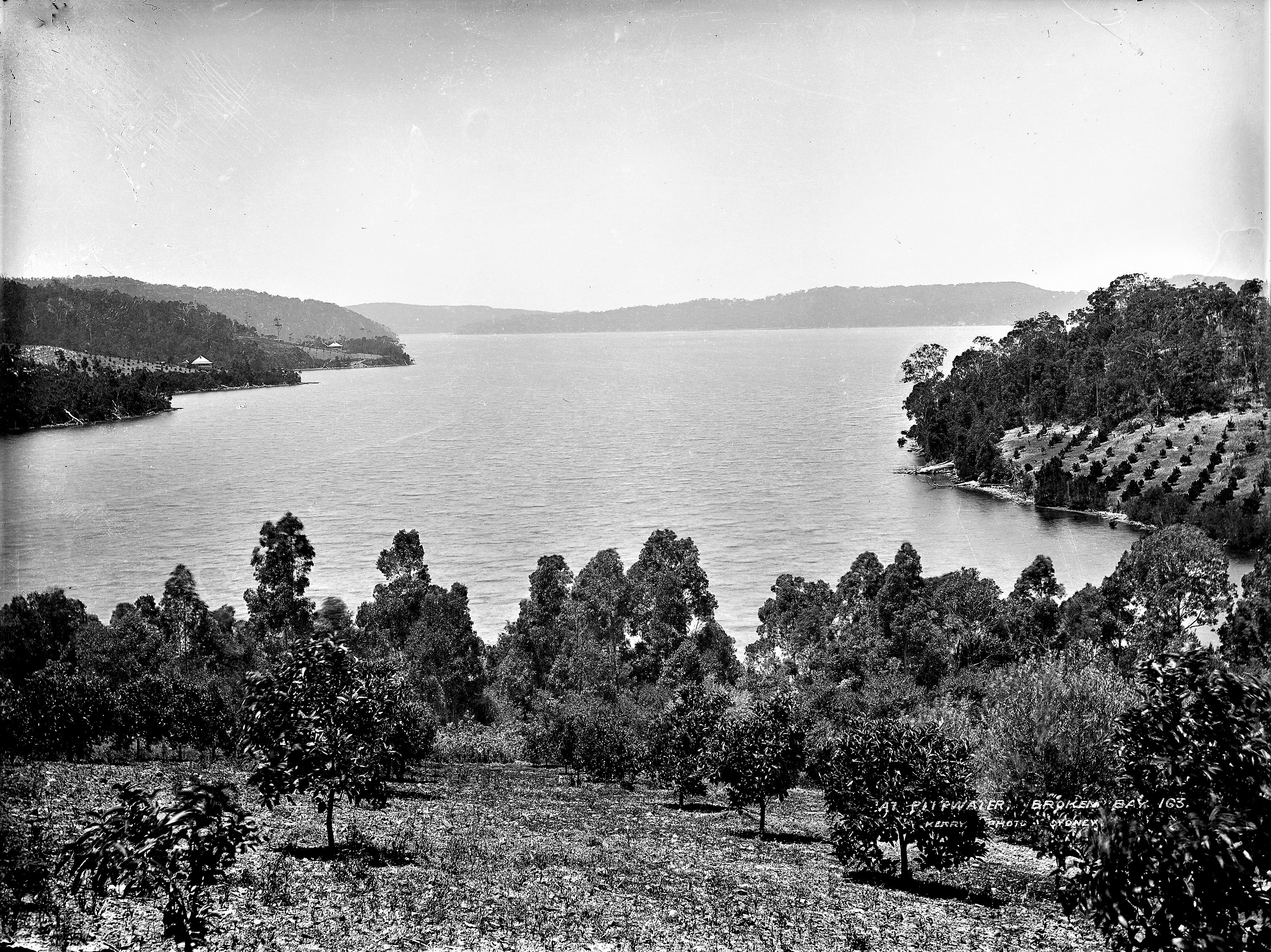
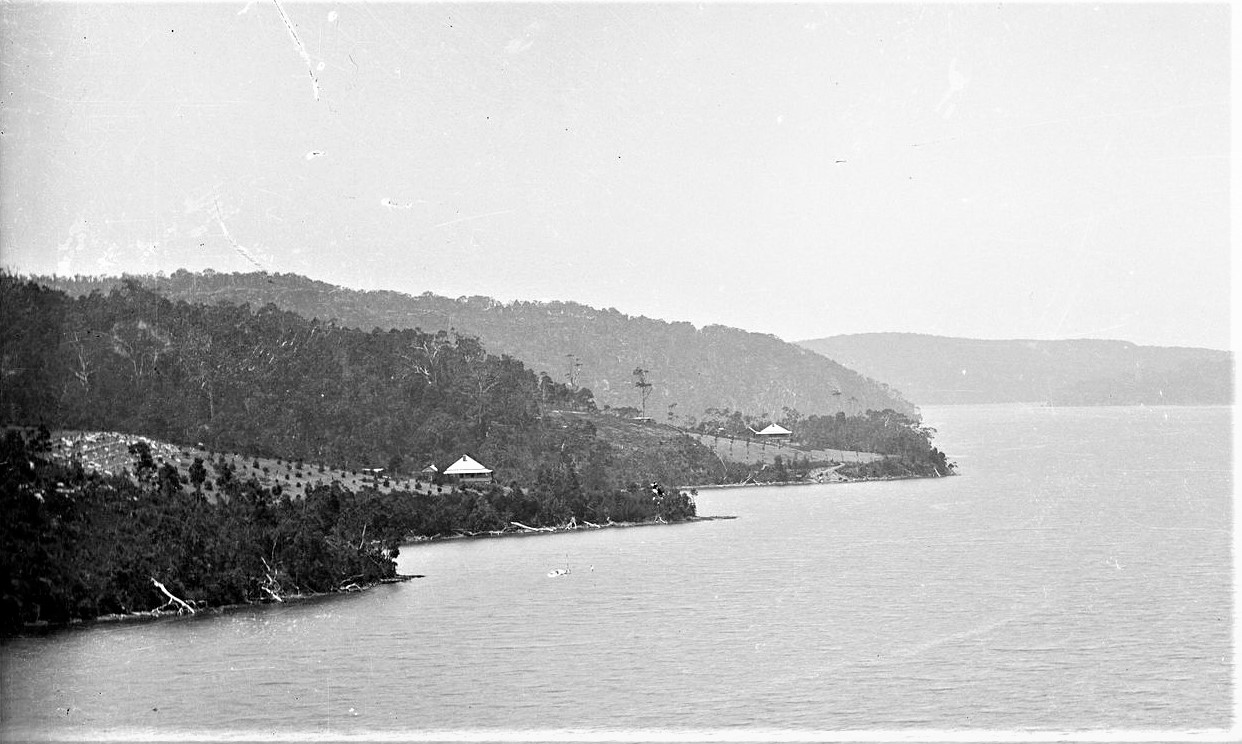
Lovett Bay circa 1883-1887, by Charles Kerry & Co. part of the Powerhouse Museum's Tyrrell collection, and section from to show homes/orchards around Towlers' Bay
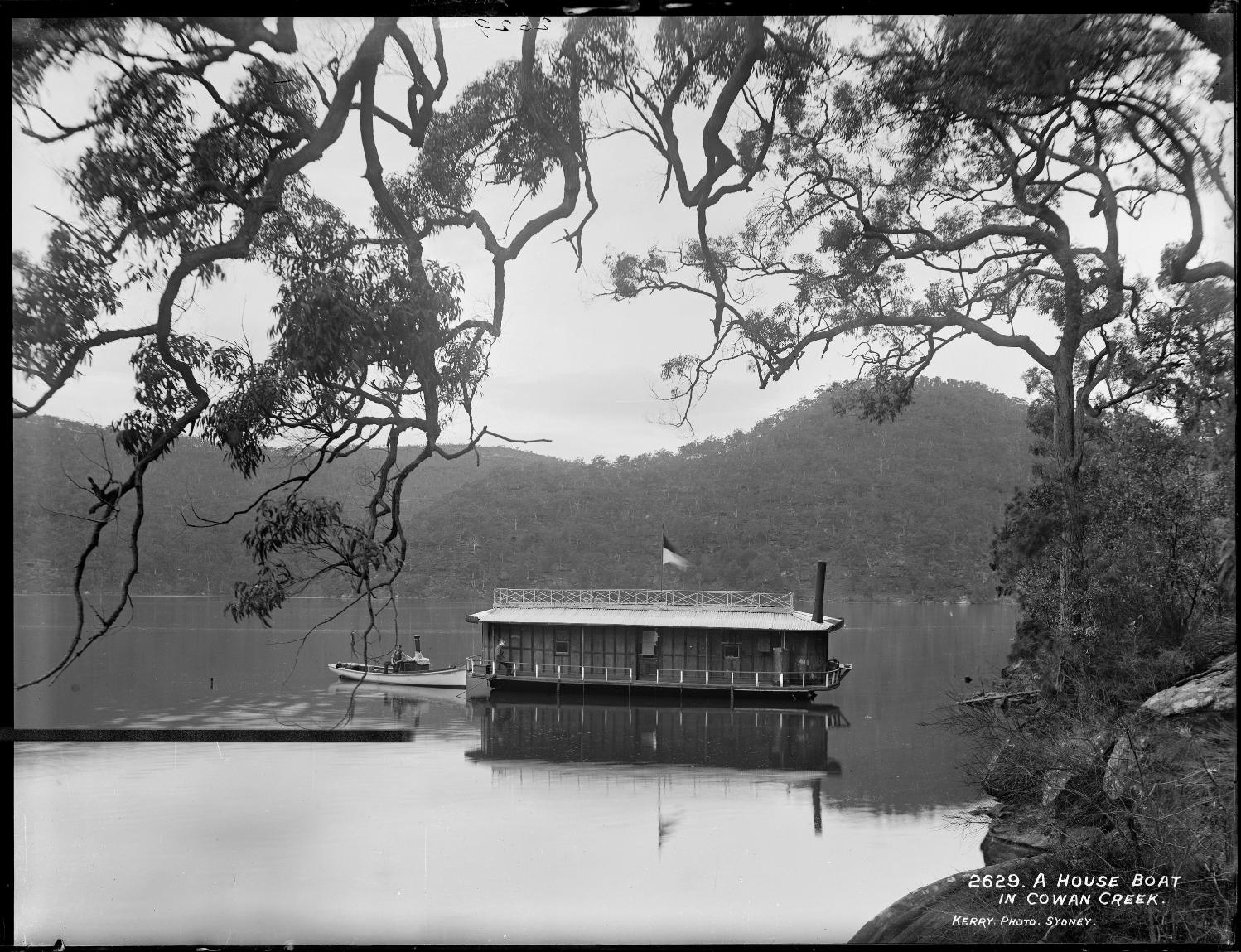
Glass plate negative of the houseboat 'Wonderland' and steam launch 'Kuring-Gai', Cowan Creek, near Sydney, c.1900 by Kerry and Co - courtesy Powerhouse Museum, Tyrell collection;
This image from a glass plate negative was used in several postcards produced by Kerry and Co. in the early 1900s. The photograph depicts the houseboat, 'Wonderland', on Cowan Creek north of Sydney. The chimney on the right probably served the kitchen range. At the outside end of the boat is a wooden box and a small platform with a wash basin, probably used for gutting fish. Nearby is a water tank which is connected to the gutter around the roof. It is likely that guests used a wash basin in front of the fire for their ablutions as the water tank was not large and the roof area catchment modest.
Posing on the other end of the boat is a well-dressed gentleman with a van dyke beard. He may be one of the Windybank family who has visited the boat for some important reason. Astern of the 'Wonderland' lies a neat, small steam launch, 'Kuring-Gai', with a boatman awaiting the gentleman's pleasure. The steam launch 'Kuring-Gai' is typical of many small power craft of the pre-internal combustion engine period. Such craft remained in regular use until as late as the first decade of the 1900s and some worked well beyond. - Graeme Andrews OAM, Museum of Applied Arts and Sciences volunteer under the supervision of Margaret Simpson, Curator, August 2016